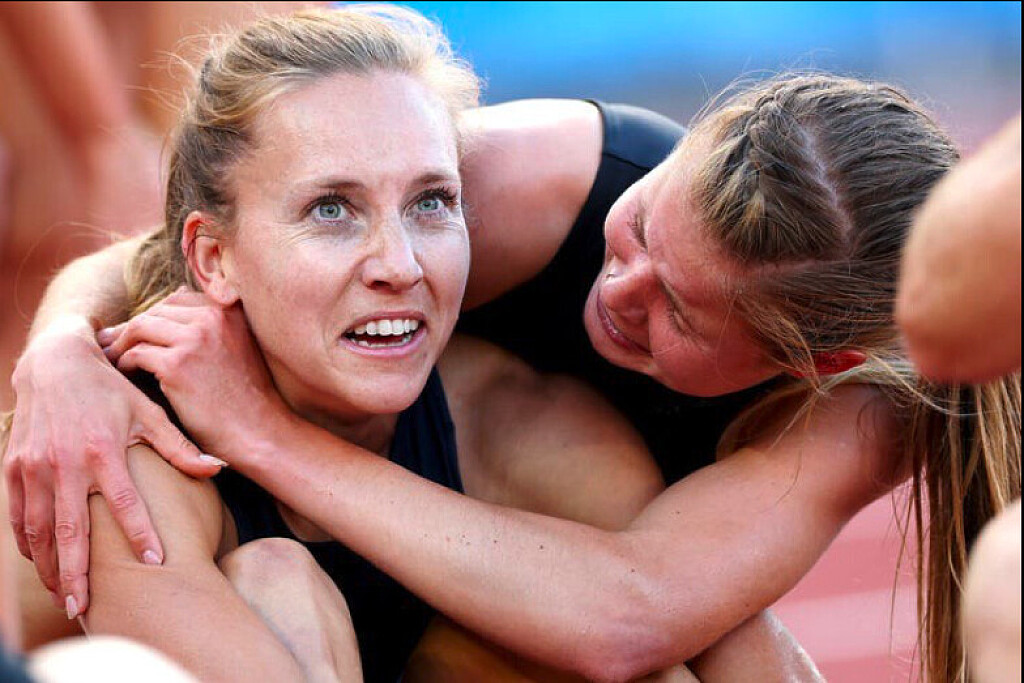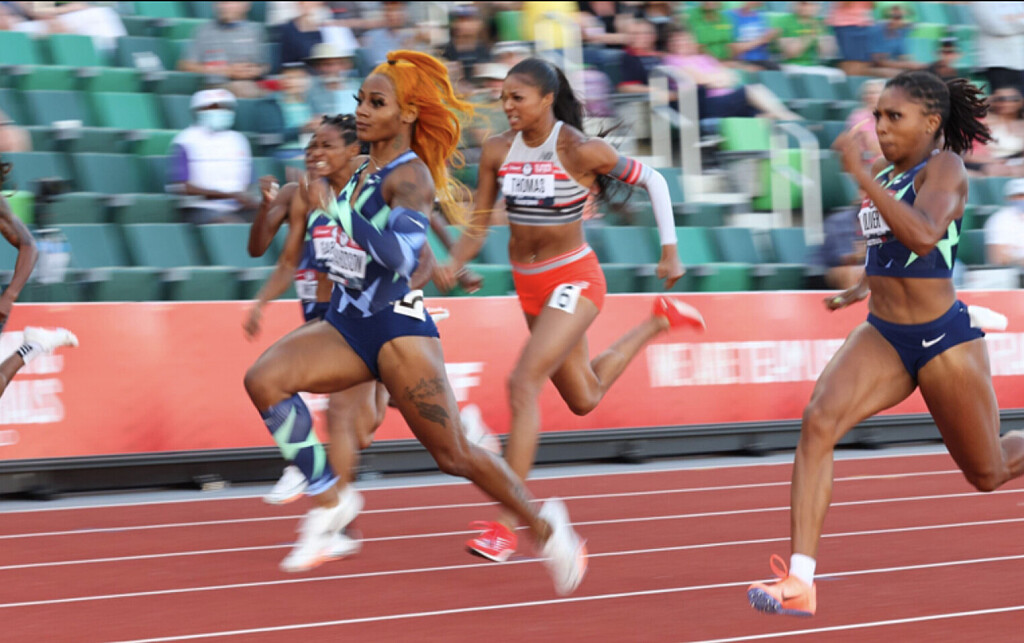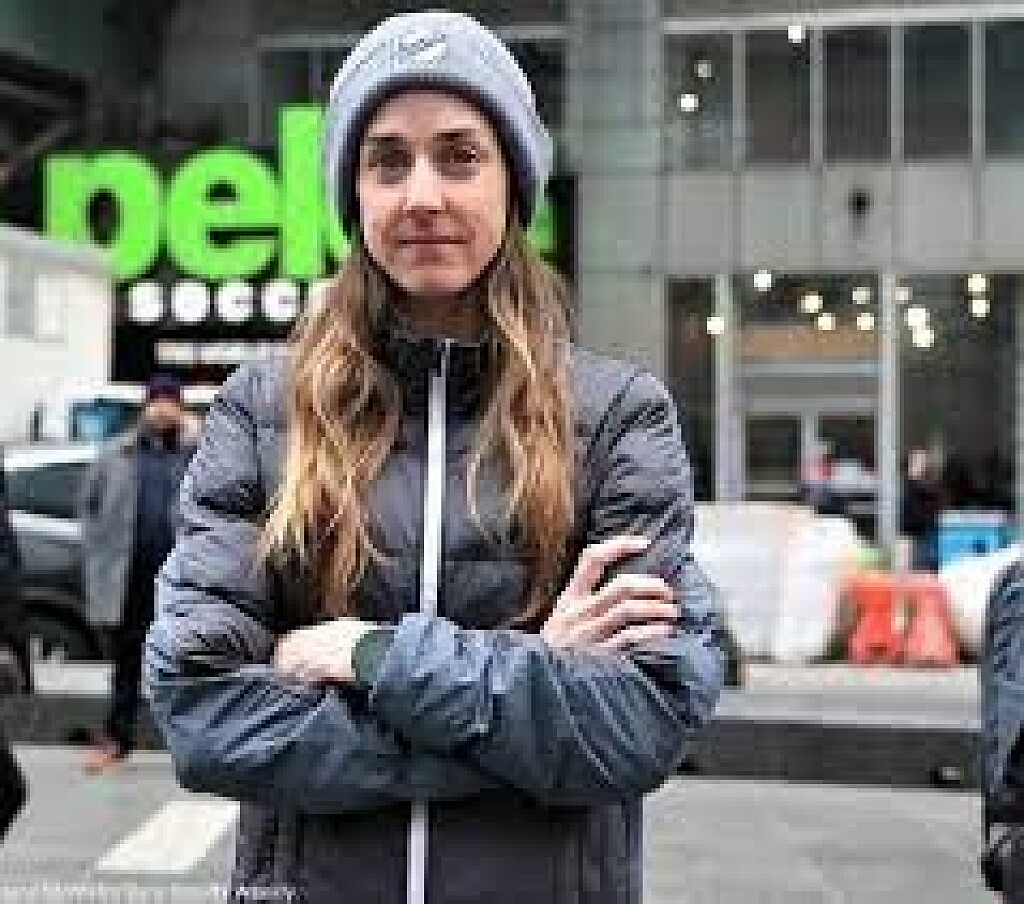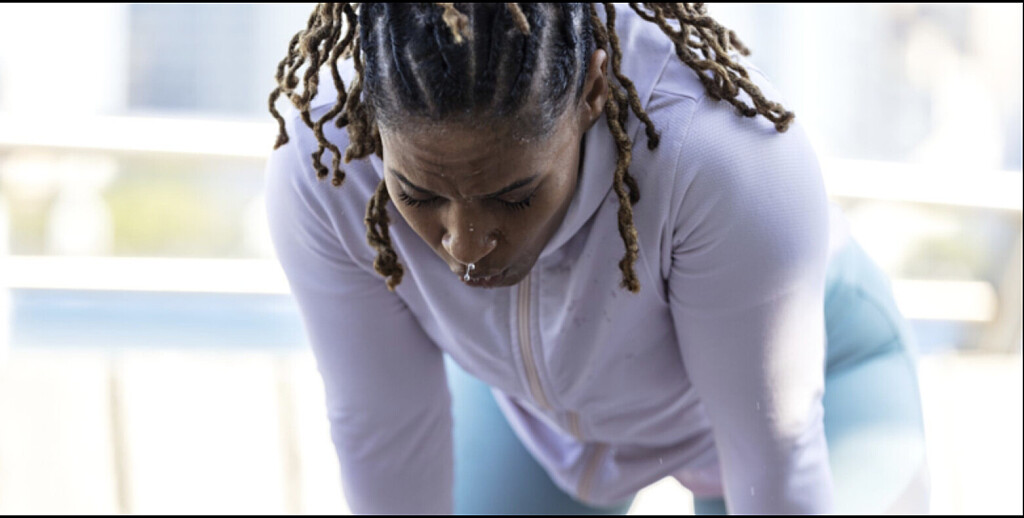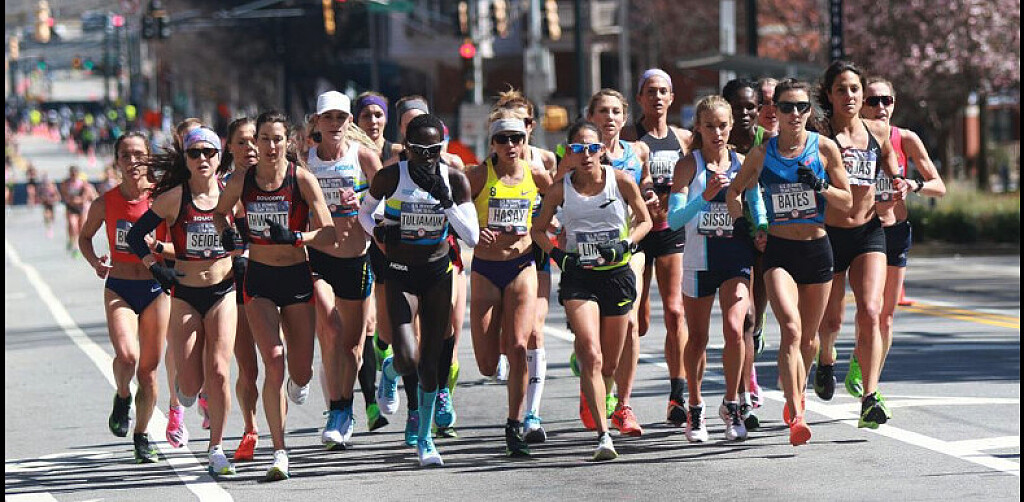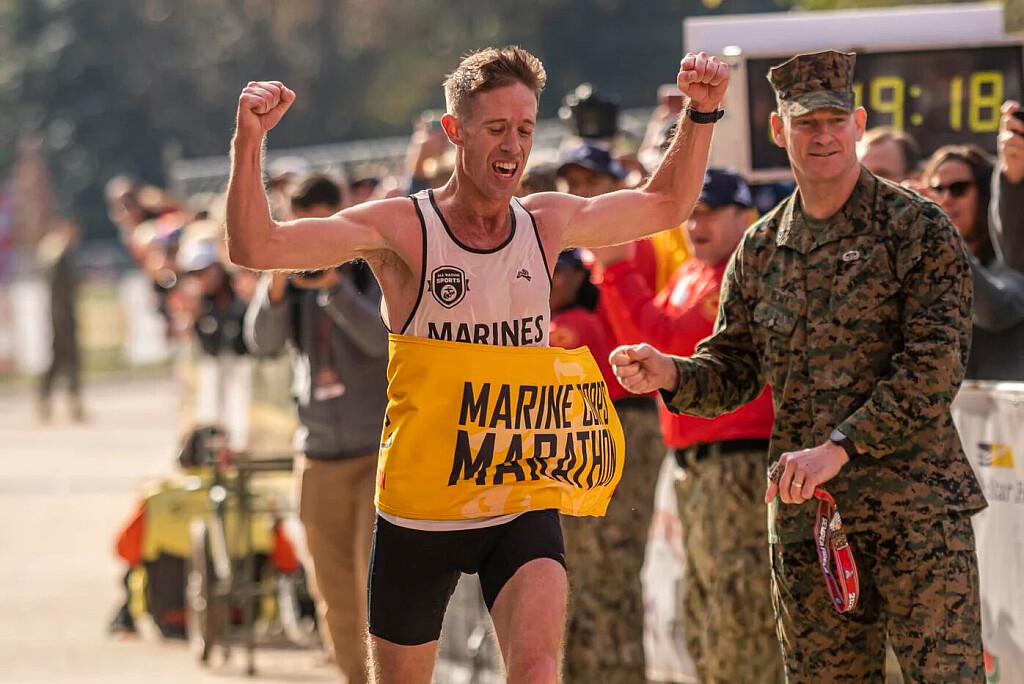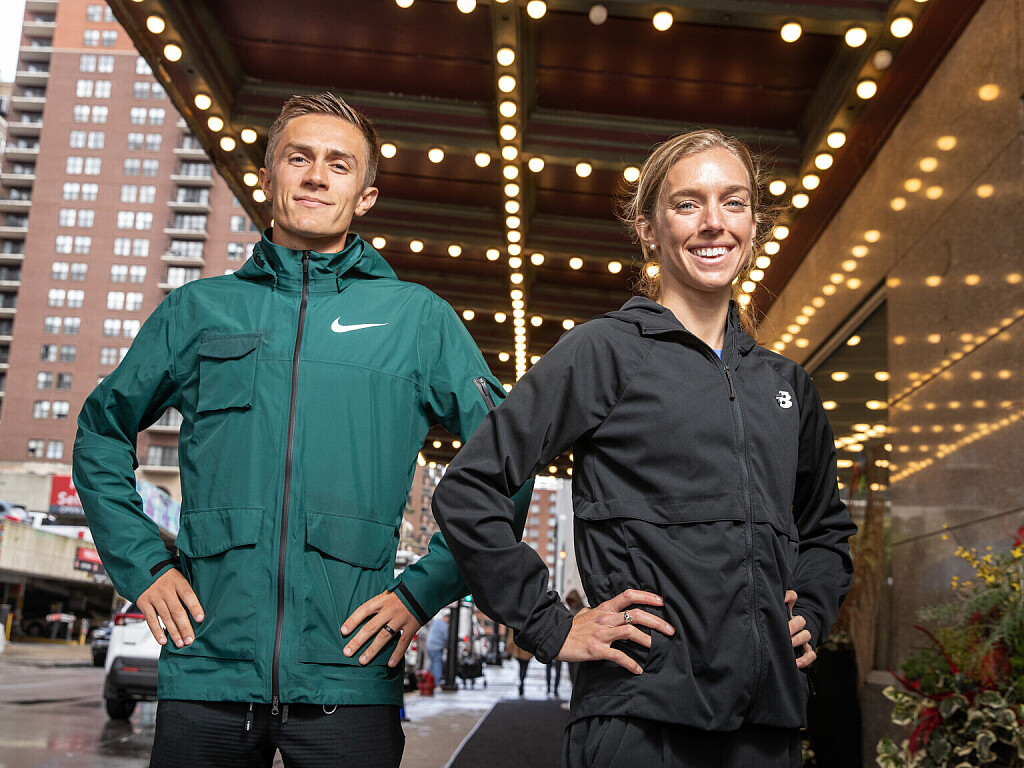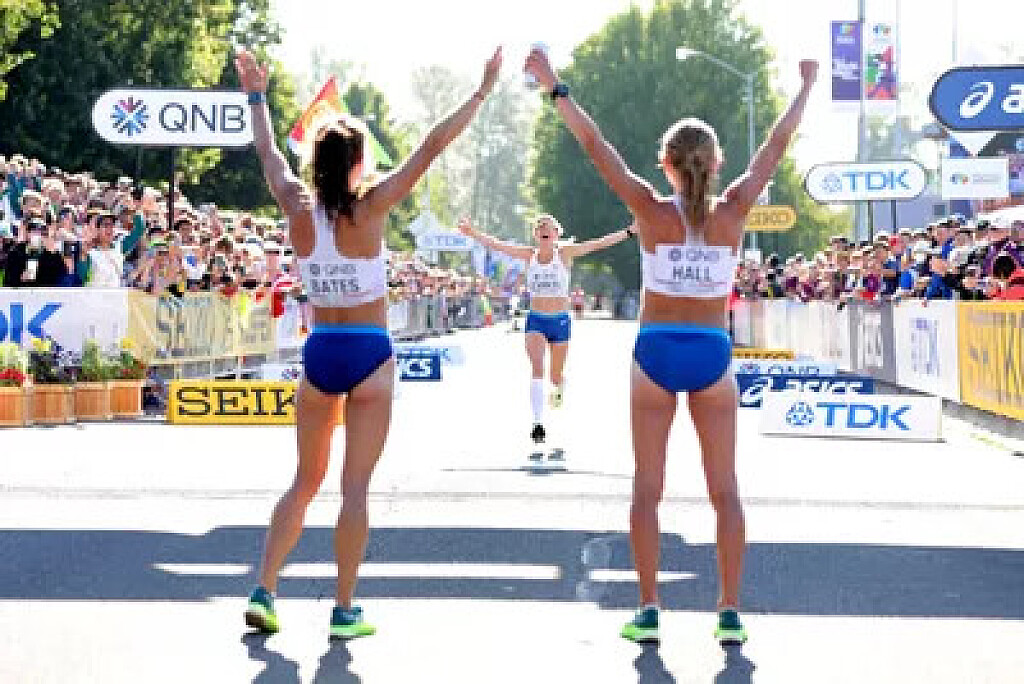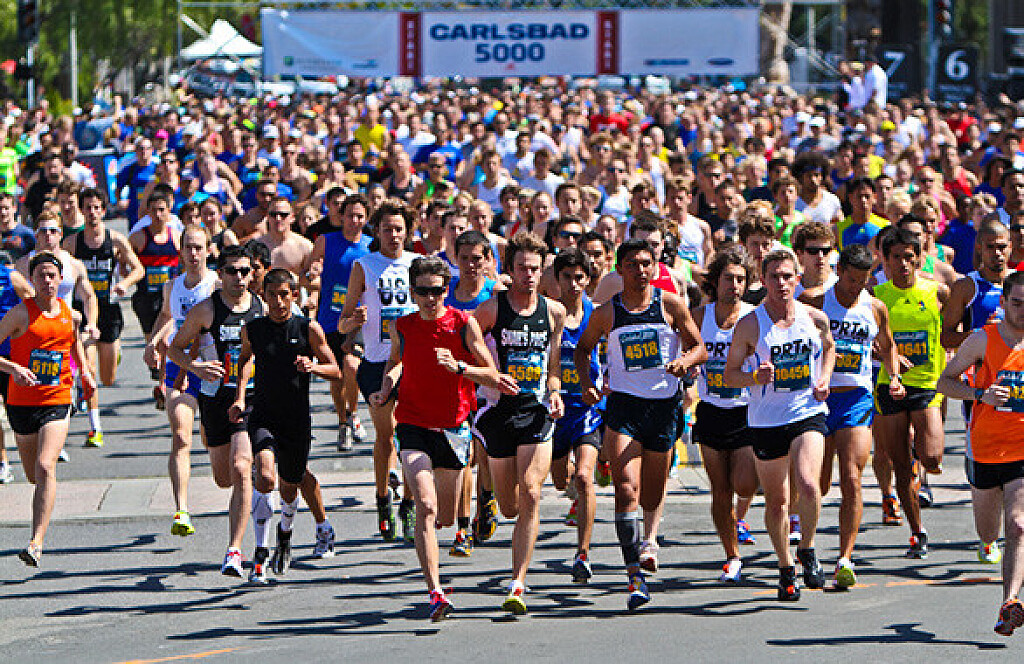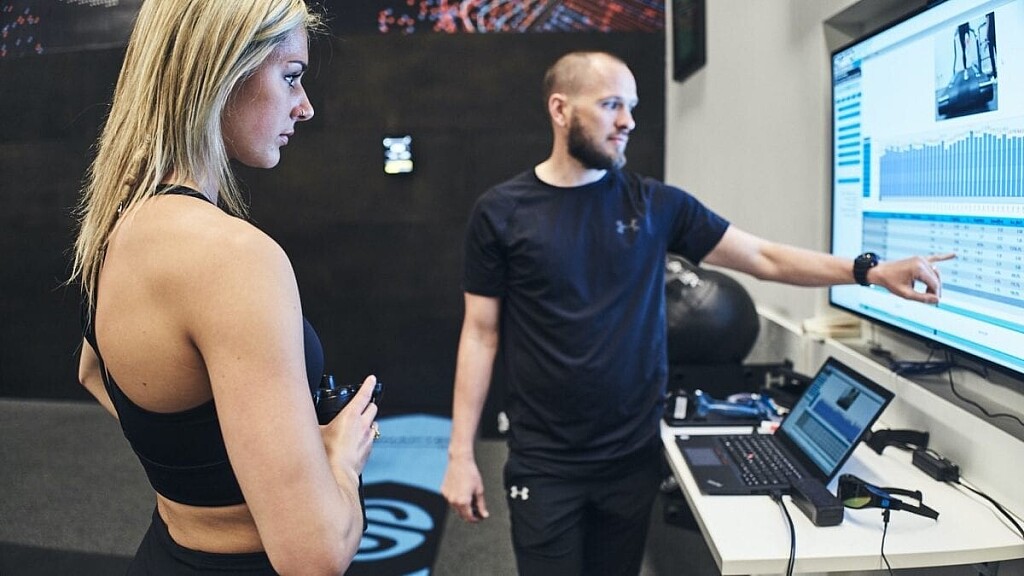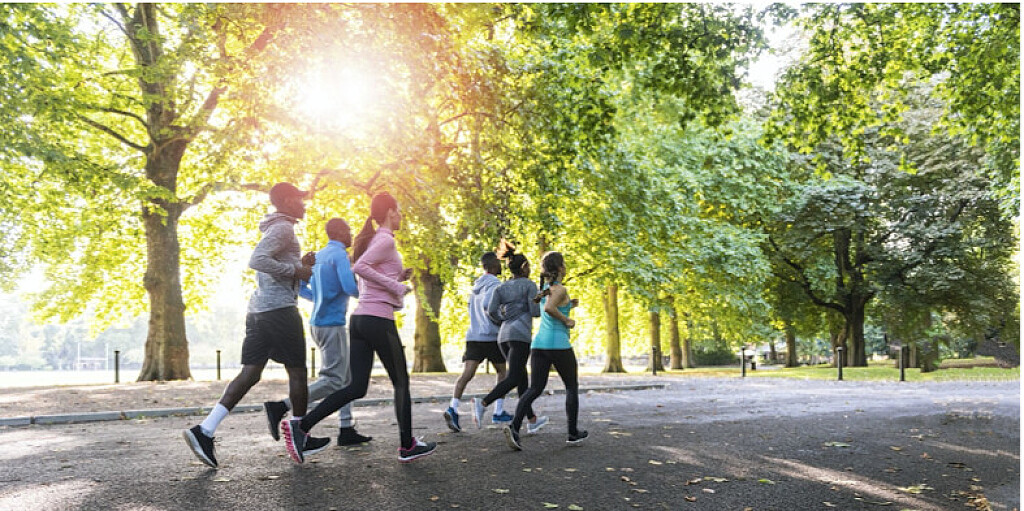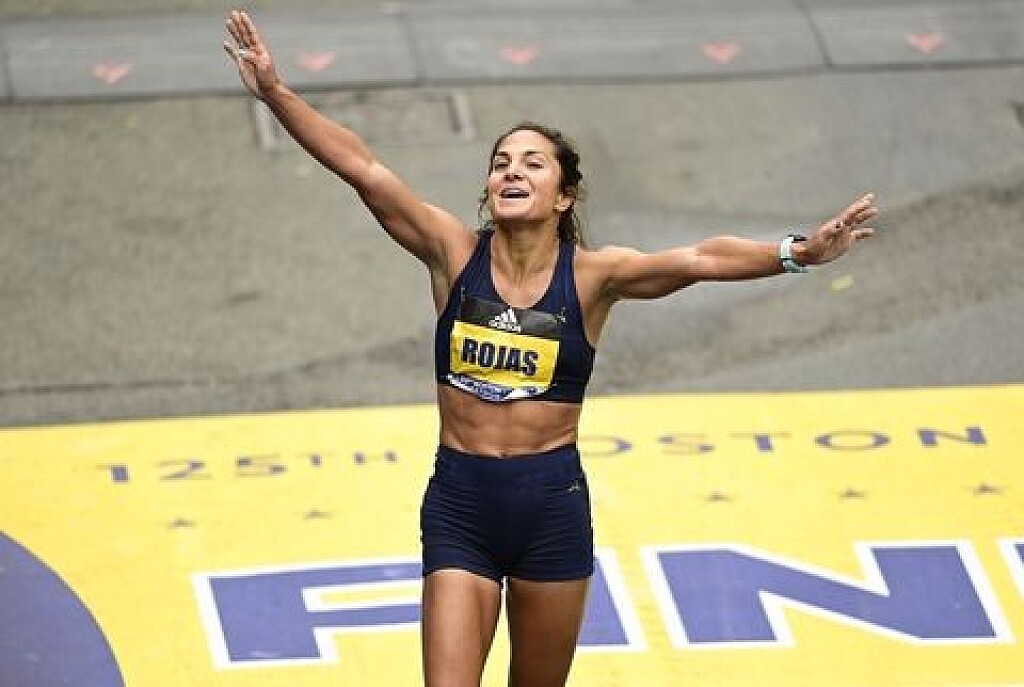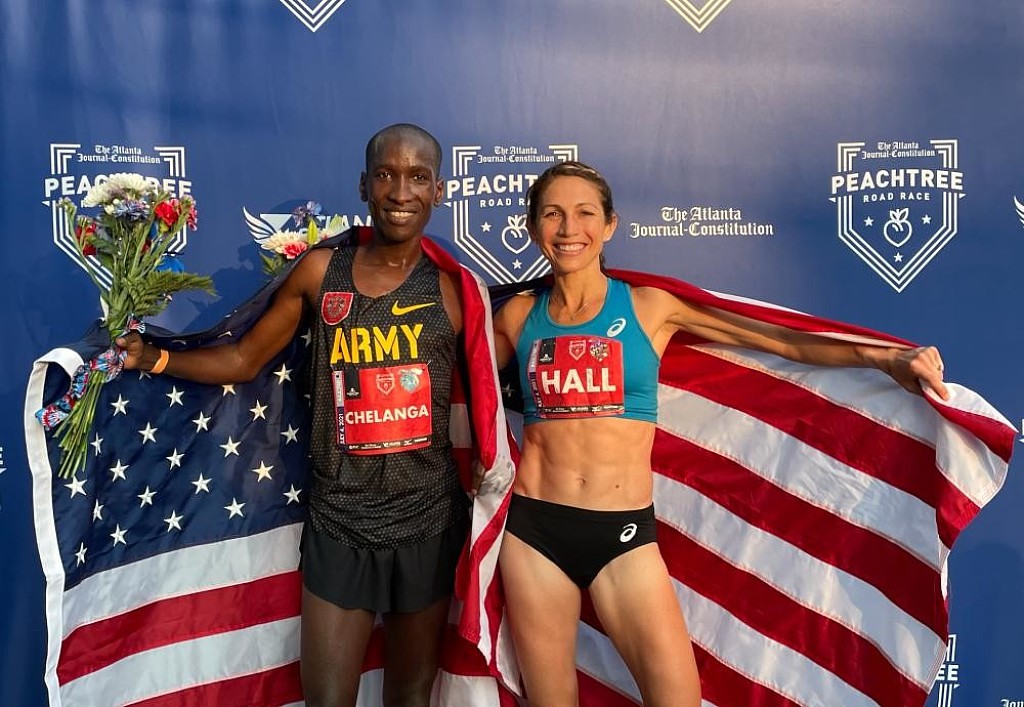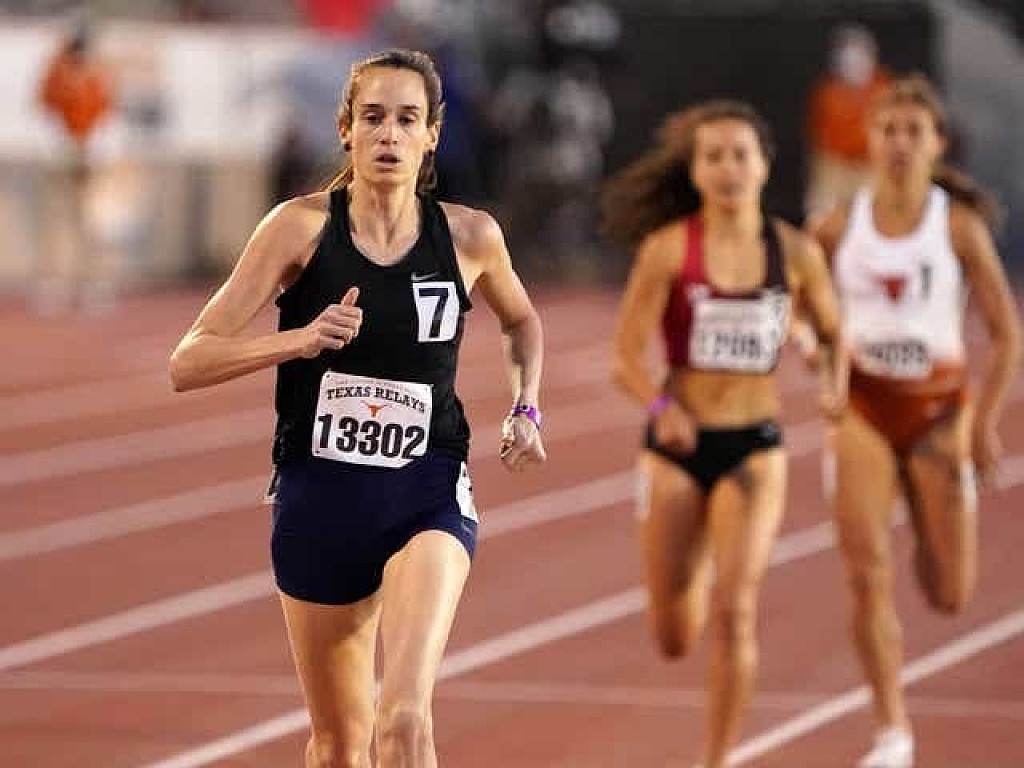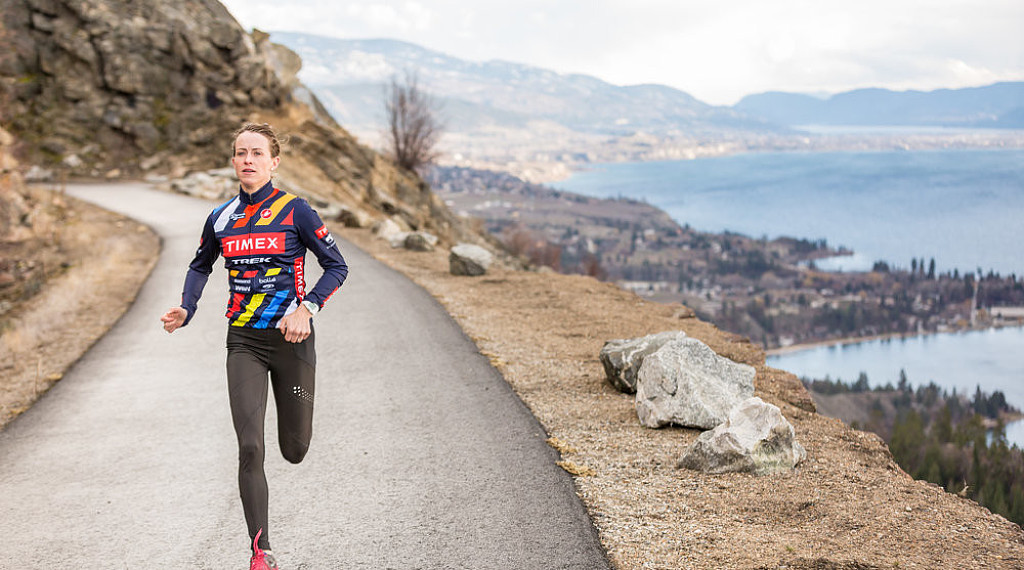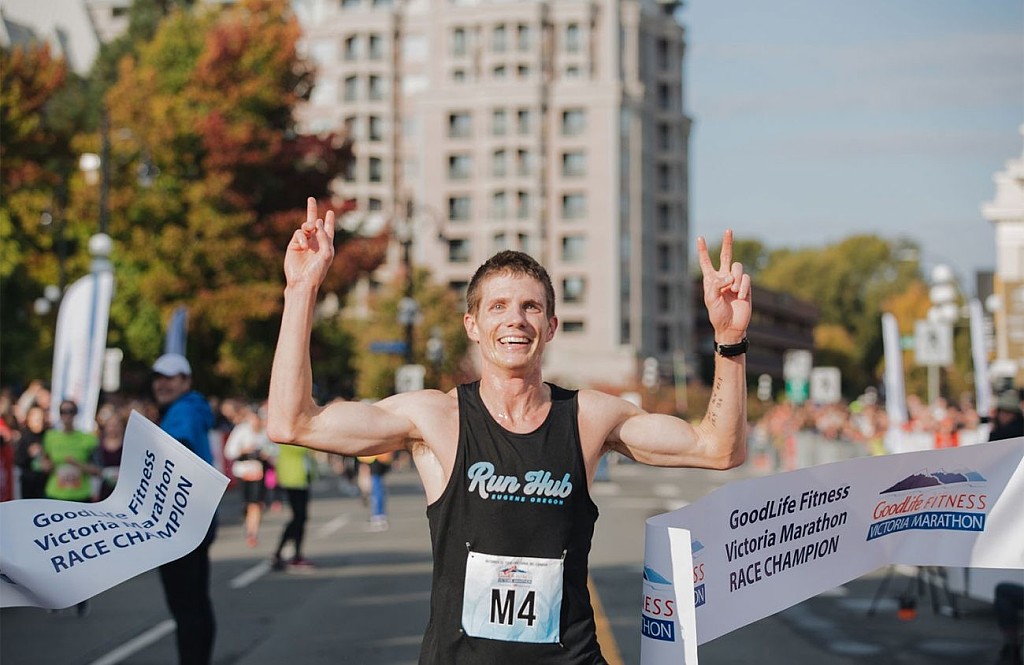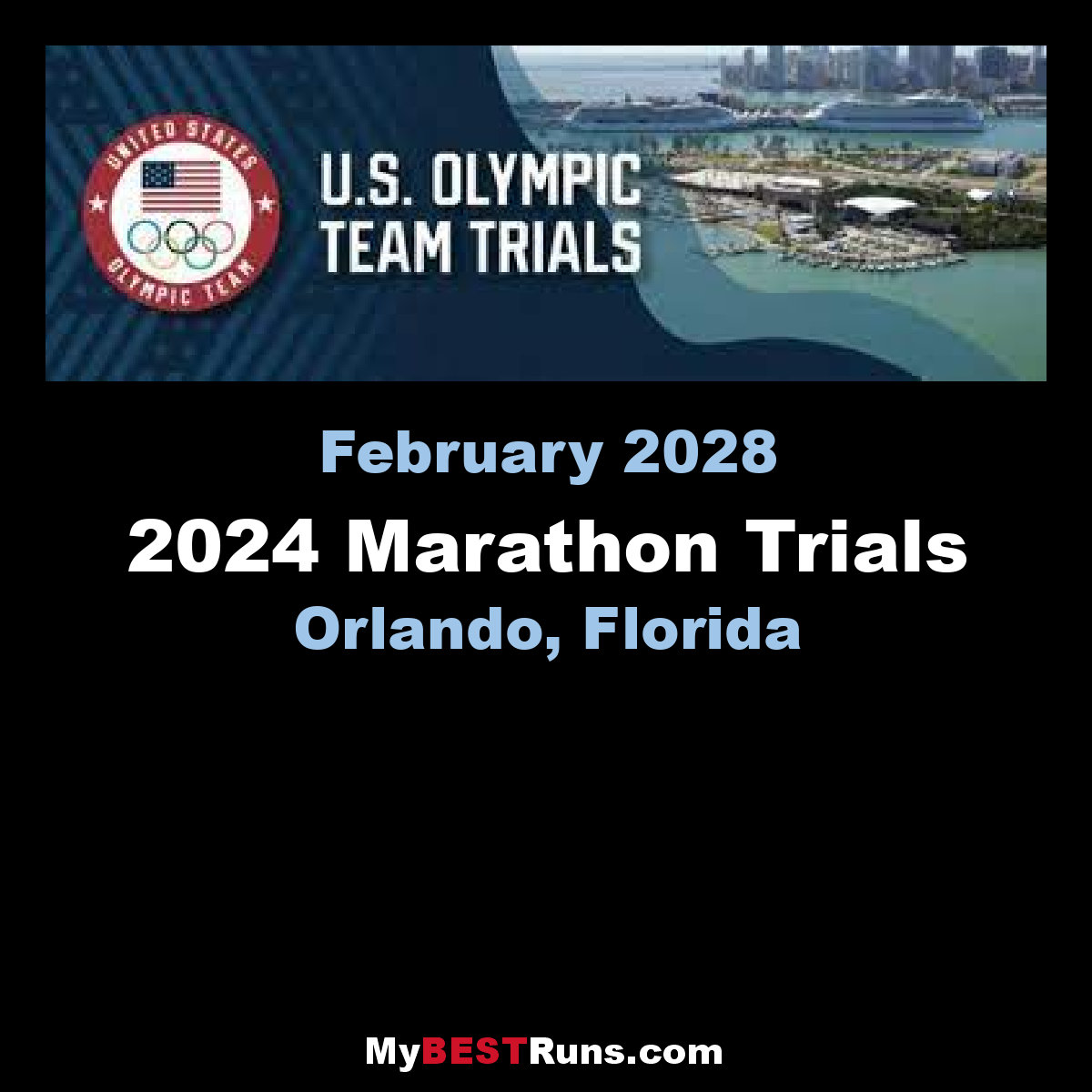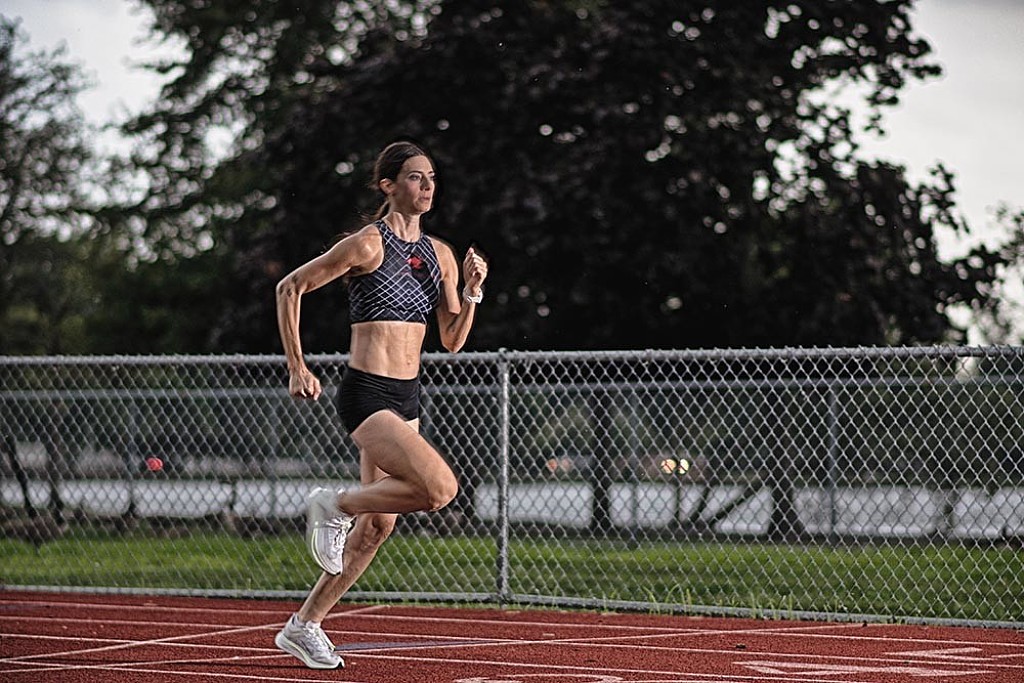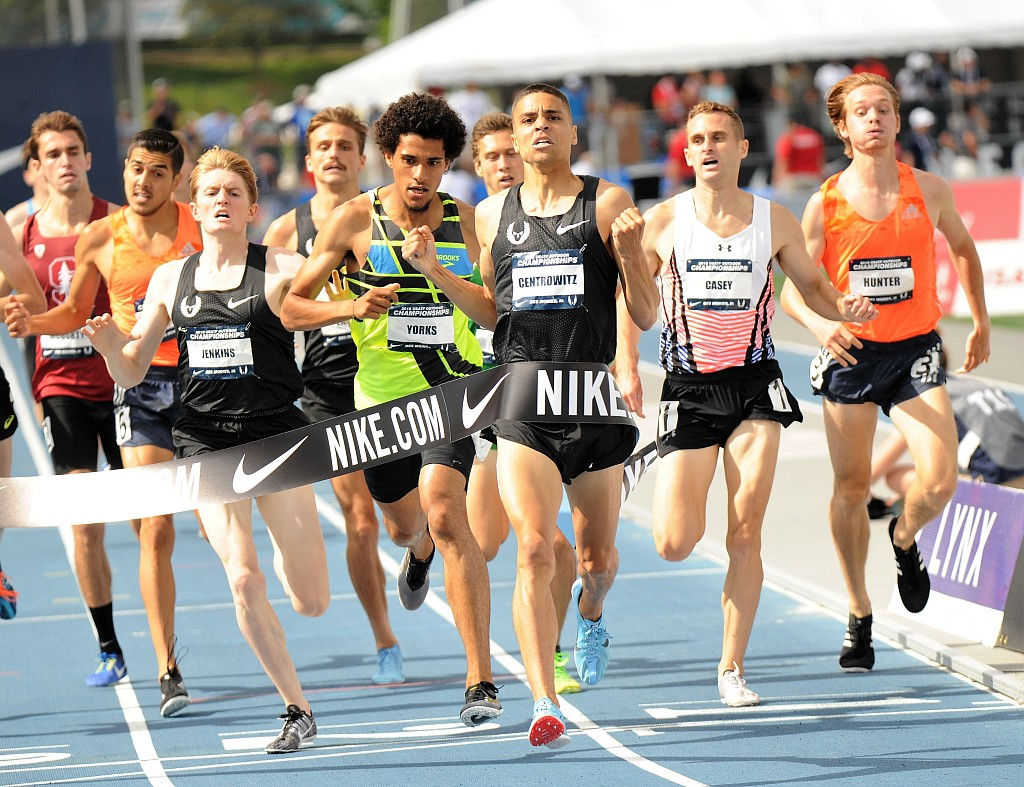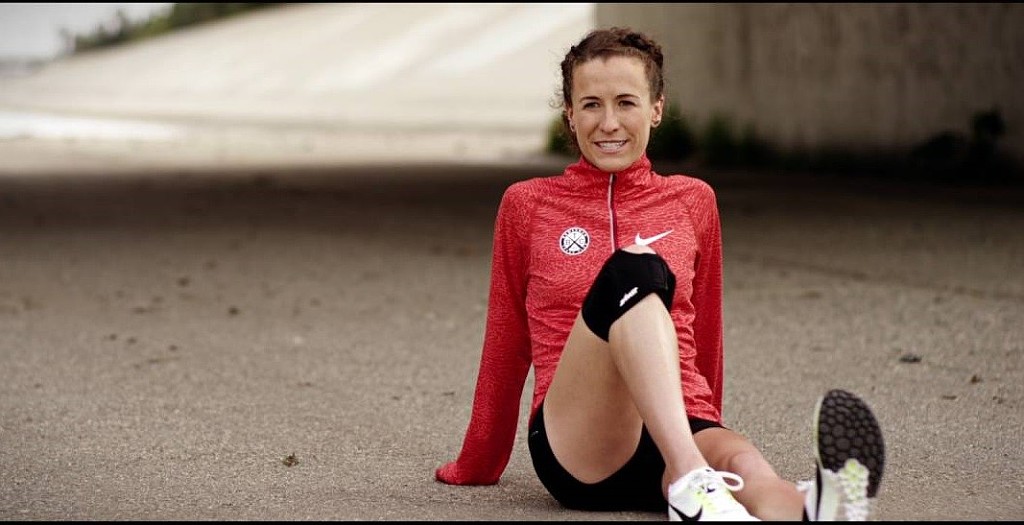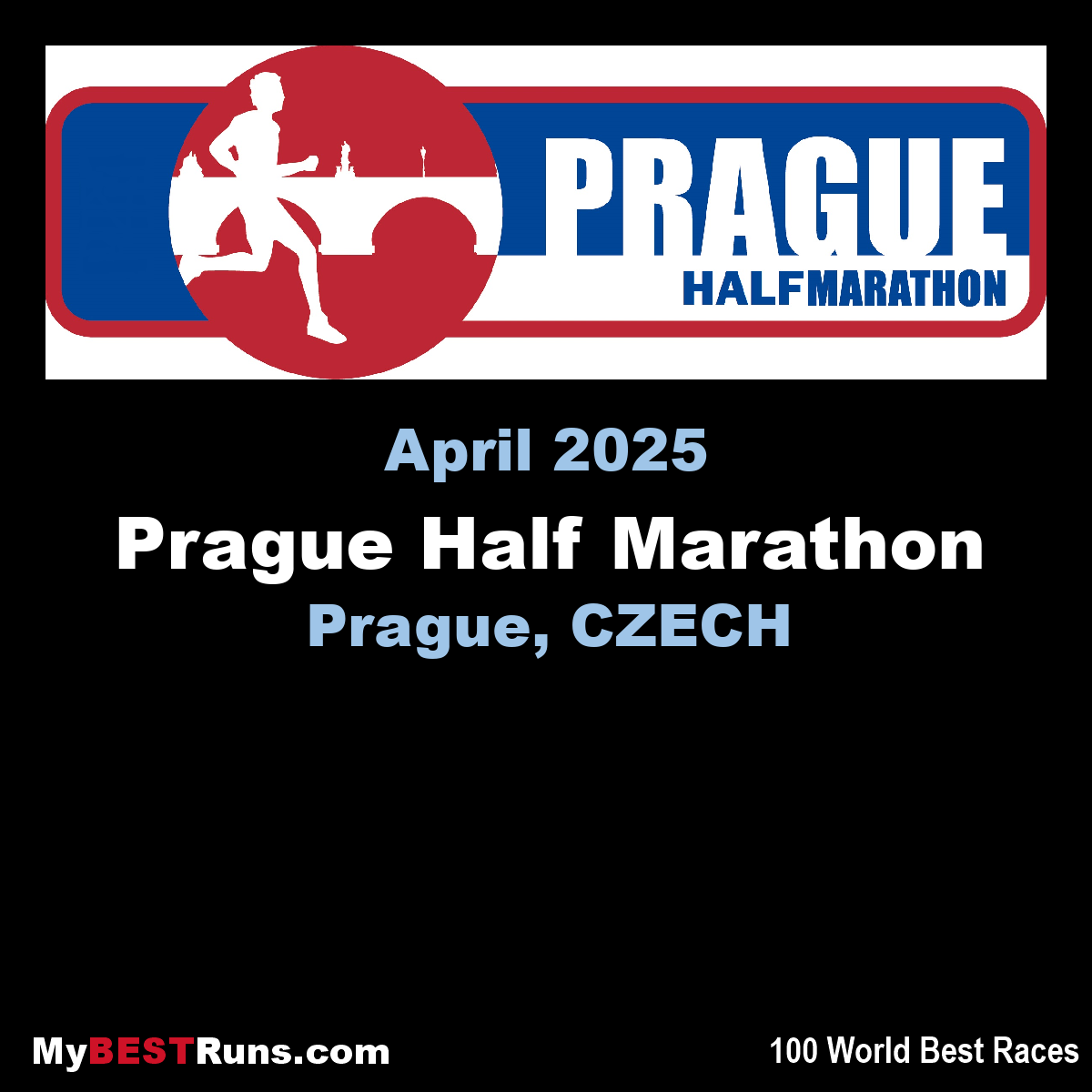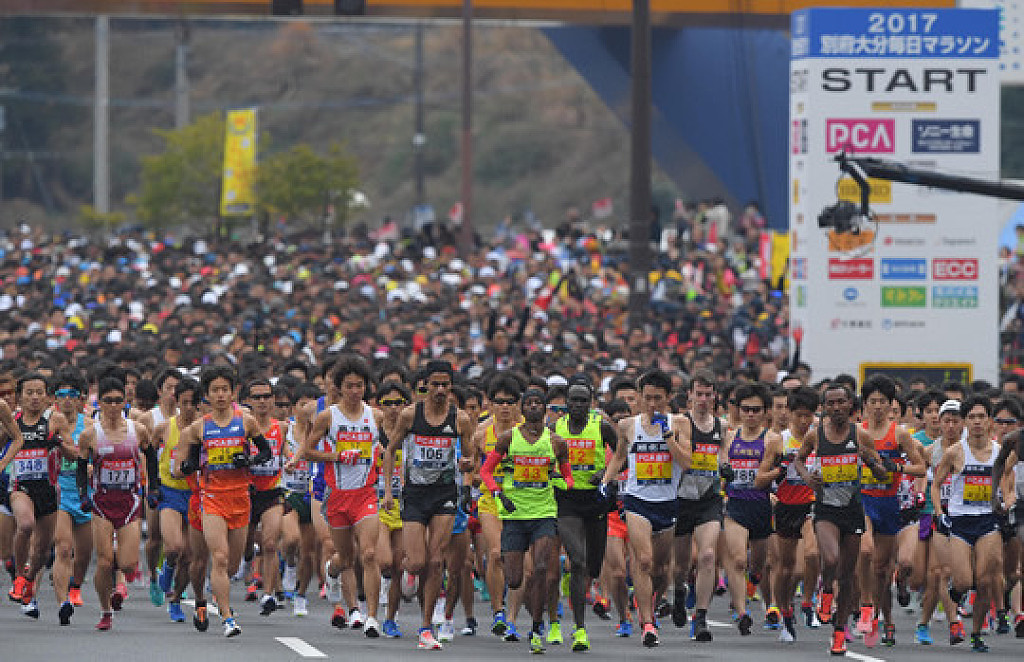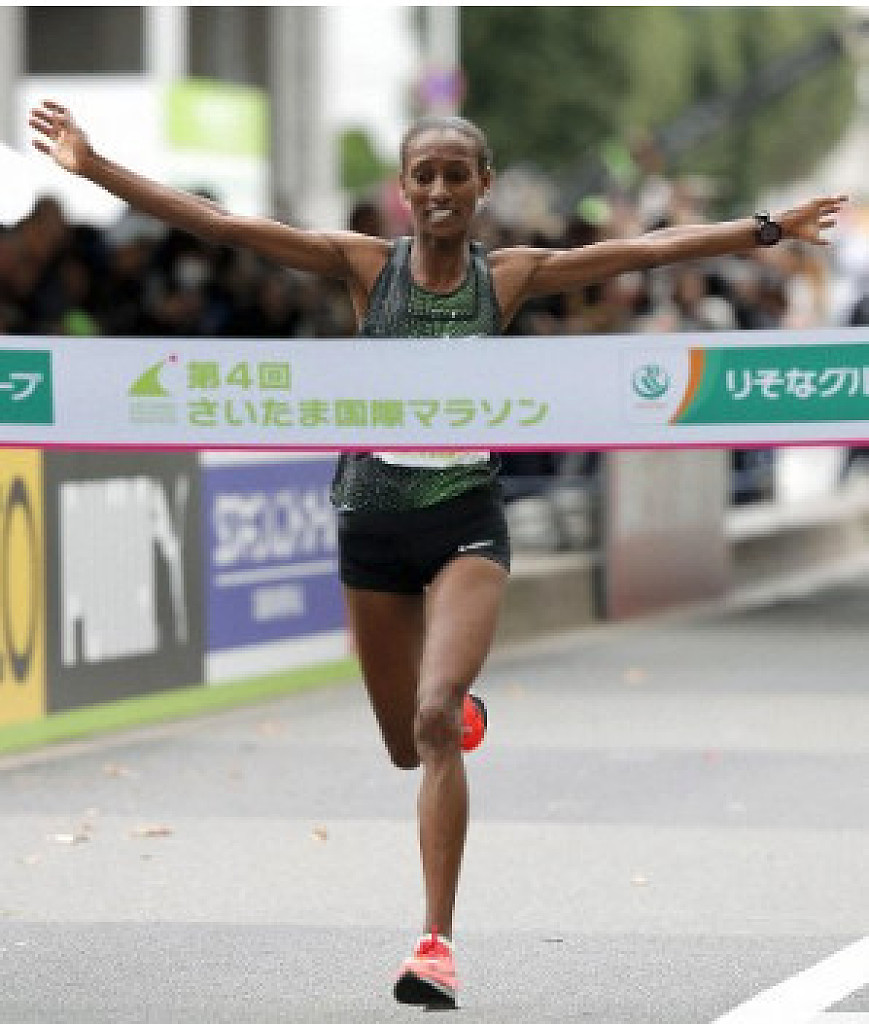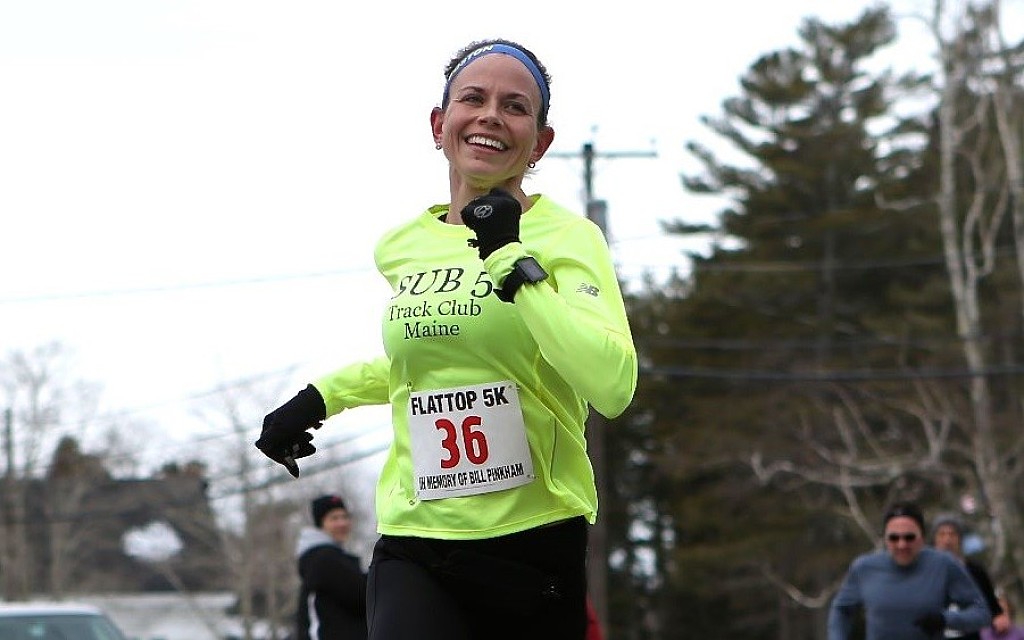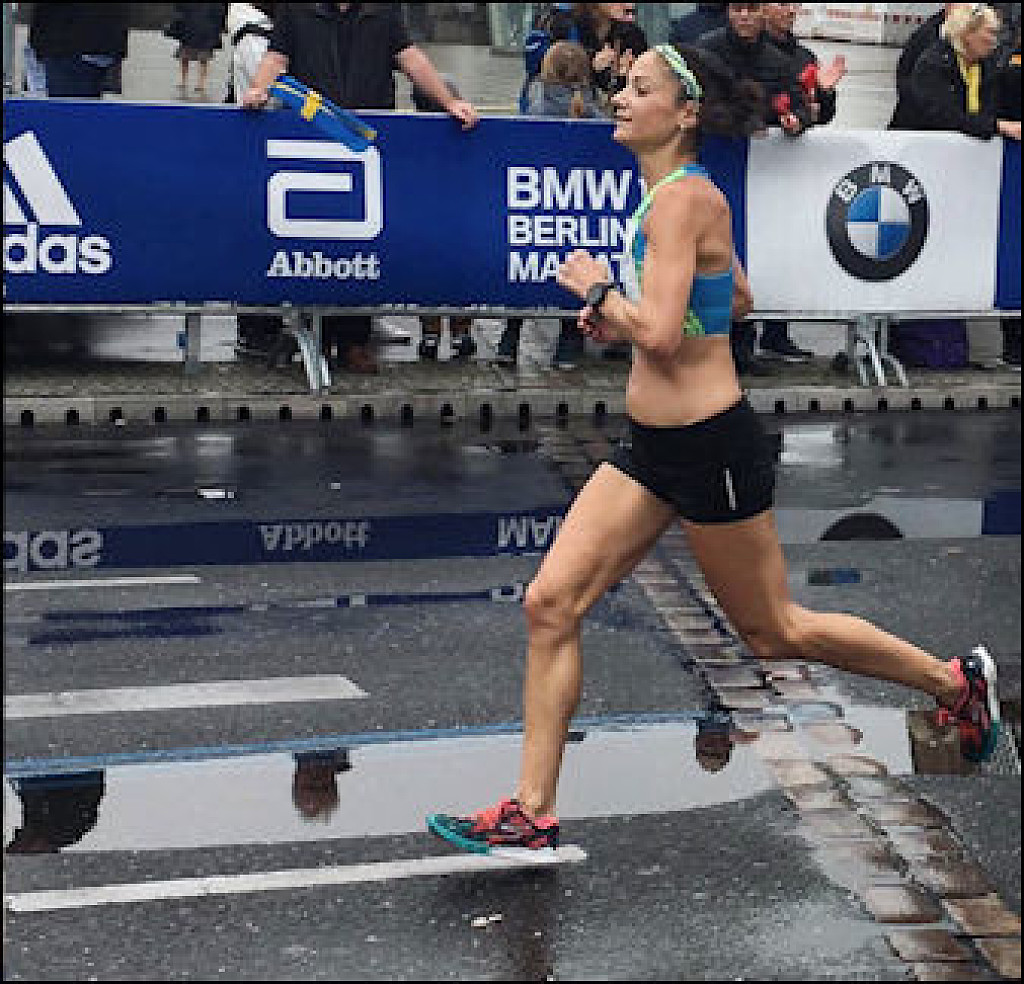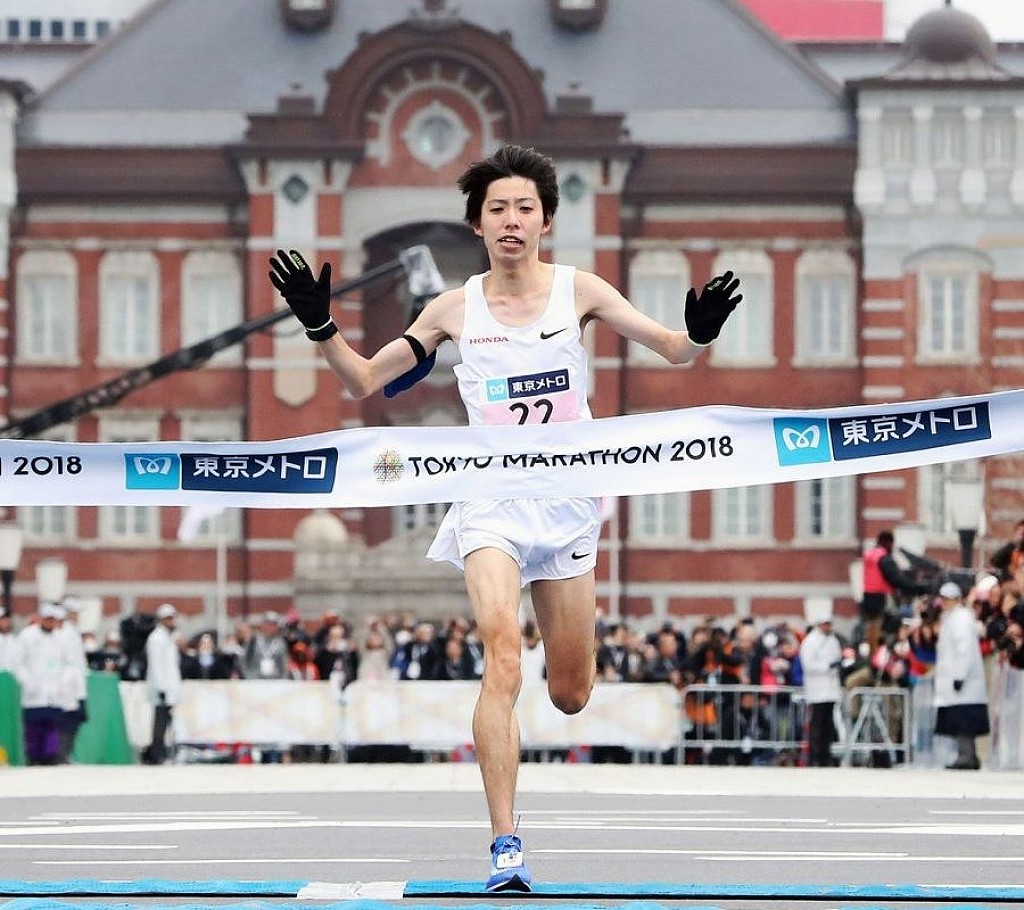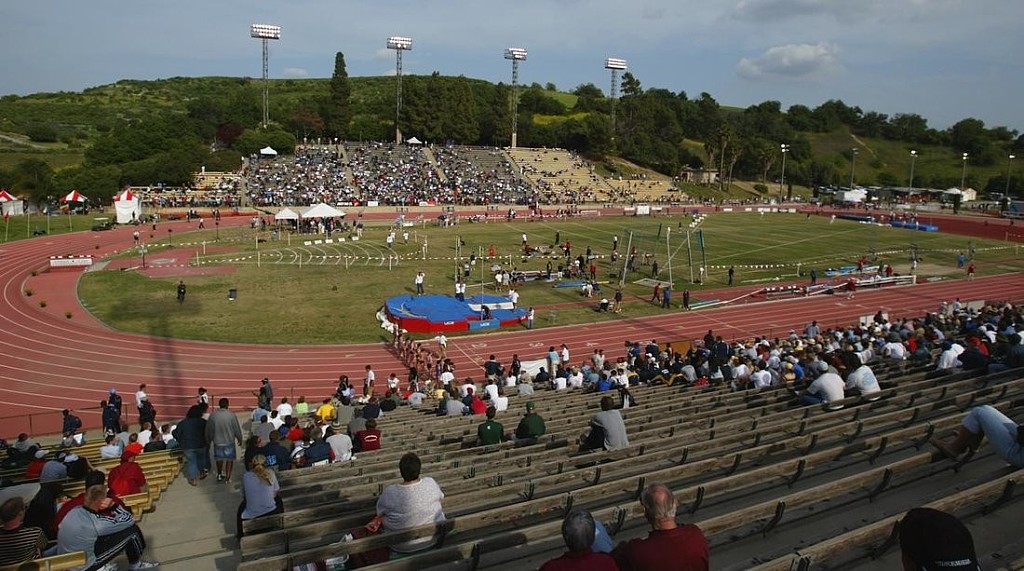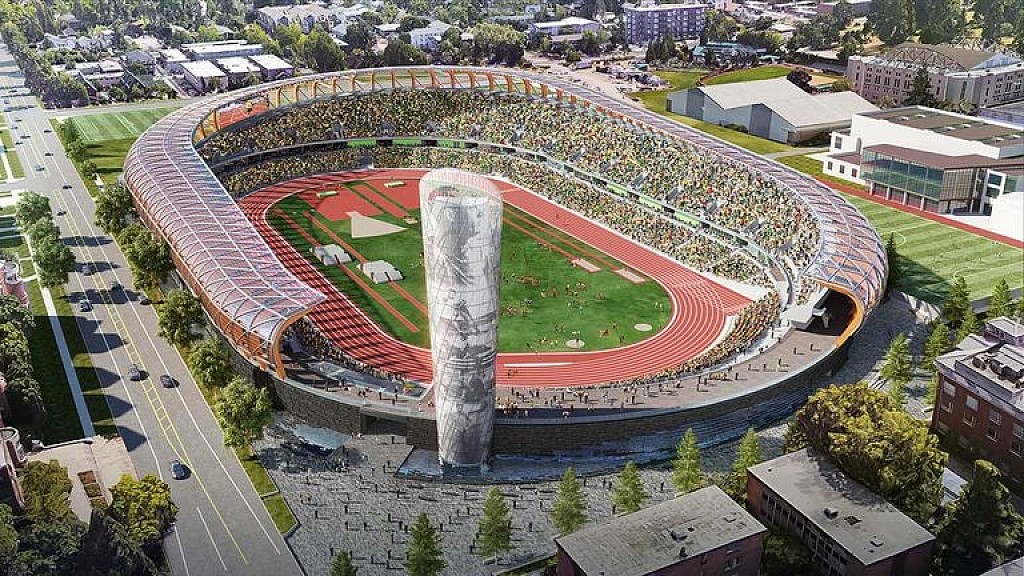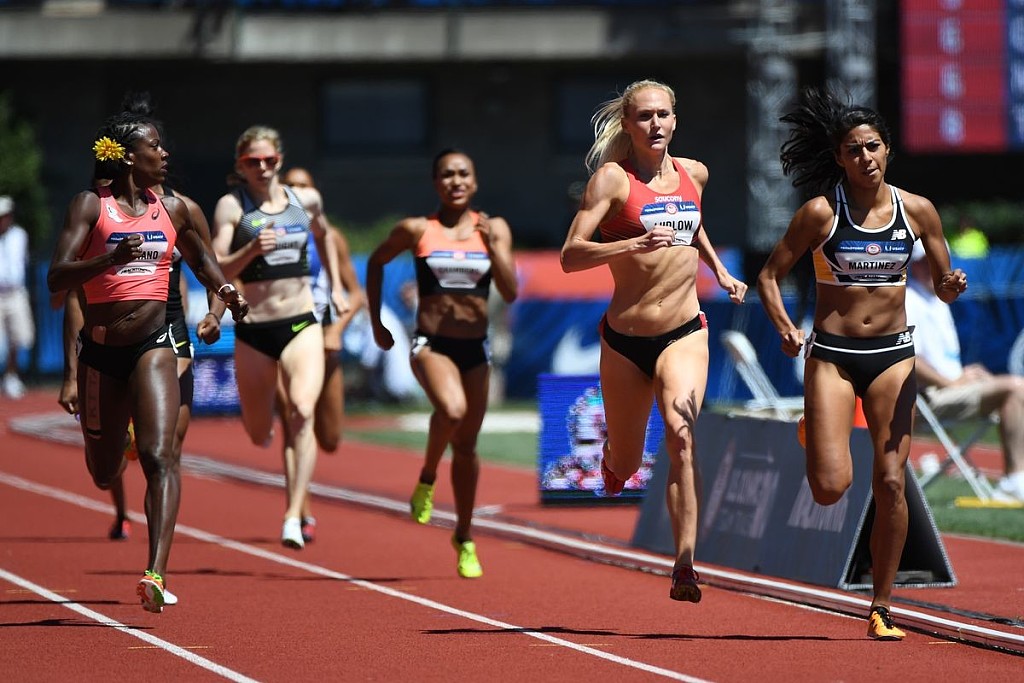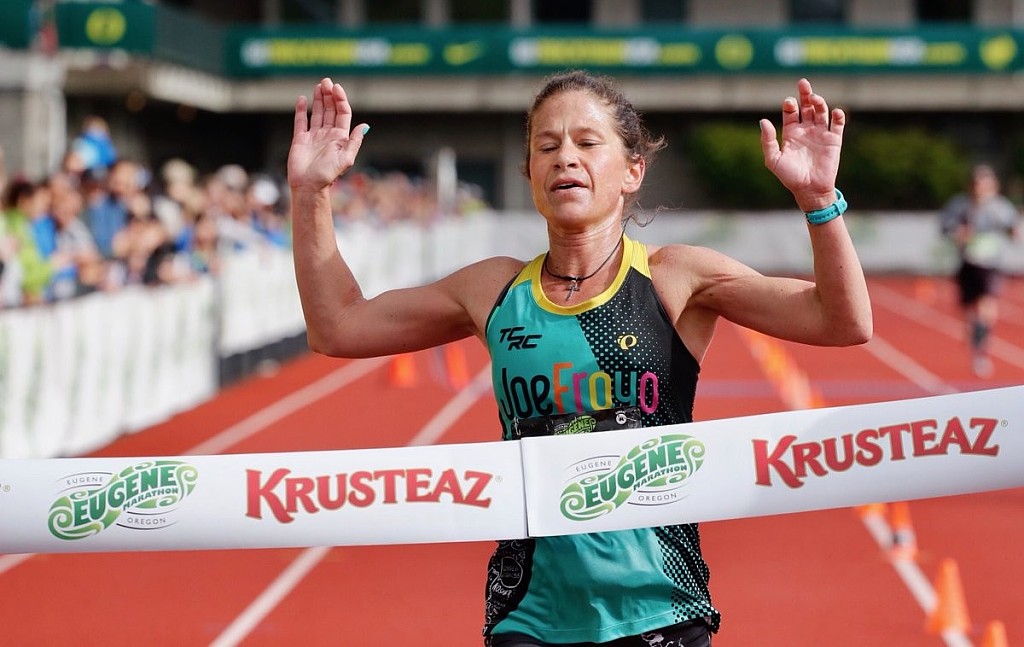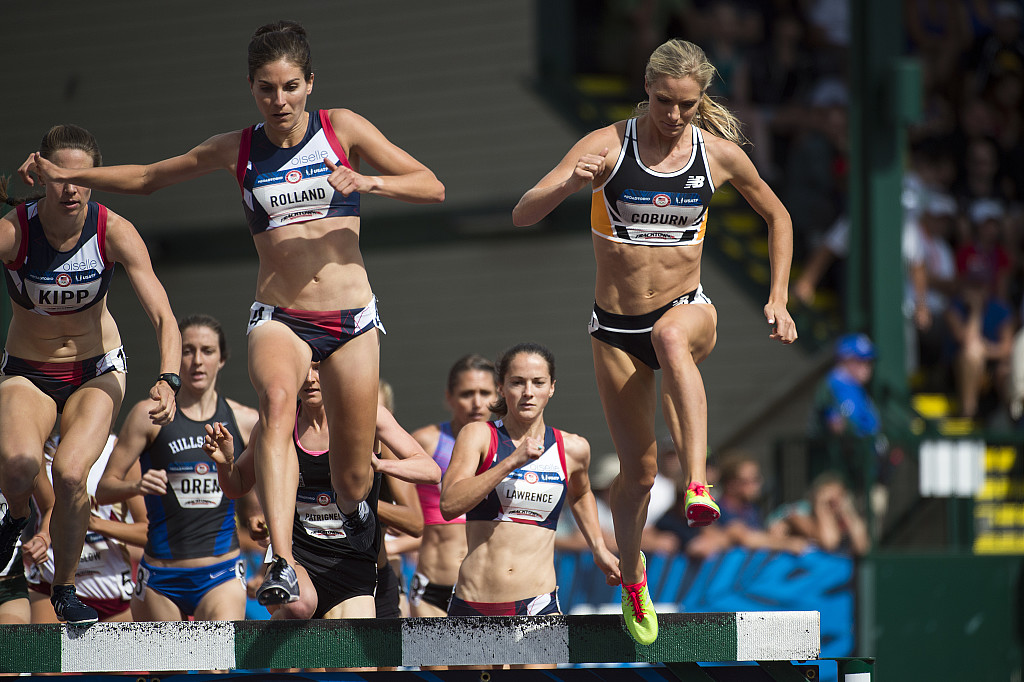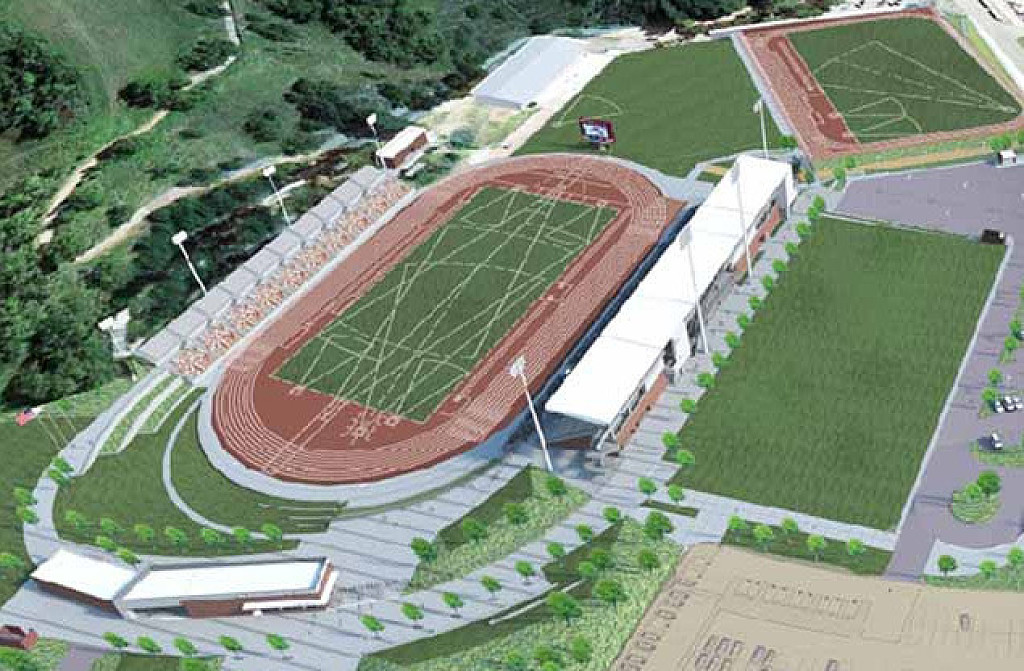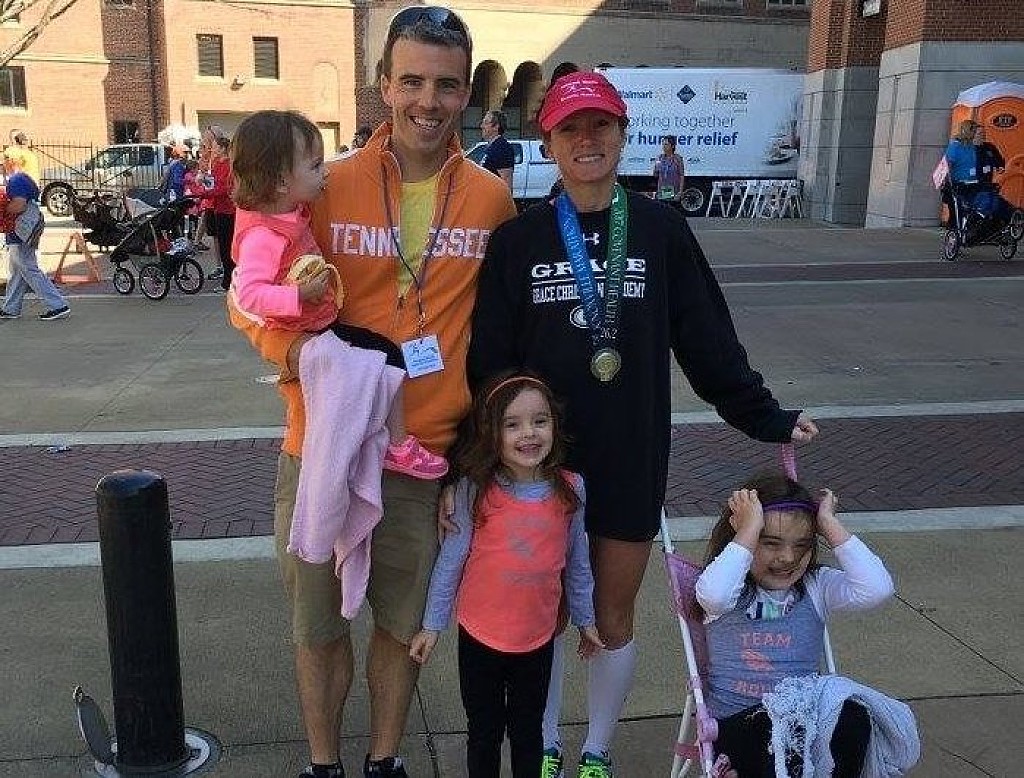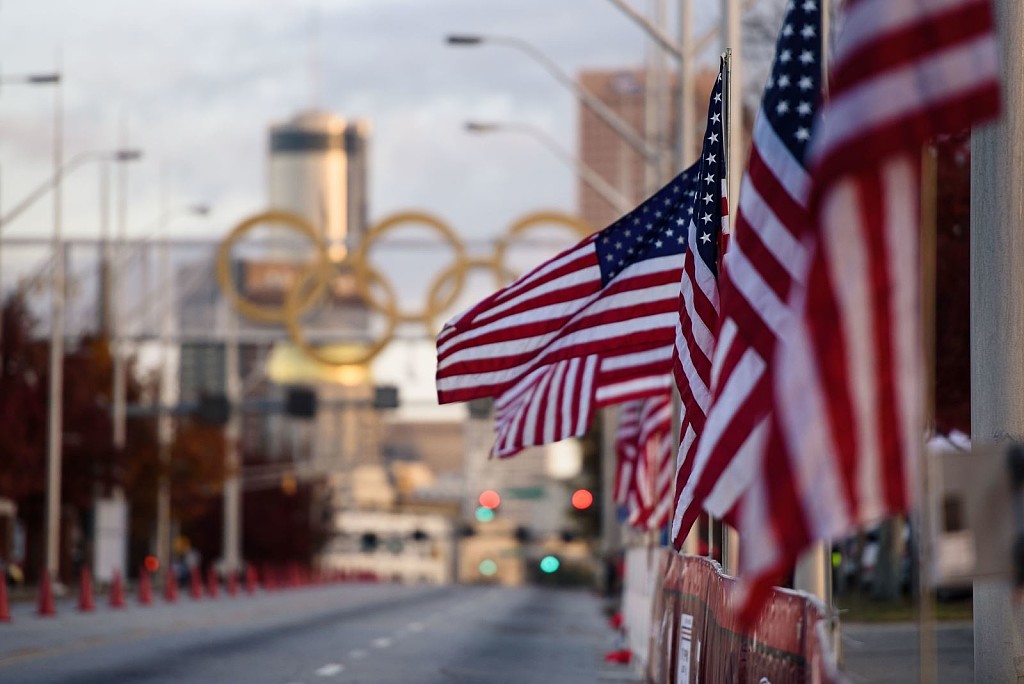Running News Daily
Running News Daily is edited by Bob Anderson. Send your news items to bob@mybestruns.com Advertising opportunities available. Train the Kenyan Way at KATA Kenya and Portugal owned and operated by Bob Anderson. Be sure to catch our movie A Long Run the movie KATA Running Camps and KATA Potato Farms - 31 now open in Kenya! https://kata.ke/
Index to Daily Posts · Sign Up For Updates · Run The World Feed
Articles tagged #2020 Olympic Trials
Today's Running News
This 31-Year-Old Runner Is a Mom and an Olympian
Buoyed by her faith, motherhood, and family, Marisa Howard never relinquished her dream of becoming an Olympian
As a young girl, Marisa Howard dreamed about becoming an Olympian one day. But her focus was on another Olympic sport, gymnastics. She had no idea what the 3,000-meter steeplechase even was.
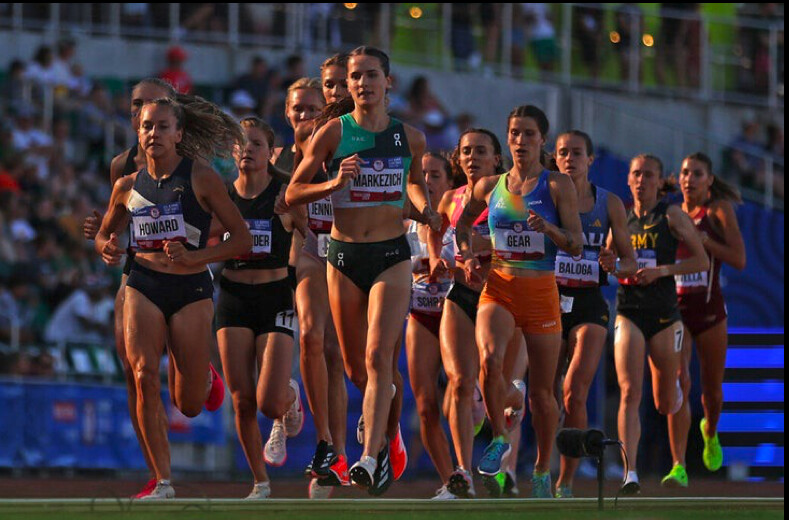
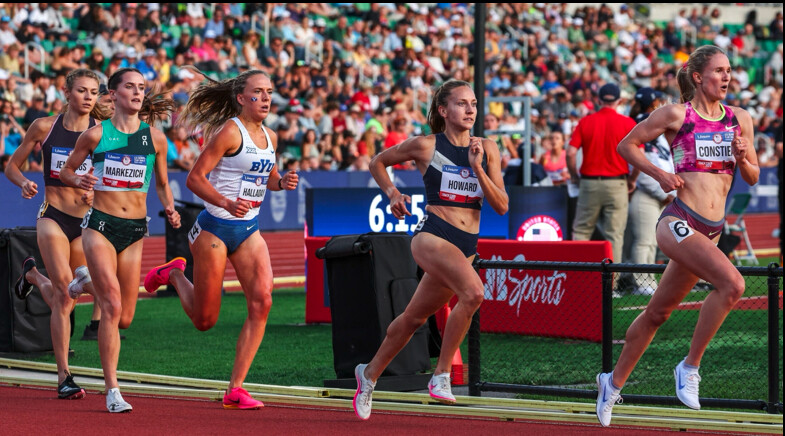
She also had no idea she’d be a mom when the dream actually came true.
Over the last two decades, Marisa, 31, has gone through numerous highs and lows, near-misses, injuries, a lack of sponsor support, and joyful life changes—most notably giving birth to son, Kai, in 2022. But the steeplechaser from Boise, Idaho, never let go of the dream. Relying on her faith, a strong family support system, and the frugal but full life she shares with her husband, Jeff, the dream came true on June 27 with a third-place finish in the steeplechase at the U.S. Olympic Trials in Eugene, Oregon.
After chipping away at her craft for three Olympic cycles, Marisa ran the race of her life—finishing with a 15-second personal best of 9 minutes and 7.14 seconds—to earn a spot on Team USA.
Her dream of running for Team USA in the Olympics officially materialized on August 4 when she lined up to race in the prelims of the 3,000-meter steeplechase in Paris. She ran with the lead pack in her heat as long as she could, but with two laps to go she slid to seventh and finished in that position in 9:24.78, missing the chance to advance to the August 6 final by two places and about seven seconds.
“I think it just becomes a lot more real when you see people that have been kind of knocking on the door for years and finally break through. It’s like, ‘Wow, we’re human and we can do it.’ Dreams do come true,” Marisa said. “I was six or seven or eight years old when this Olympic dream was born, and I plan on competing until he’s that age, hopefully, to show him what it’s like to do hard things and chase your dreams. I think it’ll be cool in 10 years when I show Kai these videos and be able to tell him, “Look at what Mommy did when you were two.”
In between making the team in late June and arriving in Paris in late July, Marisa’s life returned to normal—as if being a mom with a 2-year-old is ever normal, or at least consistent, on a day-to-day basis. That month included rough bouts of stomach flu for her and her son, the continued day-to-day management of Kai with Jeff, juggling workouts with childcare help from family and friends, reestablishing normal sleep patterns for everyone, and of course, finalizing travel plans to get the family to Paris.
It all came with a humbling reminder of the perspective that has been the bedrock of Marisa’s postpartum revival as an athlete.
“The day after I qualified, we were driving back home to Idaho and we were all tired. Kai was exhausted and screaming in the car, and I told my husband, ‘He doesn’t care that I’m an Olympian, he just wants food and sleep and, really, I’m just mom,’” she said. “It’s humbling—there’s nothing more humbling than taking care of your sick baby—and I think as a parent, we’re humbled every single day, and we come up short sometimes despite doing the best we can, but I’m thankful that there’s grace and forgiveness. I think it makes those high moments so much sweeter.”
Marisa is part of a new wave of elite runners that aren’t putting their family plans on hold due to their career, and one of several moms who competed at the U.S. Olympic Trials. Stephanie Bruce raced the 10,000 meters just nine months postpartum after giving birth to her daughter, Sophia, in September 2023, while Kate Grace ran strong preliminary and semifinal 800-meter races to advance to the final of that event just 15 months after giving birth to son, River, in March 2023.
Elle St. Pierre gave birth to her son, Ivan, at about the same time, and returned to racing six months postpartum, finishing seventh in a speedy 4:24 at the Fifth Avenue Mile in New York City. That was just the beginning for St. Pierre, who broke the American indoor record in the mile (4:16.41) in January then won the gold medal in the 3,000 meters at the indoor world championships in Glasgow in March. At the Olympic Trials, Pierre won the 5,000 meters and placed third in the 1500, qualifying for Team USA in both events, even though she declined the Olympic entry for the 5,000.
After Howard gave birth to Kai in late May 2022, she began doing pelvic floor therapy along with general strength training and some easy jogging. By the time she started running in earnest that fall, she was surprised at how quickly her aerobic fitness came back to her.
“What’s really surprised me is that I’m able to run paces that I never hit before pregnancy with the same amount or less effort,” she says. “My aerobic engine has just gotten so strong. You do see women come back stronger, but it’s a wide range of how long it takes them to come back. ”
When she returned to the track, she was aiming for a top-three finish at the 2023 U.S. championships to qualify for the world championships in Budapest. She made it to the final and was in third place with two laps to go, but just didn’t have the closing speed. However, she did get the Olympic Trials standard by clocking a near-PR of 9:22.73, demonstrating she was just as fast as her pre-pregnancy self despite limited training and two years away from racing.
By late 2023 and early 2024, Pat McCurry, Marisa’s coach since college, was able to add more volume and intensity to her training, setting up what he thought would be her best season yet. And while Marisa admittedly didn’t race as well as hoped in her races before the Olympic Trials, McCurry knew she was capable of great things.
“She was on a different level once we got back to that base fitness post-pregnancy, and I think that’s what’s paid off in massive fitness dividends,” said McCurry, who has coached Marisa on Idaho Afoot training group since 2015. “The racing didn’t look amazing from the outside. The training was spectacular. We were doing things in training since January that we’ve never done before—just the level of intensity and volume we were sustaining was stellar.”
Marisa picked up running at Pasco High School in Washington, and carried on with the dream at Boise State University. There, she also met Jeff Howard, a Boise State runner who held the school record in the 10,000 meters. But more important than their common athletic passion, they shared the same Christian values that were the foundation of her life. They married in the summer of 2013 just after he graduated. He eventually took a job as a high school teacher at a nearby school, while she blossomed into a three-time NCAA Division I All-American for the Broncos, notching a runner-up finish at the 2014 NCAA championships and fourth-place finish the following year as a senior.
After she graduated, she picked up a small sponsorship deal with women’s apparel brand Oiselle and set her sights on the 2016 U.S. Olympic Trials . She got injured and missed the trials that year. But Howard and her husband bought a house in Boise and started their family life in earnest. That added stability, along with the guidance of McCurry, who she began working with in 2016, allowed her to dig deeper into training and continue to make progress in the steeplechase, lowering her personal best to 9:30.92 at a race in Lapinlahti, Finland.
The Oiselle sponsorship evaporated after about three years but that didn’t seem to matter. She and Jeff were living frugally and loving life, especially because, by then, most of their family had moved to Boise. Marisa had two aunts who had lived in the area before she went to college, and Jeff’s parents moved to town shortly after they were married. Marisa’s parents, and later her best friend, Marianne Green, also picked up their roots and relocated to town.
The ensuing years brought a variety of highs and lows—several near-miss fifth place finishes at U.S. championships, a silver medal at the 2019 Pan American Games, a few injuries that delayed her progress, a breakthrough eight-second PR in the semifinals of the 2020 Olympic Trials, and, of course, welcoming Kai into the world in 2022.
What makes Marisa’s situation especially challenging is that she’s run competitively without a traditional sponsor since 2017, more or less collectively bootstrapping the dream on her husband’s high school teacher’s salary and working part-time as a schol nurse and as a coach. (She will officially join the Boise State staff as an assistant coach after the Olympics.) She often stays with friends when she travels to races and says she’s grateful to the meet directors who have flown her out to race, put her up in hotels, and also paid her to pace races.
She also earned USATF Foundation grants and in 2022 was the recipient of a $10,000 grant to offset child care expenses from a program sprinting legend Allyson Felix organized through Athleta’s Power of She Fund and the Women’s Sports Foundation. Marisa competed at the 2024 Olympic Trials as part of the Tracksmith Amateur Support Program, which provides a small quarterly stipend, running apparel, and shoes to about 40 athletes in all disciplines of track and field.
“We’ve found ways to make it work. We drive used cars, and we refinanced in 2020, so thankfully our mortgage is very low,” she says. “So really a lot of my expenses are just shoes, a little bit of travel, coaching fees, gym fees, and things like that. But it does add up. But thankfully we live well within our means and are able to do it. As I’ve said before, the Lord always provides.”
But even with that support and her continued progress, Marisa entered the Olympic Trials as a dark horse contender to make Team USA. And that’s despite knowing that Emma Coburn and Courtney Frerichs, the top stars of the event for the past 10 years, were sidelined with injuries. She hadn’t run great in her races leading up to the trials, and her confidence was waning, McCurry says.
“I felt like not having a full contract [from a shoe sponsorship] had kind of eroded away at some of her confidence, and she was starting to have a little bit of imposter syndrome at races,” says McCurry. “We just had a really firm talk where I was like, damn it, you’re better than this,” he says. “Not we, not the training, you, Marissa Howard, are better than this.”
That pep talk was just what she needed. It helped remind Marisa about her bigger purpose, just as much as packing diapers, toys, and pajamas for Kai did before she and Jeff made the eight-hour drive to Eugene for the Olympic Trials.
In her semi-final heat at the trials on June 24, Marisa ran aggressively and finished second behind Gabbi Jennings in 9:26.38. After the race, she said she was looking forward to the final, but, for the moment, was most interested in making sure Kai got to bed on time.
Running with purpose and caring for her son emboldened her for the final, where she ran with conviction among the top five before moving into the lead briefly with a lap to go. In what was a thrilling final lap, Val Constien retook the lead and sprinted to victory down the homestretch in an Olympic Trials-record 9:03.22, followed by a surging Courtney Wayment (9:06.50) and a determined Marisa (9:07.14) as the top nine finishers all set new personal bests.
“My husband and I talk about competitive greatness: You want to rise to the occasion when everyone else is at their best. So it’s like, gosh, I was able to do it! I think a lot of it for me has always been about having my priorities in place. I’m a Christian first, and then a wife, and then a mom, and then a runner. And I think if I keep those in that line, that’s where I see success,” Marisa says.
“I’ve sat next to gold medalists and other high-level athletes in chapels before U.S. championship races and they’ve told me, ‘I’ve won that gold medal and it doesn’t fill that void in my heart.’ And just knowing that a medal or success isn’t going to change you, ultimately, you have to be secure in who you are. So just remembering where my priorities lie helps to kind of keep me grounded.”
Login to leave a comment
What You Need to Know About the U.S. Track and Field Olympic Trials
From June 21-30, more than 900 runners, throwers, and jumpers will put it all on the line for a chance to compete for Team USA at the Paris Olympics
The U.S. Track and Field Olympic Trials is a showcase of hundreds of America’s best track and field athletes who will be battling for a chance to qualify for Team USA and compete in this summer’s Paris Olympics. For many athletes competing in Eugene, simply making it on to the start line is a life-long accomplishment. Each earned their spot by qualifying for the trials in their event(s). The athlete qualifier and declaration lists are expected to be finalized this week.

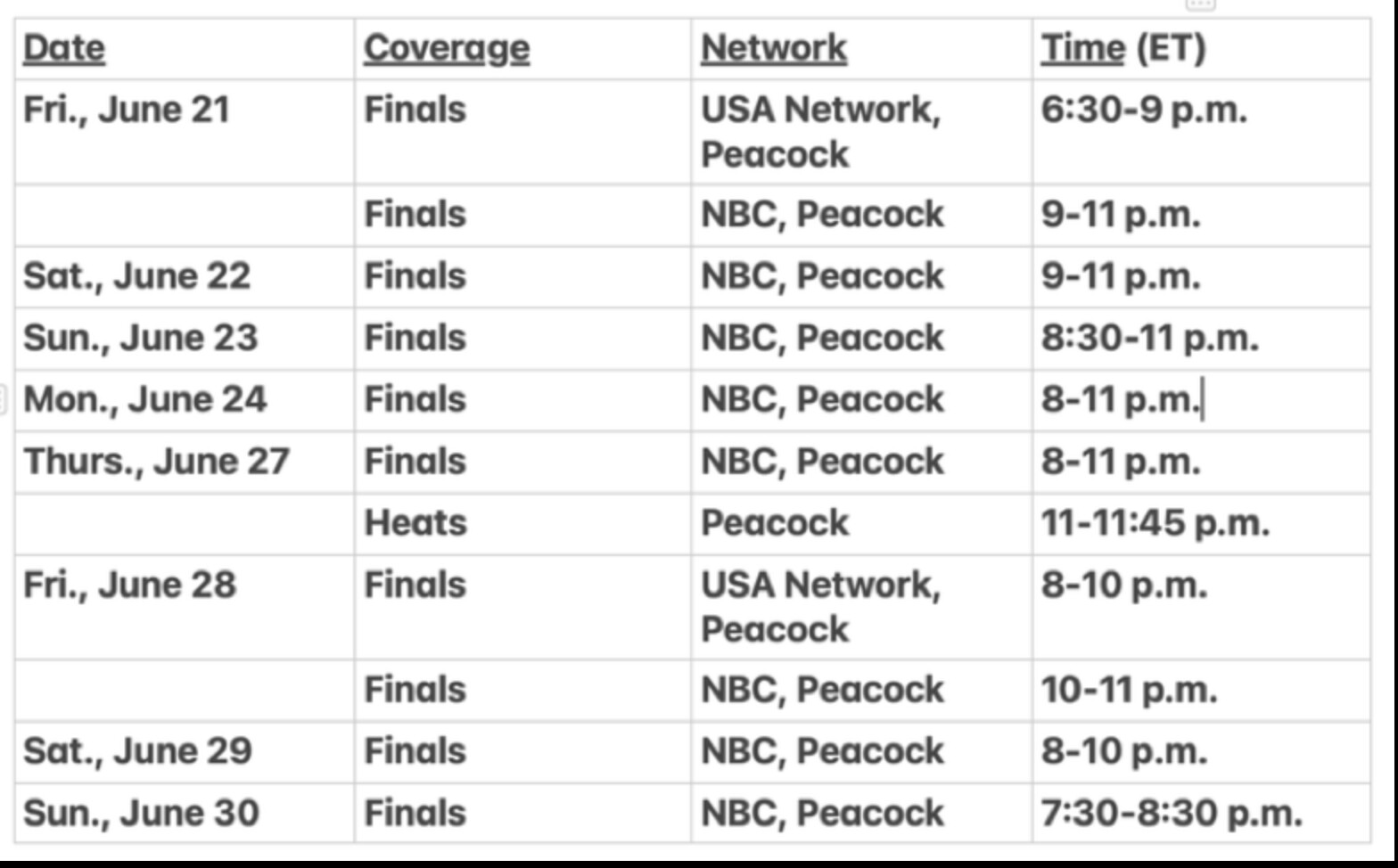
But for the highest echelon of athletes, the trials defines a make-or-break moment in their career. Only three Olympic team spots (in each gender) are available in each event, and given the U.S. depth in all facets of track and field—sprints, hurdles, throws, jumps, and distance running events—it’s considered the world’s hardest all-around team to make. How dominant is the U.S. in the world of track and field? It has led the track and field medal count at every Olympics since 1984.
At the trials, there are 20 total events for women and men—10 running events from 100 meters to 10,000 meters (including two hurdles races and the 3,000-meter steeplechase), four throwing events (discus, shot put, javelin, and hammer throw), four jumping events (long jump, triple jump, high jump, and pole vault), the quirky 20K race walking event, and, of course, the seven-event heptathlon (women) and the 10-event decathlon (men).
(At the Olympics, Team USA will also compete in men’s and women’s 4×100-meter and 4×400-meter relays, plus a mixed gender 4×400, and a mixed gender marathon race walk. The athletes competing on these teams will be drawn from those who qualify for Team USA in individual events, along with alternates who are the next-best finishers at the trials.
There’s also the Olympic marathon, but the U.S. Olympic Trials Marathon was held on February 3 in Orlando, Florida, to give the athletes enough time to recover from the demands of hammering 26.2 miles before the big dance in Paris.
Although some countries arbitrarily select their Olympic track and field teams, the U.S. system is equitable for those who show up at the Olympic Trials and compete against the country’s best athletes in each particular event. There’s just one shot for everyone, and if you finish among the top three in your event (and also have the proper Olympic qualifying marks or international rankings under your belt), you’ll earn the opportunity of a lifetime—no matter if you’re a medal contender or someone who burst onto the scene with a breakthrough performance.
The top performers in Eugene will likely be contenders for gold medals in Paris. The list of American stars is long and distinguished, but it has to start with sprinters Sha’Carri Richardson and Noah Lyles, who will be both competing in the coveted 100 and 200 meters. Each athlete won 100-meter titles at last summer’s world championships in Budapest and ran on the U.S. gold-medal 4×100 relays. (Lyles also won the 200) Each has been running fast so far this spring, but more importantly, each seems to have the speed, the skill, and swagger it takes to become an Olympic champion in the 100 and carry the title of the world’s fastest humans.
But first they have to qualify for Team USA at the Olympic Trials. Although Lyles is the top contender in the men’s 100 and second in the world with a 9.85-second season’s best, five other U.S. athletes have run sub-10-second efforts already this season. Richardson enters the meet No. 2 in the U.S. and No. 3 in the world in the women’s 100 (10.83), but eight other Americans have also broken 11 seconds. That will make the preliminary heats precariously exciting and the finals (women’s on June 22, men’s on June 23) must-see TV.
There are five returning individual Olympic gold medalists competing in the U.S. Olympic Trials with the hopes of repeating their medals in Paris—Athing Mu (800 meters), Sydney McLaughlin-Levrone (400-meter hurdles), Katie Moon (pole vault), Vallarie Allman (discus), and Ryan Crouser (shot put)—but there are more than a dozen other returning U.S. medalists from the Tokyo Olympics, as well as many more from the 2023 world championships, including gold medalists Chase Ealey (shot put), Grant Holloway (110-meter hurdles), Laulauga Tausaga (discus), and Crouser (shot put).
The most talented athlete entered in the Olympic Trials might be Anna Hall, the bronze and silver medalist in the seven-event heptathlon at the past two world championships. It’s an epic test of speed, strength, agility, and endurance. In the two-day event, Hall and about a dozen other women will compete in the 100-meter hurdles, high jump, shot put, 200 meters, long jump, javelin throw, and 800 meters, racking up points based on their performance in each event. The athletes with the top three cumulative totals will make the U.S. team. At just age 23, Hall is poised to contend for the gold in Paris, although Great Britain’s Katarina Johnson-Thompson, the world champion in 2019 and 2023, is also still in search of her first Olympic gold medal after injuries derailed her in 2016 and 2021.
If you can find your way to Eugene—and can afford the jacked-up hotel and Airbnb prices in town and nearby Springfield—you can watch it live in person at Hayward Field. Rebuilt in 2021, it’s one of the most advanced track and field facilities in the world, with an extremely fast track surface, a wind-blocking architectural design, and 12,650 seats that all offer great views and close-to-the-action ambiance. Tickets are still available for most days, ranging from $45 to $195.
If you can’t make it to Eugene, you can watch every moment of every event (including preliminary events) via TV broadcasts and livestreams. The U.S. Olympic Trials will be broadcast live and via tape delay with 11 total broadcast segments on NBC, USA Network, and Peacock. All finals will air live on NBC during primetime and the entirety of the meet will be streamed on Peacock, NBCOlympics.com, NBC.com and the NBC/NBC Sports apps.
The Olympic Trials will be replete with young, rising stars. For example, the men’s 1500 is expected to be one of the most hotly contested events and the top three contenders for the Olympic team are 25 and younger: Yared Nuguse, 25, the American record holder in the mile (3:43.97), Cole Hocker, 23, who was the 2020 Olympic Trials champion, and Hobbs Kessler, 21, who turned pro at 18 just before racing in the last Olympic Trials. Sprinter Erriyon Knighton, who turned pro at age 16 and ran in the Tokyo Olympics at age 17, is still only 20 and already has two world championships medals under his belt. Plus, the biggest track star from the last Olympics, Sydney McLaughlin-Levrone, is aiming for her third Olympics and third Olympic gold (she won the 400-meter hurdles and was on the winning 4×400 relay in Tokyo), and she’s only 24.
Several young collegiate stars could earn their place on the U.S. team heading to Paris after successful results in the just-completed NCAA championships. Leading the way are double-NCAA champions McKillenzie Long, 23, a University of Mississippi senior who enters the trials ranked sixth in the world in the 100 (10.91) and first in the 200 (21.83), and Parker Valby, a 21-year-old junior at the University of Florida, who ranks fifth in the U.S. in the 5,000 meters (14:52.18) and second in the 10,000 meters (30:50.43). Top men’s collegiate runners include 5,000-meter runner Nico Young (21, Northern Arizona University), 400-meter runner Johnnie Blockburger (21, USC), and 800-meter runners Shane Cohen (22, Virginia) and Sam Whitmarsh (21, Texas A&M).
It’s very likely. Elle St. Pierre is the top-ranked runner in both the 1500 and the 5,000, having run personal bests of 3:56.00 (the second-fastest time in U.S. history) and 14:34.12 (fifth-fastest on the U.S. list) this spring. Although she’s only 15 months postpartum after giving birth to son, Ivan, in March 2023, the 29-year-old St. Pierre is running better and faster than ever. In January, she broke the American indoor record in the mile (4:16.41) at the Millrose Games in New York City, then won the gold medal in the 3,000 meters at the indoor world championships in Glasgow in March.
St. Pierre could be joined by two world-class sprinters. Nia Ali, 35, the No. 2 ranked competitor in the 100-meter hurdles and the 2019 world champion, is a mother of 9-year-old son, Titus, and 7-year-old daughter, Yuri. Quanera Hayes, 32, the eighth-ranked runner in the 400 meters, is the mother to 5-year-old son, Demetrius. Hayes, a three-time 4×400 relay world champion, finished seventh in the 400 at the Tokyo Olympics.
Meanwhile, Kate Grace, a 2016 Olympian in the 800 meters who narrowly missed making Team USA for the Tokyo Olympics three years ago, is back running strong at age 35 after a two-year hiatus during which she suffered from a bout of long Covid and then took time off to give birth to her son, River, in March 2023.
No, unfortunately, there are a few top-tier athletes who are hurt and won’t be able to compete. That includes Courtney Frerichs (torn ACL), the silver medalist in the steeplechase at the Tokyo Olympics in 2021; Alicia Monson (torn medial meniscus), a 2020 Olympian in the 10,000 meters, the American record holder in the 5,000 and 10,000 meters, and the fifth-place finisher in the 5,000 at last year’s world championships; and Joe Klekcer (torn adductor muscle), who was 16th in the Tokyo Olympics and ninth in the 2022 world championships in the 10,000. Katelyn Tuohy, a four-time NCAA champion distance runner for North Carolina State who turned pro and signed with Adidas last winter, is also likely to miss the trials due to a lingering hamstring injury. There is also some doubt about the status of Athing Mu (hamstring), the Tokyo Olympics 800-meter champion, who has yet to race in 2024.
Meanwhile, Emma Coburn, a three-time Olympian, 2017 world champion, and 10-time U.S. champion in the 3,000-meter steeplechase, broke her ankle during her season-opening steeplechase in Shanghai on April 27. She underwent surgery a week later, and announced at the time that she would miss the trials, but has been progressing quickly through her recovery. If both she and Frerichs miss the meet, it will leave the door wide open for a new generation of steeplers—including 2020 Olympian Valerie Constein, who’s back in top form after tearing her ACL at a steeplechase in Doha and undergoing surgery last May.
The U.S. earned 41 medals in track and field at the 2020 Paralympic Games in Tokyo—including 10 gold medals—which ranked second behind China’s 51. This year’s Paralympics will follow the Olympics from August 28-September 8 in Paris.
The 2024 U.S. Paralympic Trials for track and field will be held from July 18-20 at the Ansin Sports Complex in Miramar, Florida, and Paralympic stars Nick Mayhugh, Brittni Mason, Breanna Clark, Ezra Frech, and Tatyana McFadden are all expected to compete.
In 2021 at the Tokyo Paralympics, Mayhugh set two new world records en route to winning the 100 meters (10.95) and 200 meters (21.91) in the T-37 category, and also took the silver medal in the 400 meters (50.26) and helped the U.S. win gold and set a world record in the mixed 4×100-meter relay (45.52). Clark returns to defend her Paralympic gold in the T-20 400 meters, while McFadden, a 20-time Paralympic medalist who also competed on the winning U.S. mixed relay, is expected to compete in the T-54 5,000 meters (bronze medal in 2021).
Livestream coverage of the U.S. Paralympic Trials for track and field will be available on Peacock, NBCOlympics.com, NBC.com, and the NBC/NBC Sports app, with TV coverage on CNBC on July 20 (live) and July 21 (tape-delayed).
Login to leave a comment
3-time champion Molly Huddle is ready for 2023 NYC Half
The United Airlines NYC Half came into Molly Huddle‘s life in 2014 and it was one of the key turning points in the now 38 year-old’s storied career. Never a fan of cross country or indoor track, the 28-time national champion liked to de-camp from her Providence, R.I., home in the winter to put in her pre-season base miles in the warmth of Arizona. The NYC Half, with its mid-March date, was the perfect race to close-out her winter training block. Her long-time coach Ray Treacy, whom Huddle affectionately calls “The Guru,” gave his blessing and she signed-up for the 2014 race. It would be her first-ever half-marathon.
With the temperature right at the freezing mark, Huddle ran the entire race with the leaders. She went through the first 10-K in 33:01, and the second in a much faster 32:21 as the pace heated up. Although too far behind eventual winner Sally Kipyego (1:08:31), she finished a close third to eventual 2014 Boston Marathon champion Buzunesh Deba, 1:08:59 to 1:09:04.
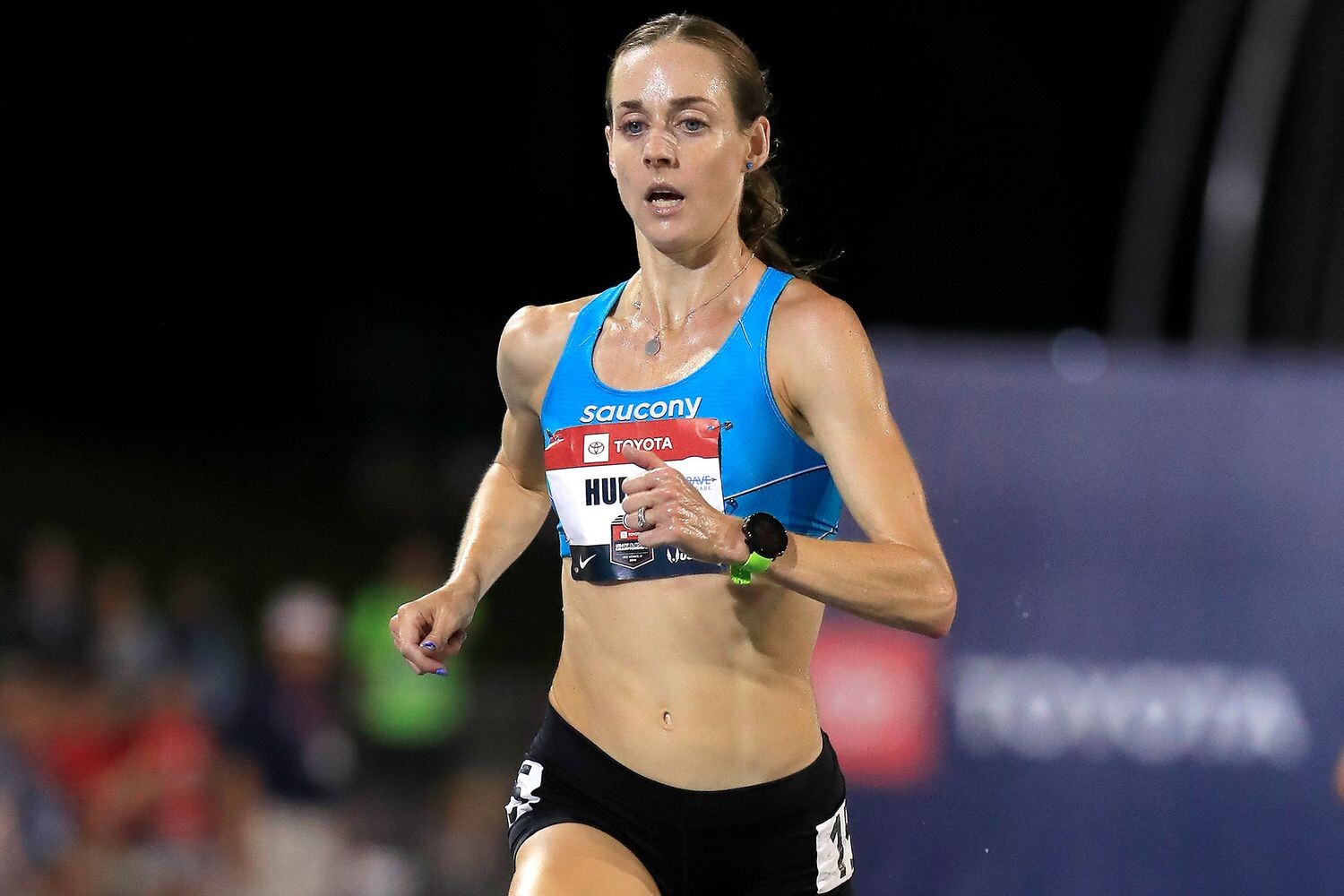
“It was good,” a shivering Huddle told Race Results Weekly’s Chris Lotsbom that day. “I think I stuck my nose in it in the beginning and the distance got to me a little in the end, but it was definitely a fun experience. I definitely want to do another one.”
The rest, shall we say, is history.
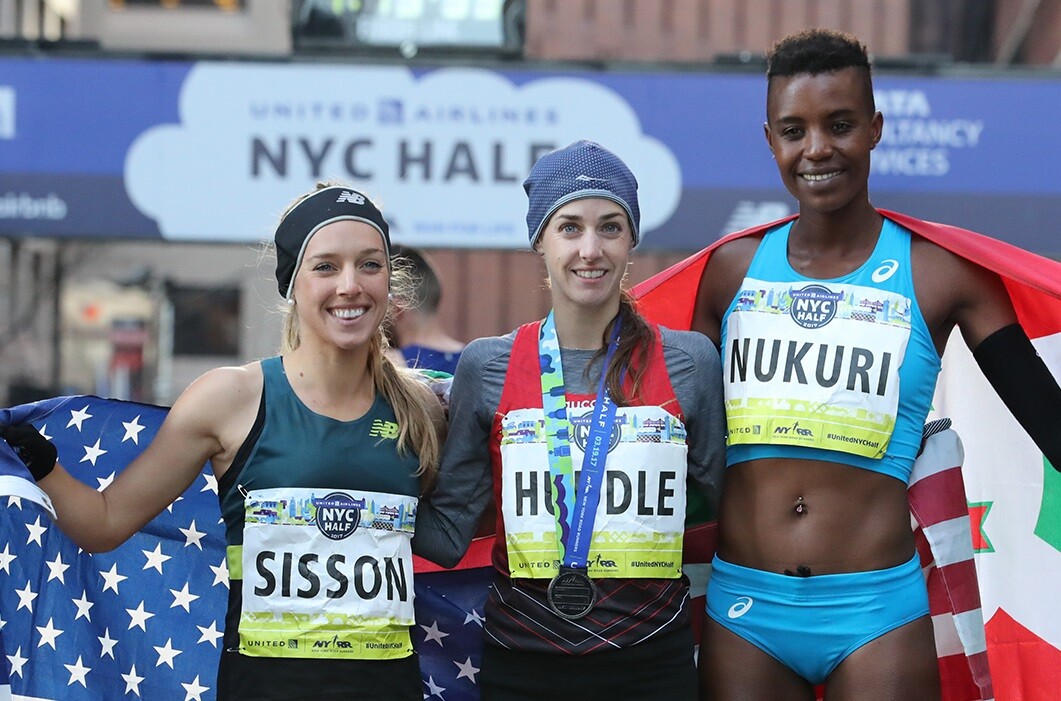
For the next three years Huddle would repeat the same winter program, training in Arizona then coming to New York for the NYC Half before starting her track season*. She won in 2015, 2016 and 2017, and in the 2016 race she set the still-standing USATF record for an all-women’s race: 1:07:41. During her reign at the top, she beat top athletes like Sally Kipyego, Caroline Rotich, Des Linden, Aliphine Tuliamuk, Buzunesh Deba, Emily Sisson, Edna Kiplagat, Diane Nukuri, and Amy Cragg. She also lowered her 10,000m personal best from 31:28.66 to an American record 30:13.17, a mark which would stand for more than six years until Alicia Monson broke it just 11 days ago at The Ten in San Juan Capistrano, Calif. She also collected $65,500 in prize money from the event which is organized by New York Road Runners.
Huddle returns to the NYC Half for the first time in six years on Sunday, but she’s no longer focused on winning. The race comes about 11 months after she, and husband Kurt Benninger, had their first child, daughter Josephine Valerie Benninger, whom Huddle calls “JoJo.” Speaking to Race Results Weekly at a press event yesterday in Times Square, she reflected on her history with the race.
“The last time I did the Half was 2017, I think, so a long time,” said Huddle, wearing a warm hat and jacket on a cold, late-winter day. “Great to be back. Great to be running again seriously after having the baby in April. So, this will be a good test.”
Huddle has been slowly building her fitness since giving birth to Josephine. She first returned to racing last August at the low-key Bobby Doyle Summer Classic 5 Mile in Narragansett, R.I., –very close to her home– clocking 29:17. Since then she has run in a series of local races in New England –a pair of 10-K’s, a 5-K cross country, and a half-marathon– to regain her racing chops.
Then, in January of this year, she ran the super-competitive Aramco Houston Half-Marathon and clocked a very good 1:10:01, a mark which qualified her for the 2024 USA Olympic Team Trials Marathon. She went back to training, and the NYC Half should give her a good reading on her progress.
“I’m really happy to fit it back in the schedule,” said Huddle, who is still breastfeeding and will be pumping while she is in New York (Kurt is with Josephine at home in Providence). “I feel like I’m having more baseline workouts now, less of a building phase and more back to normal. I’ve had a few little injury problems last month, but I’m coming around.”
A well-traveled athlete, Huddle is sticking close to home for her races now. New York is a three and one-half hour drive (or train ride) from Providence.
“I love racing within a drive distance of home now because of the baby, and this is an easier race for me to get to,” Huddle said. “So that’s good.”
Sunday’s race has yet another purpose for Huddle. It will kick-off her training for her next marathon, a distance that she hasn’t taken on since the 2020 Olympic Trials in Atlanta when she was forced to drop out with an injury. Although she wasn’t at liberty to reveal which race it will be, she said that the timing of the NYC Half was perfect, just like it always was.
“So, I’m really focusing more on the roads now; it fits in really well with that plan now,” Huddle said. She continued: “This is going to kick off a marathon build-up for me, so this will be a really good race to fit into my marathon block as we go forward the next two months.”
by David Monti
Login to leave a comment
United Airlines NYC Half-Marathon
The United Airlines NYC Half takes runners from around the city and the globe on a 13.1-mile tour of NYC. Led by a talent-packed roster of American and international elites, runners will stop traffic in the Big Apple this March! Runners will begin their journey on Prospect Park’s Center Drive before taking the race onto Brooklyn’s streets. For the third...
more...You Might Be Slower Soon After Getting a COVID Booster
New research finds a temporary decrease in a key aspect of fitness.
Everyone has that friend who got their COVID-19 vaccine and bounced back the next day, with little more than a sore arm. We’ve also heard (or told) stories of being in bed for multiple days after the first, second, third, and fourth shot.

While no one enjoys feeling unwell, runners have an added concern: How will a shot affect my upcoming training and racing?
A recent study offers some quantification to anecdotal evidence runners have been sharing for the past year and a half, where the new research found a small decline in aerobic capacity post-booster. Here’s how to incorporate that finding into your training plans.
Why Runners Care About VO2 Max
VO2max is often treated as the gold standard measurement of cardiovascular fitness. It represents the maximum amount of oxygen your body can use during exercise. This matters for runners because, all else equal, the more oxygen you can use, the harder you can work.
Given the significance of VO2 max to athletes, researchers in Belgium set out to test whether the COVID-19 booster affected it. They recruited 42 recreational endurance athletes (runners, cyclists, and swimmers) who were scheduled to receive their COVID booster—i.e., the third shot in the two-series Pfizer vaccine. Just before they got their shot, the athletes took a VO2 max test. This involved riding a stationary bike while wearing a device that measured oxygen consumption. As resistance on the bike went up, their oxygen consumption also went up until it eventually plateaued—indicating VO2max.
One week after receiving their booster, the athletes repeated the test. Compared to their performance pre-booster, their VO2max showed, on average, a 2.7 percent decrease.
Given that a decline in VO2 max reflects a decline in cardiovascular fitness, this finding is worth factoring into your training and racing plans. However, it’s worth noting that a 2.7 percent decrease in VO2 max does not necessarily mean a 2.7 percent decrease in speed. Here’s an example using Jack Daniels’s VDOT values (which are a proxy for VO2 max).
Let’s say a runner with a VDOT of 38 gets her COVID booster. This lowers her VO2 max (VDOT) by 2.7 percent, giving her a reduced VDOT value of 36.97. According to Daniels’s calculations, all else being equal, her previous 5K time of 25:12 would slow to about 25:45, or by 33 seconds—which is only 2.2 percent slower. If she’s fitter and has a half marathon time of 1:44:20 and a VDOT of 43? One week after the booster, her VDOT would be just below 42, and her half marathon time would increase from 1:44:20 to around 1:46:30, or by 2.1 percent.
VO2 Max Isn’t Everything
Admittedly, these calculations assume “all else being equal,” which is virtually impossible. Many other factors contribute to running performance, including running economy (how much oxygen you need to run a given pace), stride mechanics, and even perceived effort. Hielko Miljoen, a sports cardiologist at University of Antwerp and lead author on the paper, pointed out that in that respect, this study is only the beginning of an answer to how the booster affects performance.
“The next step in this investigation should be to do an endurance test, because VO2max is just one part of exercise capacity and athlete performance,” he says.
Additionally, the researchers only tested VO2 max one week out from the booster shot. While it’s unknown what effects may exist further out from the shot—the researchers did not retest the athletes at later intervals—it seems unlikely that the decline is permanent. “This study is by no means an answer,” says Miljoen. “It is trying to reassure people that the effects are not huge, probably not lasting.”
Weigh the Risks
Every medical decision is a personal one, and the reality is that getting the COVID-19 vaccine, including the booster, doesn’t come with a non-zero amount of risk.
“The entire field of medicine comes with statistics,” says Miljoen. “The benefit and harm of a certain medical procedure or intervention are only known on a population basis, so individuals must make up their own mind based on the data out there.”
While life-threatening risks of the vaccine are low, getting it or the booster may interrupt your training for a few days. A recent study of more than 1,000 elite Polish athletes found that the athletes lost an average of two and a half training days around getting the COVID vaccine. However, the same study found that athletes lost an average of eight training days due to COVID-19 infection. Given these and other research data, the authors concluded in favor of vaccination for athletes, writing that “the benefit–loss ratio strongly favors vaccination.”
Time Your Shot Strategically
While it doesn’t feel great to miss any amount of training, one advantage of vaccination and booster shots is that they can be timed to have minimal impact on a racing season—whereas COVID infection can’t.
Ben Rosario, executive director of Hoka NAZ Elite, recalls two of his athletes contracting what he believes was COVID in January 2020.
“I think it really affected them in the 2020 Olympic Trials marathon, because it was a real detriment to their training at that time,” he says. “They missed a really important 10 or so days of training.”
With the initial vaccines, he observed that athletes would feel unwell for seven to 10 days; consequently, they tried not to schedule their vaccination in the week or two leading up to a race. The results of the Belgian study suggest that similar scheduling may be warranted for the booster. While you may only feel the effects of the booster for a day or two, its less discernable effects—like suppressed VO2 max—can still affect your race if you schedule it too close to the shot.
Go Light Around Your Booster
Amy Yoder Begley, coach of the Atlanta Track Club, says that what her team found worked best was to ease off training for the few days surrounding their booster. Typically, the athletes would do a light day of training on the day of the booster and then go home, hydrate, and focus on moving their arm throughout the rest of the day. They’d take the next day off to let their body recover and then, depending how they felt, they’d slowly ease back into training.
“I just kept telling people: literally you’re talking two to five days to let the body do its thing to give you more protection down the road, if possible,” says Begley.
Rosario has a similar message: “My advice to all runners would be to be patient. What’s the harm in missing some training if you’re going to come back super healthy?”
by Runner’s World
Login to leave a comment
After Much Anticipation, Orlando Announced as Host of the Olympic Marathon Trials
The race will take place on February 3, 2024.
USA Track & Field (USATF) has named a host city for the 2024 Olympic Marathon Trials, and it’s Orlando, Florida.
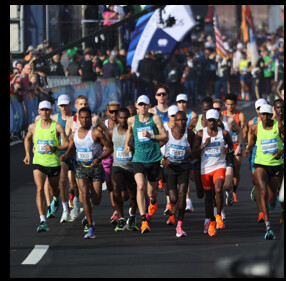
The Trials will take place on February 3, 2024, giving the local organizing committee on the ground only 15 months to prepare for the high-profile event.
The top three finishers in the men’s and women’s races will represent Team USA at the 2024 Olympic Games in Paris (provided they have met the ever-evolving standards set by World Athletics, the sport’s worldwide governing body, to run at the Games).
USATF was slow in naming a host city for the event. By contrast, when the Atlanta Track Club hosted the 2020 Olympic Trials, those organizers had 22 months to put together a race for about 700 men and women.
The fields for the race in Orlando will likely be smaller, however, because the qualifying standards to get into the Trials are tougher than they were to get into the 2020 race. In December 2021, USATF announced that women had to run a marathon faster than 2:37 in order to qualify. (For the 2020 Trials, that time was 2:45.) Or, they need to run a half marathon faster than 1:12.
Following Sunday’s NYC Marathon, only 60 women have run a marathon qualifying time. The window for half marathon qualifying opens on January 1, 2023. Men wanting to qualify for the 2024 Trials have to run 2:18 or faster (last time, the standard was 2:19) or 1:03 in the half marathon. As of mid-October, which was the last time USATF updated its list, 68 men had qualified for the Trials.
The California International Marathon, to be run this year on December 4, typically yields several Trials qualifiers.
Orlando is the first Florida city to be awarded the event.
The 2020 Olympic Marathon Trials were one of the last elite races held before the COVID pandemic shut down the world for more than a year and postponed the Olympics. At the 2021 Olympic marathon, held in Sapporo, Japan, American Molly Seidel won a bronze medal. The 2024 Olympic marathons in Paris will be held in August of that year.
Login to leave a comment
Capt. Kyle King wins one for the home team at the Marine Corps Marathon
Capt. Kyle King had been hoping to compete in the Marine Corps Marathon for years. With runners back on the course Sunday morning for the first time since 2019, the Marine stationed in Twentynine Palms, Calif., achieved his goal and then some, winning the event’s 47th edition in 2 hours 19 minutes 19 seconds.
“That was a little emotional coming to the finish line,” he said. “I’ve wanted to run this race for so long.”
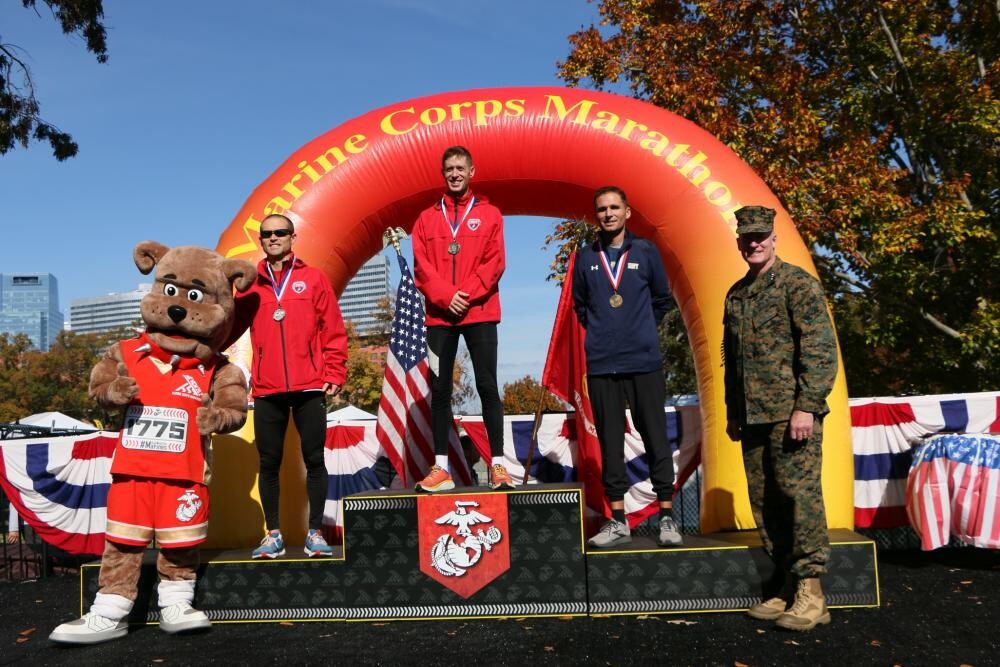
King, a 33-year-old artillery officer, finished 3 minutes 27 seconds faster than runner-up Jonathan Mott of Lakeland, Fla. England’s Chelsea Baker was the first woman to finish the race, completing the course in 2:42:38. Cara Sherman of Clifton Park, N.Y., was second, 4:30 behind.
King, who grew up in Washington state, has run competitively since high school, including a stint at Eastern Washington University. After taking a hiatus when he joined the Marines, he gravitated back toward the sport when he was stationed in Denver in 2018. In 2019, he won the Eugene (Ore.) Marathon, allowing him to qualify for the 2020 Olympic trials, at which he finished 47th in 2:18:20.
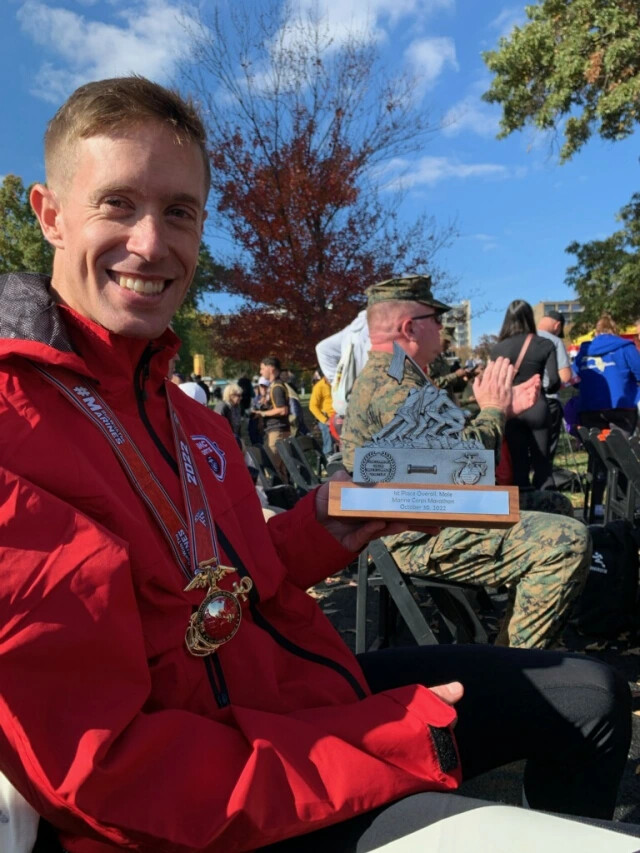
King prepared intensely for each of those opportunities, but his top goal was always the Marine Corps Marathon.
“I’ve been wanting to do this marathon for a while — just the work schedule and racing schedule [made it difficult],” he said. “This is the first time it actually happened.”
Chilly temperatures accompanied the start of the race through Arlington and D.C., but conditions improved as the morning unfolded. King found the weather beneficial to an extent.
“It was super cold. Honestly, I prefer cold over hot,” he said. “I wouldn’t say it really affected me. I honestly thought it was about perfect conditions. Pretty much no wind, nice and chilly, didn’t have to worry about getting too dehydrated.”
The power of the crowd was prominent Sunday, along the course and at the finish line. With friends, family and service members lining the way, runners called the energy infectious. King said the cheers of his fellow Marines provided an extra boost during difficult stretches.
“It’s really special doing it with all the Marines out there,” he said. “It was awesome to run in front of them and bring in the win for the home team.”
The previous two marathons were conducted remotely amid the pandemic, with participants running independently and submitting their times online. The virtual marathon setup failed to capture the camaraderie of the event, competitors said.
Gen. David H. Berger, the 38th commandant of the Marine Corps, was glad to be back in person, too. In 2019, he became the first commandant to run this marathon, finishing in 5:29:38. Running the race in person again this year, he emphasized his desire to compete alongside the community.
“This is not about the Marine Corps. It’s about the people. And although we organize it [and] it has our name, it’s really about the people,” said Berger, who finished in 5:46:36. “The emphasis should be [on] the people — the active duty, the reserved people, the civilians. This is definitely the people’s marathon.”
“Every individual who’s running has their own story, and every story has that mission that got them there to the start line,” Nealis said. “When they come across the finish [line] … they earned the right to be part of the few, the proud, the Marine Corps Marathon finishers.”
by Michael Charles
Login to leave a comment
Marine Corps Marathon
Recognized for impeccable organization on a scenic course managed by the US Marines in Arlington, VA and the nation's capital, the Marine Corps Marathon is one of the largest marathons in the US and the world. Known as 'the best marathon for beginners,' the MCM is largest marathon in the world that doesn't offer prize money, earning its nickname, “The...
more...Can Mantz and Sisson set American records on Sunday at the Chicago Marathon
Conner Mantz and Emily Sisson are looking to set American records at the Chicago marathon on Sunday. Mantz, who comes to his marathon debut with impressive XC and track credentials, has his eye on Leonard Korir’s American debut mark of 2:07:56, which was set in Amsterdam in 2019.
“All of my races and workouts have led up to this distance,” Mantz said. “I get excited thinking about it but I need to remember my first marathon and there are some unknowns.”
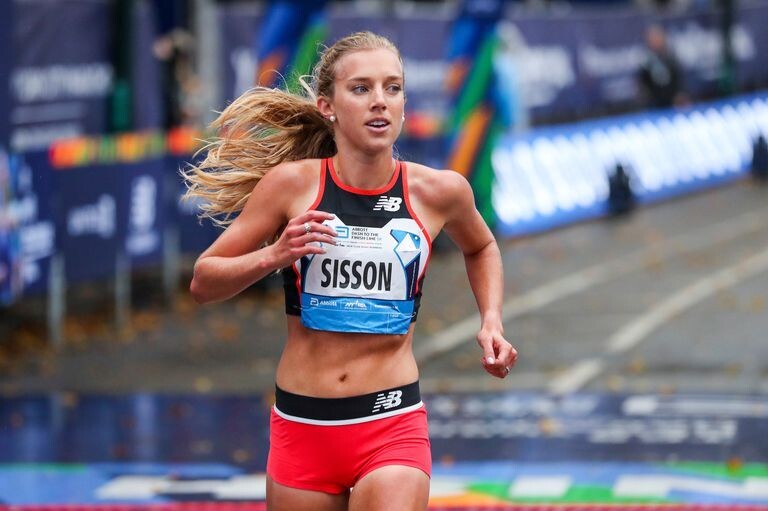
Sisson, who set the American women’s record in the half-marathon with a 1:07:11 at the USATF Half-marathon Championships in Indianapolis in May, only has one completed marathon under her belt – a 2:23:08 at London in 2019 (she dropped out of the 2020 Olympic Trials)– but has her eyes on the women’s American record of 2:19:12, which was set this past January by Keira D’Amato in Houston.
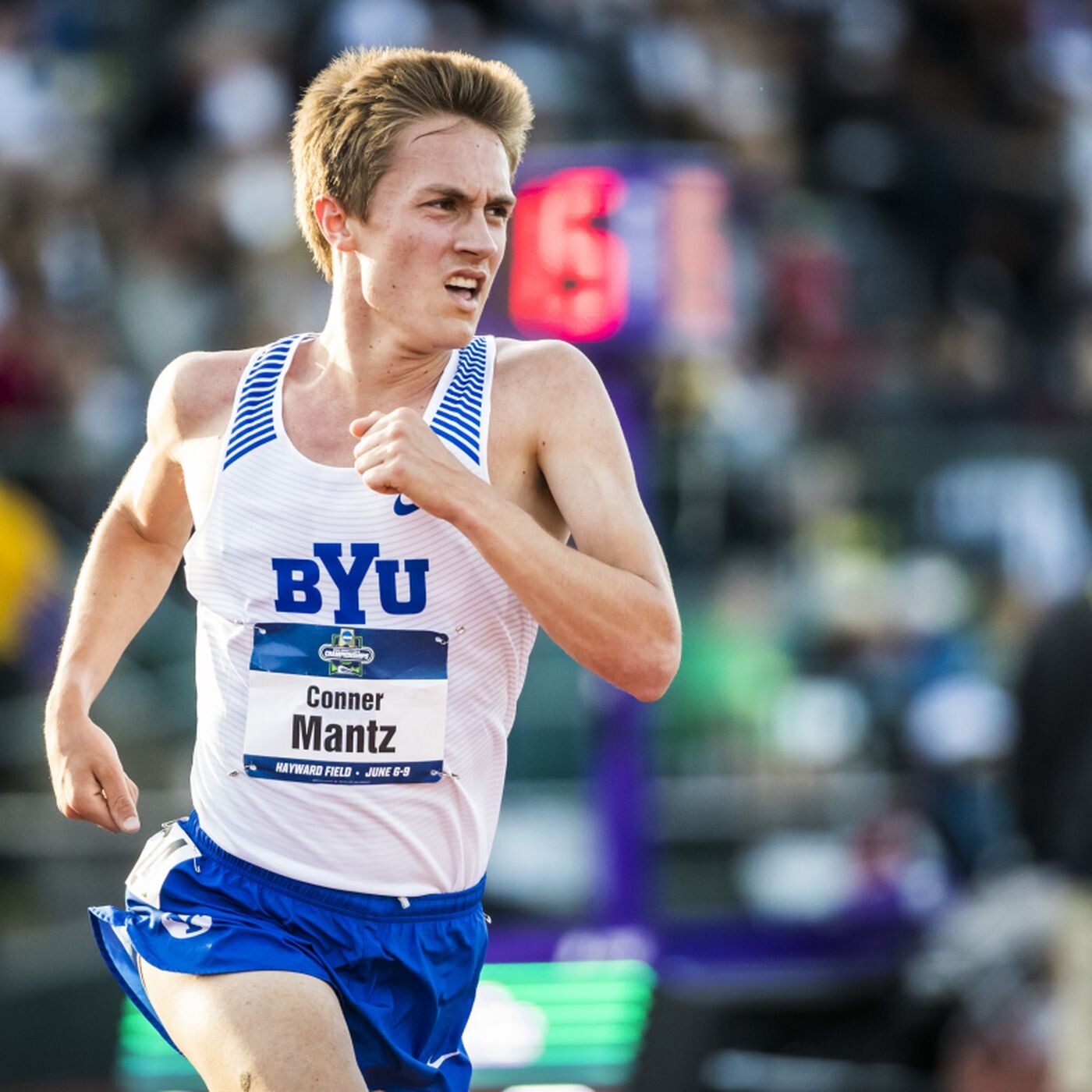
“My first marathon experience was really positive, and I really enjoyed it,” Sisson said. “After my first marathon in London I was drawn back to it and really want to see what I can do.
“My main goal is to try to break 2:20. If I’m feeling good and the record is in striking range I’ll take a stab at it. I had a really good buildup without any big setbacks. The weather for the weekend looks great, and I don’t know how many times I’ll have that, so I might as well take a swing at it.”
The temperatures will be in the low-50s at the start of the race and most likely cross the 60-degree mark by the time the men’s and women’s winners will cross the finish line. While it may be a touch humid at the beginning of the race, that isn’t expected to have that much of an effect.
Even more promising is the wind. Chicago is unique among the World Marathon Majors in that much of the course up to the halfway point is run in the core of the downtown area among the tall buildings, which can whip the wind around. It also leaves the potential for the competitors to be dealing with a headwind as they make the final push up Michigan Avenue to the finish.
This year, the predicted 7-12 mph winds will be from the southeast, which could be a bit of an assistance over the final few miles.
The race is set to start at 7:30 AM Sunday, and will be shown locally on NBC and streamed on Peacock.
by Let’s Run
Login to leave a comment
Bank of America Chicago
Running the Bank of America Chicago Marathon is the pinnacle of achievement for elite athletes and everyday runners alike. On race day, runners from all 50 states and more than 100 countries will set out to accomplish a personal dream by reaching the finish line in Grant Park. The Bank of America Chicago Marathon is known for its flat and...
more...How Keira D’Amato became America’s best ever woman marathoner
Keira D'Amato is currently at the top of the American women's distance running scene. She holds multiple American records — in the 10-mile and the marathon, the latter of which had stood for nearly 16 years before D'Amato smashed it in January — and has racked up win after win this year at everything from 10Ks to 7 milers. But just two years earlier, the real estate agent and mom of two was mostly unknown, quietly putting in miles near her home in Midlothian, Virginia.
That's not to say D'Amato's success came out of nowhere — before starting her real estate career and her family she was a standout runner, a four-time All-American, at American University in Washington, D.C.
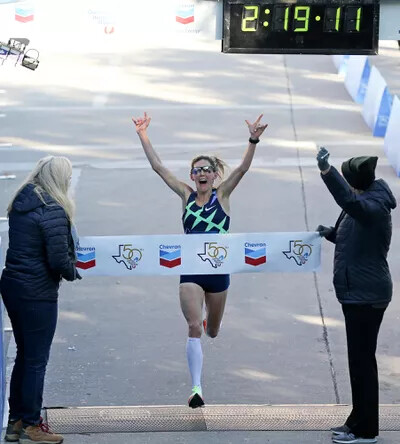
"My life then was to eat, sleep, breathe and run. That was all I knew and all I wanted to do," D'Amato, 37, tells PEOPLE. "It was my whole world." She planned to pursue professional running after graduation, but her dreams were quickly derailed by a series of injuries. When her insurance denied a needed ankle surgery, D'Amato was "kind of forced out" of the sport.
"It was a weird breakup. It really felt like running was breaking up with me," she says. "It was heartbreaking. All of sudden I was Keira the runner who doesn't run."
D'Amato ended up meeting her husband Anthony, getting her real estate license and having two kids, Thomas, now 7, and Quin, 5. Her running at that time was very casual — she picked it up again to get back in shape after the two pregnancies and for a dose of sanity while at home with young kids and a military husband, who at times was deployed for more than a year.
"That was a really, really hard time for me," she says. "Just two kids under 2 and being at home alone. I felt lonely and I felt a little trapped." D'Amato would hire a babysitter for an hour, just so she could get out and run.
"I needed something that was mine and that I controlled and something that was just slow and peaceful. Then as soon as I walked back in the door, I was feeling really proud that I'd accomplished something for me that I could go right back to being a mom," she says. "It just helped me cope during that time."
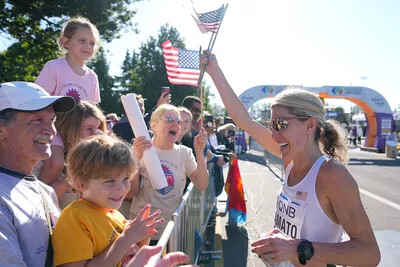
D'Amato also started jumping into a races — a local 5K, or a long weekend in Nashville with a friend for a half marathon. "It was totally for fun and it taught me how to love running without needing to be fast or have goals."
Her real return to running started as a prank — she kindly gifted Anthony with an entry to the 2017 Shamrock Marathon for Christmas one year, and feeling bad about it, decided to sign herself up too.
Thinking she'd run it in around 3 hours and 30 minutes (an impressive time for the average runner, but nothing outstanding), D'Amato ended up easily covering the 26.2 miles in 3:14:54. Eight months later, she decided to train for the Richmond Marathon, and shockingly finished in 2:47:00 — two minutes short of the Olympic Trials qualifying time.
"That's when the fire started because I was like, 'Oh, two minutes in a marathon. That's four seconds per mile. I can do that.' "
With the help of her old college coach, Scott Raczko, D'Amato qualified, and then came in 15th at the 2020 Olympic Trials, ahead of around 450 other women, including several professional runners. A few weeks later, the COVID-19 pandemic shut down the world, and races.
But for D'Amato, "running wasn't canceled," she says. "I think a lot of other pros thought, 'Well, there are no races. This is a really natural time to take a break.' For me, I'm like, 'Hey, they're taking a break. I'm putting the pedal to the metal and I'm going to really catch up.' I trained really, really hard during COVID."
She started making some headlines after running a speedy 5K on her local track, and then even more in Nov. 2020 after she organized a 10-mile race where she broke the American women's record. Four months later, D'Amato signed her first-ever professional running deal with Nike.
"That was really cool," she says. "I think for Nike to bet on someone that wasn't a right-out-of-college national champion, it was some mom in a smaller town — for them to see what I saw in myself is really powerful."
D'Amato had already been relying on Nike for her running shoes, and appreciated that unlike other brands that require their runners to join teams in Arizona or Oregon, she could continue training at home in the Richmond area.
"They support people like me that are trying to be the best in the world, but they're also really supportive on an individual level of everyone finding their own best," she says. "They really build up the sport from youth programs to professional athletes and everything in between. I feel like they've created shoes for all runners to be their own best."
D'Amato ticked off more goals from there, coming in 4th at the Chicago Marathon — her first World Marathon Major as a pro — and winning the 2021 U.S. Women's Half Marathon title.
Then, in Jan. 2022, she went after the American marathon record, a record that had stood since 2006, despite years of the top female marathoners in the country trying to bring it down. It was D'Amato, on a windy day in Houston, who was finally able to do it in a time of 2:19:12.
"On the starting line that day, I was thinking I'm either going to get the record or I'm not. If I get it, that would be wild, but if I don't, I'm going to be right where I am right now and that's cool too. I'm happy," she says.
D'Amato thinks that the way she found her way to professional running — going from a standout college career to her "elaborate halftime show" to getting back in the game — helped her to her record-breaking runs.
And D'Amato isn't done now that she has the American record. She got to knock off another goal in June when she got a last-minute call-up to compete at the World Track and Field Championships and donned a USA uniform for the first time.
Despite having just 17 days to train for a marathon (D'Amato had been racing speedier 10Ks when she got the ask to join the team), she went out fast and finished eighth in the world. In September, she'll toe the line at the Berlin Marathon — known for its flat and speedy course — and has her mind set on lowering the American record again.
"I'm in this really beautiful spot where I feel like I have nothing to lose, but just everything to gain," she says. "I'm putting everything out there, my heart, my soul, my running shoes and just going for it with every opportunity."
by Julie Mazziotta (People Magazine)
Login to leave a comment
Aliphine Tuliamuk will make marathon return at 2022 New York City Marathon
For Aliphine Tuliamuk, the decision to run in the 2022 TCS New York City Marathon was a no-brainer. The 33-year-old ran the event back in 2019, finishing 12th, and she never thought it would take three years before a return trip to Staten Island’s start line.
“It was not even, you know, a matter of if – it was just when can I get to New York? So, it was not even a decision. Easy,” explains the Kenyan-born American long-distance runner, who made a name for herself in February 2020 when she won the U.S. Olympic Marathon Trials.

But the Covid-19 pandemic hit immediately after her Trials win, postponing the Olympics and canceling that year’s edition of the NYC Marathon. During the forced hiatus, she started a family with partner – now husband – Tim Gannon, welcoming daughter Zoe in January 2021. Injury struck later that year while she was training for the postponed Tokyo Olympics, and Tuliamuk withdrew about 20k into her Olympic debut with severe hip pain and hasn’t competed in a marathon since.
Her return to marathon competition has Tuliamuk fired up, both literally and figuratively.
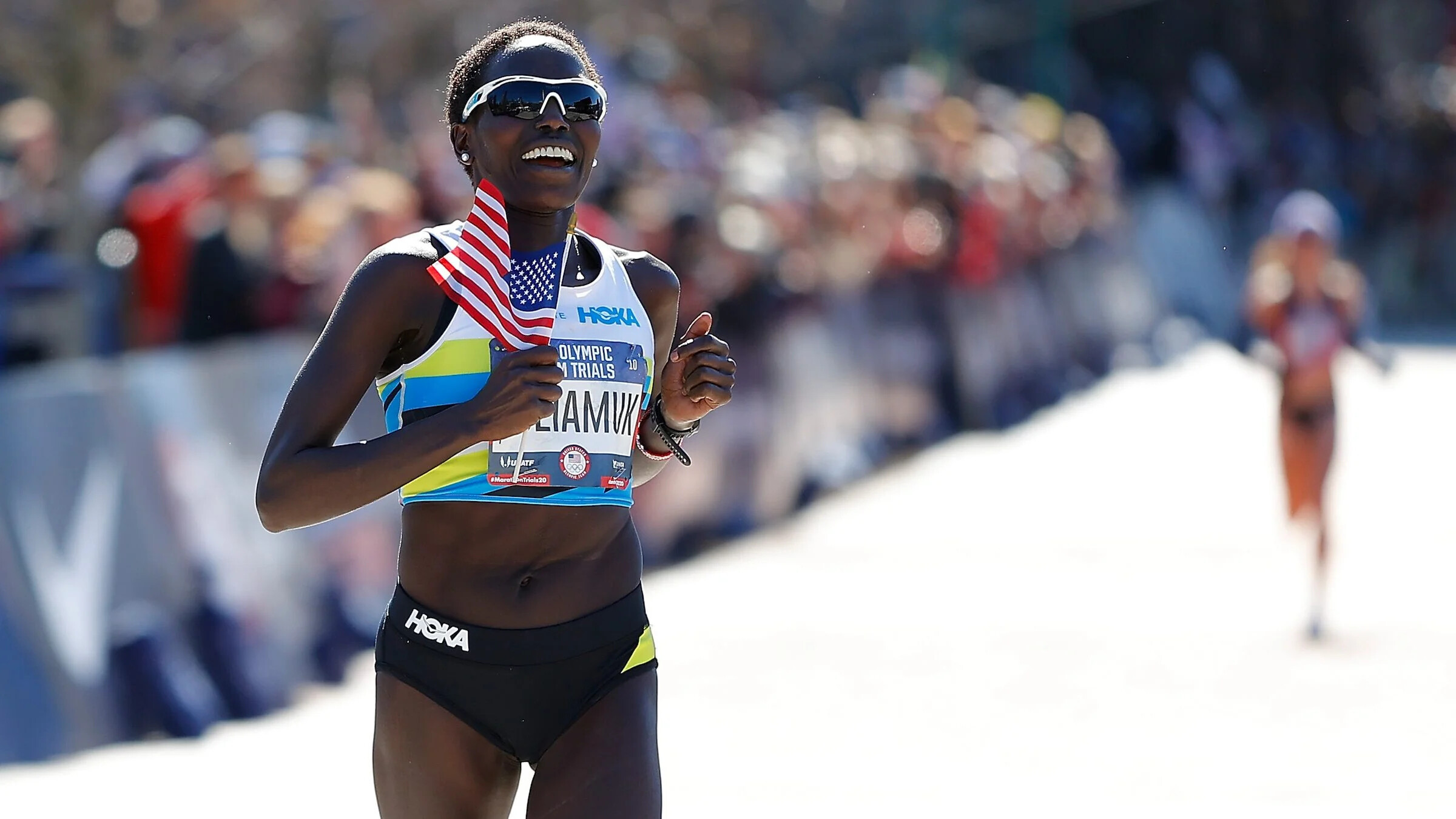
“I’m faster than I’ve ever been before,” she recently told On Her Turf. “And it kind of makes me excited and nervous to see what (the) New York City Marathon brings, because this is going to be the first time I am actually going to complete a marathon since the 2020 Olympic Trials. That’s like, almost three years. So it’s going to be super exciting.”
Tuliamuk won’t have to wait until November, however, to enjoy a visit to the Big Apple. She’ll lace up her sneakers this Saturday, Aug. 13, as a “running buddy” to the young women who participate in the New York Road Runners (NYRR) Run for the Future program. The free, seven-week program introduces 11th- and 12-grade female high schoolers to the sport of running and culminates with this weekend’s NYRR Percy Sutton Harlem 5K.
“Running transformed my life into the life that I have today,” she explains. “I mean, without running I wouldn’t be where I am today. And to know that these girls did not have running experience before, they knew nothing about running, and then they were able to get into running through New York Road Runner feeder program, and now they will be graduating, and I get to run with them? I think that’s just incredible.”
The opportunity comes with an extra layer of “grateful” after Tuliamuk’s most recent injury. She sustained a concussion in February after slipping while training in icy, snowy conditions. She also suffered headaches and temporary memory loss, both of which subsided after about a week but left a lasting impression.
“It just gives you a perspective that like your life could literally, in a second, just turn and be something else,” she says. “This is just me being dramatic, but I could have forgotten completely. And the life that I had would have been something like a past life. I think after that, I was like, ‘Okay, I’m going to try to live life to the fullest.’ I’m going try to be present as much as I can, because you just never know.”
by Lisa Antonucci
Login to leave a comment
TCS New York City Marathon
The first New York City Marathon, organized in 1970 by Fred Lebow and Vince Chiappetta, was held entirely in Central Park. Of 127 entrants, only 55 men finished; the sole female entrant dropped out due to illness. Winners were given inexpensive wristwatches and recycled baseball and bowling trophies. The entry fee was $1 and the total event budget...
more...2022 Carlsbad 5000 Announces Its Elite Field
eigning champion and 17-time NCAA All-American Edward Cheserek headlines men’s race; Olympians Kim Conley and Dom Scott lead women’s elite fields
36-Year Southern California Running Tradition Returns with over 6,000 runners on Sunday, May 22
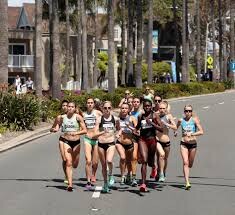
One by one, America’s most famous road races have returned after being waylaid by COVID. The Boston Marathon, Peachtree Road Race, New York City Marathon.
Familiar images unfolded. Runners excitedly talked to friends and strangers in corrals. Spectators delivering high-fives. Medals draped around necks.
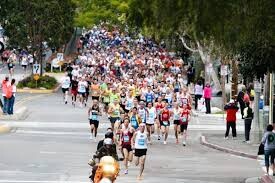
Bolder Boulder, Bay to Breakers, the Los Angeles Marathon.
Come Sunday, the last of the United States’ iconic road races returns after a three-year pandemic hiatus when the Carlsbad 5000 presented by National University celebrates its 36th running. Over 6,000 runners and joggers will enjoy the splash of the surf and clean salt air along the traffic-free Pacific Coast Highway 101, then sipping brews in the Pizza Port Beer Garden.
“I’m excited to return to the Carlsbad 5000,” said reigning champion Ed Cheserek of Kenya. “Last time in 2019 was a lot of fun and after everything our running community has been through since then, I’m really looking forward to being back at the beach in sunny Southern California.”
The Carlsbad 5000 is renowned as “The World’s Fastest 5K” and the moniker was earned.
Sixteen world records have been set on the seaside course, plus a slew of national records and age group bests. Olympic gold medalists Tirunesh Dibaba, Meseret Defar and Eliud Kipchoge have run Carlsbad.
So have U.S. Olympic medalists Deena Kastor and Meb Keflezighi. Keflezighi, the San Diego High product and only male runner in history to win the Boston and New York City marathons, plus an Olympic medal, is now co-owner of the race.
“The San Diego community is very proud of the fact that Carlsbad hosts the world’s most famous 5k race,” said San Diego Track Club coach Paul Greer, a former sub-4-minute miler. “We’re proud of the race. And local runners are endeared by the fact that Meb is involved in the event because he’s one of our own.”
Many people deserve credit for the Carlsbad 5000’s success. Chief among them are Tim Murphy, the race’s creator, Steve Scott, the former American mile record holder who designed the course, and the late Mike Long, the beloved man who built relationships with African athletes and recruited them.
When the race was first held in 1986, the 10K and marathon were road racing’s popular distances. The 5K was considered a casual fun run.
“That’s how innovative Tim was,” said Scott. “He was going to start something when there wasn’t anything there.”
Scott not only designed the course. He won the first three races.
Another plus for The ’Bad: the race fell perfectly on the calendar, with the elite runners being in peak fitness after running the World Cross Country Championships.
“The world records were produced by the quality of the fields and the expectations of running fast,” said road racing historian and announcer Toni Reavis.
It may have been three years since the Carlsbad 5000 was held live (there was a virtual race in 2020), but all the charms will be back Sunday. The custom beer garden IPAs, the ocean views, the left-hand, downhill turn onto Carlsbad Village Drive, and the sprint to the finish.
The race’s official charity is the Lucky Duck Foundation, a local non-profit dedicated to fighting homelessness in San Diego County.
“Homelessness is San Diego’s number one social issue right now, and I couldn’t be prouder to partner with Lucky Duck Foundation as an official charity of the Carlsbad 5000,” said Keflezighi.
As in the past, the Carlsbad 5000 will feature a series of age-group races, starting with the Men’s Masters at 6:55 am, the Women’s Masters at 8:00 am, Open Men at 9:15 am, Open Women at 10:08 am, Junior Carlsbad Kids Mile at 11:20 am, Junior Carlsbad Kids Half-Mile at 12:13 pm, Elite Men at 1:20 pm and Elite Women at 1:23 pm.
The morning-long races create a cheering audience for the pros.
“That’s the other thing that made the elites run fast,” said Reavis. “The crowds.”
So after a three-year pause, the Carlsbad 5000 is back. For why the race continues to maintain its iconic appeal, Reavis said, “It’s those ocean breezes, the lapping waves, the laid-back lifestyle. It is perfect for this little Southern California town which gets transformed into a race course.”
For a complete race day schedule and more, visit Carsbad5000.com.
— Elite Rosters Follow —
Elite Men
Bib Number , Name, Country, Career Highlight, Birthday
1. Edward Cheserek, KENYA, Defending Champion . 17x NCAA Champion, 02/02/1994
2. Kasey Knevelbaad, USA – Flagstaff, 13:24.98 5000M(i) Personal Best, 09/02/1996
3. Reid Buchanan, USA – Mammoth, 2019 Pan American Games 10,000m Silver, 02/03/1993
4. Jose Santana Marin, MEXICO, 2019 Pan American Marathon Silver Medal, 09/03/1989
5. Eben Mosip, KENYA, Road 5k Debut, 12/31/2002
6. James Hunt, GREAT BRITAIN, 4-time Welsh Champion, 04/28/1996
7. Dennis Kipkosgei, Kenya, 2021 Philadelphia Broad Street 10 Miler Champion, 12/20/1994
8. Sean Robertson, USA, Butler University Athlete, 09/16/2001
9. Tate Schienbein, USA – Portland, 2013 U.S. Junior Steeplechase Champion, 04/04/1994
10. Hosava Kretzmann, USA – Flagstaff, AZ, 14:15 5000m PB, 09/02/1994
11. Dylan Belles, USA – Flagstaff, AZ, 2X Olympic Trials Qualifier, 05/16/1993
12. Dylan Marx, USA, San Diego’s Fastest Marathoner, 01/14/1992
13. Steven Martinez, USA – Chula Vista, 2x U.S. Olympic Trials Qualifier, 09/15/1994
14. Spencer Johnson, USA – San Diego, 14:39.09 (2022 Oxy Distance Carnival), 03/20/1995
15. August Pappas, USA – San Diego, 14:05 PB, Big Ten Indoor Track Champs, 04/10/1993
16. Dillon Breen, USA – San Diego, 14:43 Virtual Carlsbad 2020, 09/01/1992
17. Dante Capone, USA – San Diego, Phd Student at Scripps Institute, 11/07/1996
18. Jack Bruce, AUSTRALIA, 13:28.57 5000m Best on Track, 08/31/1994
Elite Women
Bib Number , Name, Country, Career, Highlight, Birthday
20. Kim Conley, USA, One of America’s best 5000m runners, 03/14/1986
21. Dominique Scott, SOUTH AFRICA, Two-time Olympian, 05/24/1992
22. Grace Barnett, USA – Mammoth, Silver at 2021 USATF 5k Championships, 05/29/1995
23. Carina Viljoen SOUTH AFRICA, 5k Road Racing Debut, 04/15/1997
24. Ayla Granados, USA – Castro Valley, 15:53 Personal best, 09/18/1991
25. Biruktayit Degefa, ETHIOPIA, 2022 Crescent City 10k Champion, 09/09/1990
26. Andrea Ramirez Limon, MEXICO, 2021 National 10000m Champion, 11/05/1992
27. Claire Green, USA – San Francisco, NCAA All-American, 05/12/1996
28. Caren Maiyo, KENYA, 5k Road Debut. 7th At 2022 Houston Half Marathon, 04/17/1997
29. Nina Zarina, RUSSIA, California resident, 3rd at the 2021 LA Marathon, 03/17/1987
30. Emily Gallin, USA – Malibu, Finished 4th 2022 LA Marathon, 10/30/1984
31. Lauren Floris, – USA – Oak Park, 2020 U.S. Olympic Trials Qualifier, 07/07/1990
32. Sara Mostatabi, USA – Los Angeles, 09/27/1993
33. Ashley Maton, – USA – Toledo, 16.37 PR at U.S. Road 5k Championships, 11/20/1993
34. Judy Cherotich. KENYA, 16:50 PR
35. Lindsey Sickler, USA – Reno, 16:59 PR, 09/05/1997
36. Megan Cunningham, USA – Flagstaff, 15:53 Track Best 5000M, 03/01/1995
37. Jeannette Mathieu, USA – San Francisco, 2020 Olympic Trials Qualifier, 04/19/1990
38. Bre Guzman, USA – San Diego, 17:37 5k/ 36:00 Road 10k PR, 10/30/1992
39. Aubrey Martin, USA – San Diego, 17:33 5k /1:19 Half Personal Best, 10/10/1997
40. Chloe Gustafson, USA – San Diego, Division II – NCAA All-American, 11/10/1992
41. Sammi Groce, USA – San Diego, 2021 Rock ‘n’ Roll Marathon Winner, 04/29/1994
42. Kristi Gayagoy, USA – San Diego, 17:06 PR
43. Annie Roberts, USA – San Diego, 16:58 5k, 07/10/1996
44. Alexa Yatauro, USA – San Diego, 17:40 5k, 10/18/1995
45. Jessica Watychowicz, USA – Colorado Springs, 15:47.51 5000m Track PB, 02/27/1991
About the Carlsbad 5000
The Carlsbad 5000 annually attracts amateur, competitive and professional runners from around the world. The 36th running of the iconic race will take place on the weekend of May 21-22, 2021. The inaugural 1986 event helped establish the 5K as a standard road running distance, and today, the 5K is the most popular distance in the United States. Throughout its history, the Carlsbad 5000 has seen 16 World records and eight U.S. records, as well as numerous national and age group marks. Race day begins at 7:00 am with the Masters Men (40 years old and over), the first of seven races to take place on Sunday. The “Party by the Sea” gets started as soon as the first runners cross the finish line with participants 21 and older celebrating in the Pizza Port beer garden with two complimentary craft brews and runners of all ages rocking out to live music on the streets of the Carlsbad Village. Further information about the Carlsbad 5000 can be found online at Carlsbad5000.com and on Facebook, Instagram and Twitter.
by Running USA
Login to leave a comment
Carlsbad 5000
The Carlsbad 5000 features a fast and fun seaside course where 16 world records have been set. Both rookie runners and serious speedsters alike enjoy running or walking in Carlsbad. Weekend festivities kick off Saturday morning with the beloved Junior Carlsbad, a kids-only event in the heart of Carlsbad Village featuring fun runs, toddler trots, and diaper dashes! On Sunday,...
more...Molly Seidel despite being a favorite for the 2022 Boston Marathon, still struggles with confidence
The 27-year-old battled with an eating disorder to qualify for the USA Olympic team in her first ever marathon. Despite winning bronze at Tokyo 2020 and being a favorite for the 2022 Boston Marathon, she still struggles with confidence.
Molly Seidel is a rare kind of marathon talent.
The Wisconsin native first made athletics headlines when she qualified in second place for the U.S. Olympic team for Tokyo 2020, in her first ever marathon.
Despite this, many onlookers thought that her inexperience would show at the Olympic race in Sapporo. And how wrong they turned out to be.
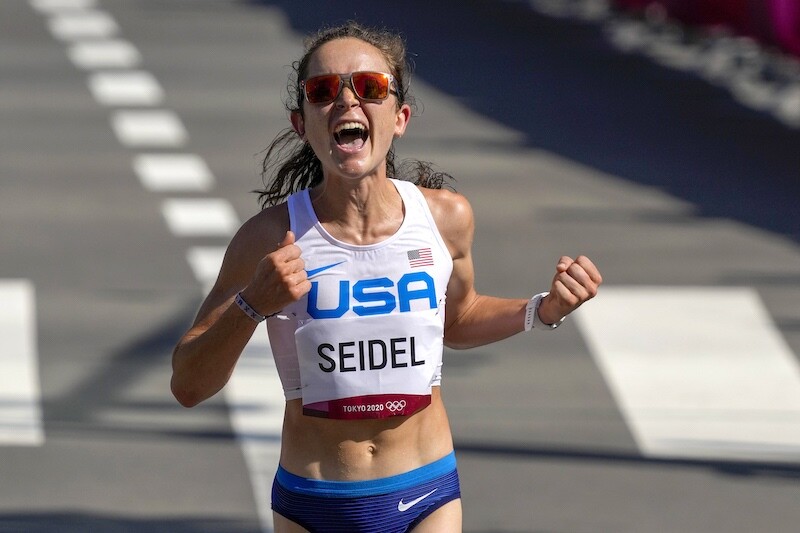
In what was just her third career marathon, she finished on the podium with an Olympic bronze medal around her neck. The only runners to beat her were a triple world half marathon record holder in Peres Jepchirchir, and marathon world record holder Brigid Kosgei.
Using that momentum, Seidel finished fourth at the New York City Marathon in November 2021. Her time of 2:24:42 made her the fastest American woman ever.
On April 18, 2022, she goes to the 2022 Boston Marathon as one of the favorites, seeking the host nation's first win since Desiree Linden in 2018.
But despite her recent successes the American star still struggles with 'imposter syndrome'.
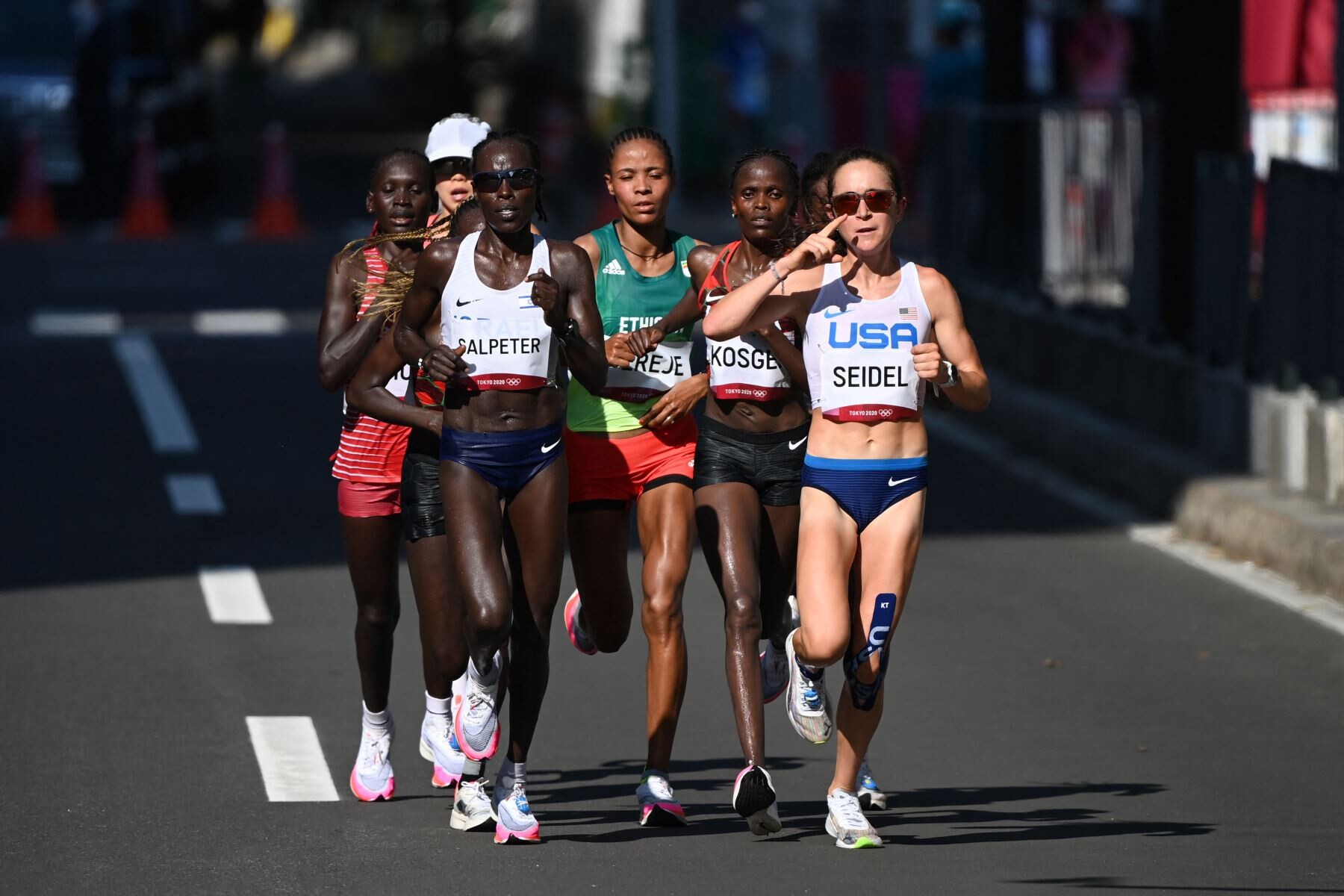
"I struggle with confidence and I struggle with wondering whether or not I belong at this level, whether I belong as a competitor on the world stage," Seidel told CNN.
The making of a front runner
Growing up in Wisconsin, Seidel was always a front runner in school sport. She broke course records and won several state track titles.
The first time her school's cross-country coach Mike Dolan first saw her attack an uphill run, he knew she was special.
“She would be a minute ahead of all the guys and all the girls," Dolan told Milwaukee Journal Sentinel.
"I knew at that time she would be a heck of a runner."
Seidel proved her coach right as she went on to win an NCAA cross country title in 2015, two NCAA indoors (3,000m & 5000m) and an outdoor 10,000m title to become the most decorated distance runner in state history.
Some onlookers even thought she could be a potential U.S. Track Olympic Team athlete for Rio 2016.
Mental health struggles
From the outside, Seidel seemed to be in the best shape of her life, but underneath she was experiencing a deep inner turmoil.
She first went public on her struggles with depression, OCD, crippling anxiety and bulimia in a podcast ran by her close friend Julia Hanlon called "Running On Om", just two months before the 2020 Olympic Trials.
“People who are close to me knew what I was going through during my time at Notre Dame (University), from 2012 to 2016. They knew my OCD had manifested itself into disordered eating,” she revealed in a follow-up interview with ESPN.
“When I was in the NCAA, it was obvious I was battling an eating disorder. It was so obvious that people would write on track and field message boards that I looked sick." - Molly Seidel to ESPN.
“They knew I struggled to eat anything I deemed unhealthy They knew I thought I had to be super lean and super fit all the time, never even allowing myself to eat a bowl of mac and cheese or go out to eat with friends without worrying about what I would order. I've never tried to hide what I went through with my family and friends.”
In 2016 she went into a treatment program for her eating disorder, which she’s still dealing with alongside the anxiety and depression.
When Seidel returned to training, she decided to stop running 5k and 10k and stepped up to the marathon.
“I always kind of dreamed of doing the marathon," Seidel told CNN.
"I think there's just this kind of like glamor and mystery around it, and especially for a younger runner who enjoys doing the distance events in high school, that's kind of the ultimate goal. Everybody wants to do the marathon."
From first marathon to Olympic medal
Her debut 42km race at the USA Trials in Atlanta landed her a place on her nation's Olympic team with race winner Aliphine Tuliamuk and third placed Sally Kipyego.
"I struggled with this kind of imposter syndrome after the trials, specifically as probably the person no one expected to make the team and the person that got probably the most criticism like: Hey, why is this girl on the team?" she continued.
"I think I really struggled with that, and I struggled going into the Games and feeling like I belonged there and trying to prove that I wasn't a mistake on that team."- Molly Seidel to CNN.
Her second marathon effort was the daunting 2020 London Marathon, where she finished sixth .
Then, just 18 months after her first marathon Seidel, who is affectionately known as “Golly Molly” earned bronze and became the third American woman ever to medal in the Olympic marathon.
In November 2021, a broken Seidel returned for her fourth marathon in New York, where she placed fourth with a personal best time despite fracturing two ribs as she prepared for the event.
It was an absolute disaster of a build up,” she recalled.
"It was really hard, not only with the mental stress that we had going on after the Games of just feeling, frankly, no motivation. And just trying to find that drive to re-up for another hard race right after an enormous race that I'd been training effectively two years for.”
Those injuries are now behind the 27-year-old, who has been training in Flagstaff.
Though she dropped out of the New York Half in March due 'setbacks in training', Seidel heads back to Boston where she lived for four years with high hopes for something special.
“Boston was like the place that made me a pro-runner. It was the first place I moved after I finished college.It was the place that kind of like rebuilt me as a runner after going through a lot of challenges through college,” she said to CBS Boston.
“Just getting to do the race in the place that made me the runner that I am and with the people that helped me become the runner that I am, it’s just enormously meaningful to me. That what makes it a lot more special than any other race.”
by Evelyn Watta
Login to leave a comment
Boston Marathon
Among the nation’s oldest athletic clubs, the B.A.A. was established in 1887, and, in 1896, more than half of the U.S. Olympic Team at the first modern games was composed of B.A.A. club members. The Olympic Games provided the inspiration for the first Boston Marathon, which culminated the B.A.A. Games on April 19, 1897. John J. McDermott emerged from a...
more...Why training doesn’t stop after your run
Under Armour’s approach to training is different from its competitors. The company believes that performance doesn’t just come from training, it comes from a holistic approach to running which includes considering emotional, psychological, physiological and nutritional strategies. They call this approach 360 Performance – it means that running doesn’t stop when your watch does and highlights the ways in which training really is all-encompassing. This approach to running may seem daunting, but actually, it’s geared towards balance.
For Aisha Praught-Leer, a UA athlete and 1,500m Olympian, 360 Performance is how she lives her life. “Showing up on race day is such a small part of my existence. Everything else, the getting there, happens in the quiet moments.”
Georgia Ellenwood, Ashley Taylor, Patrick Casey and Aisha Praught-Leer are all professional UA athletes. However, when they talk about 360 performance, they talk about things beyond the nuts and bolts of training. To them, 360 means taking care of your entire being and improving yourself in every way.
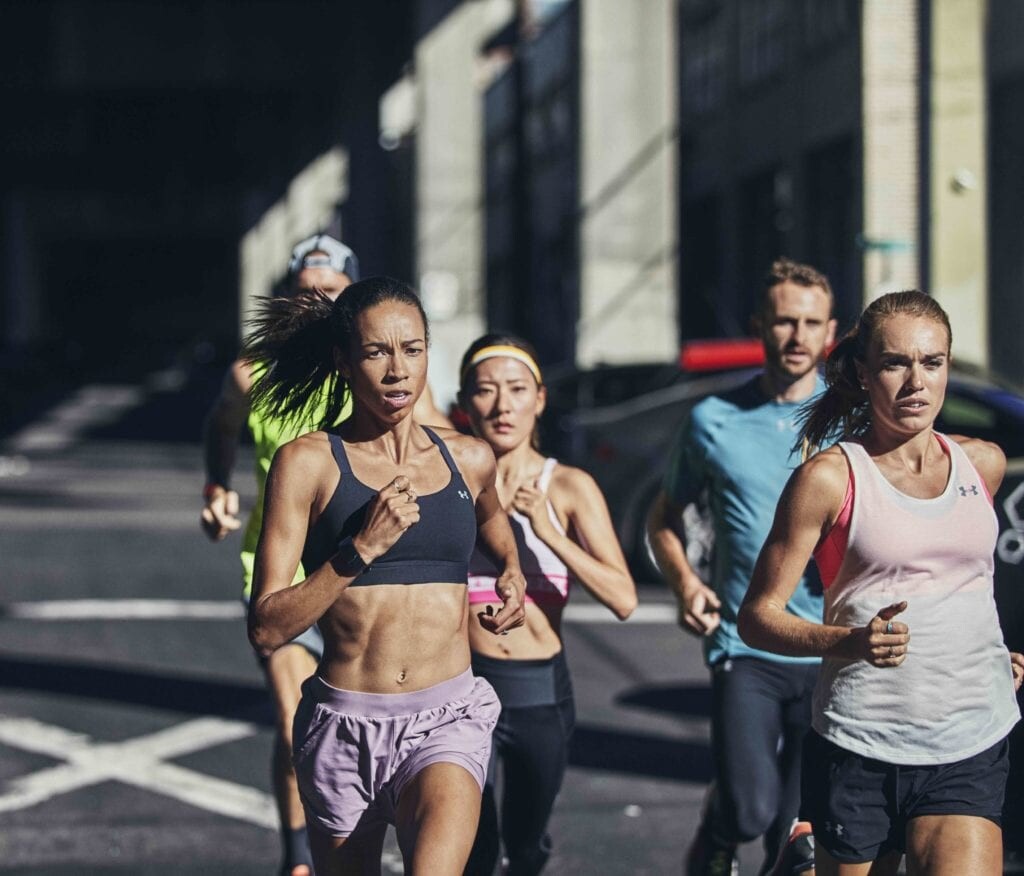
Michael Watts, Under Armour’s Director of Global Athlete Performance, feels that 360 Performance is what sets UA apart. “Every minute and every hour matters in the life of an athlete, if they are not training or competing then they are in a perpetual state of recovery. How they optimize their recovery depends on their own circumstances and journey. We want athletes to become more knowledgeable about themselves and how best to optimize their performance based on their data. Why does it matter? Because the best athletes in the world sweat the details, they are on a constant journey to master their mind, body and craft. We just help guide them.”
Believe in yourself
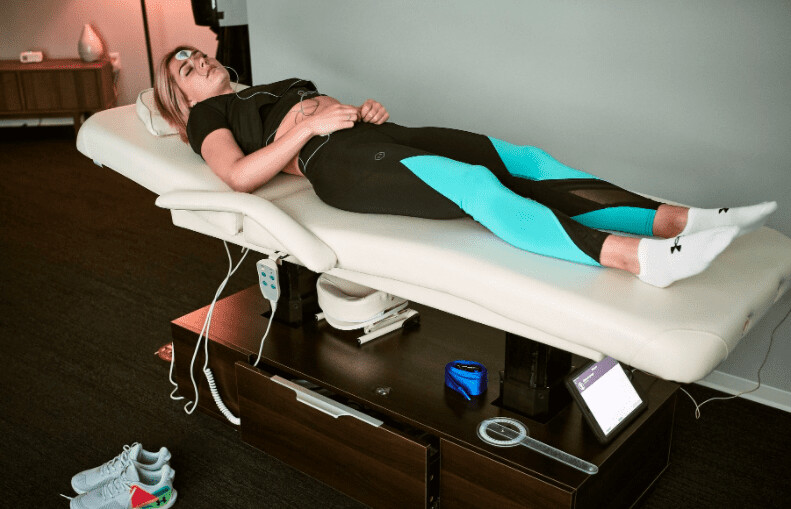
Ellenwood, a Canadian heptathlete, saw a difference in her results when she began to believe in herself. She says 360 Performance means so much more than training – it means emotional, psychological and physiological harmony. Under Armour helped her find this. “I’m a real perfectionist,” Ellenwood says. “I used to be so worried about taking risks in practice, because I didn’t want to look dumb or to fail. But I think sometimes you need to hit a hurdle hard or you need to fall. Do the ugly stuff in training.” Ellenwood says she’s made way more progress after allowing herself to make mistakes and becoming process-oriented, as opposed to obsessing over results.
When it comes to practically preparing for her day, Ellenwood needs to get her body physically and mentally prepared. “Before I even leave the house I do pre-hab, so that means getting my feet ready, I warm up my legs with a heat pack, I have an hour of exercises before I even start practice.”
From there, Ellenwood will train for six to eight hours. In order to maintain that level of activity, she says she takes comfort in her routine and allows rest when needed. “Running is my full-time job and I love it, but sometimes it becomes a lot. If I need to stop for a moment if I’m becoming overwhelmed by the load, I let myself. I’ve learned that stepping away from the track for a minute, to regroup, is ok.”
Be patient
Taylor, a Canadian 800m runner, echoes this statement. She says that she, too, used to place a big emphasis on results, but she feels supported by an organization that sees her as more than a runner. “UA gives us a lot of sport-specific support. But they support us beyond that. They help remind me to love myself through the process and to be patient.” With her goals for 2020 entirely changed, patience has been key.
Casey might be the most patient of the four UA athletes. The American miler has been looking forward to the 2020 Olympic Trials for nearly eight years. After being sidelined due to injury in 2016, he had his sights firmly set on qualifying this July. However, like everyone else, Casey’s plans have changed. He said he’s coping quite well with the new training, and feels like he’ll be ready when the time comes to line up again. “I used to think of running as the two or three hours I’d actually be training everyday. Now I think of it as what I’m doing when I’m not running. How I’m recovering, how I’m preparing myself – because you can only do so much physically in a day.”
It’s a lifestyle
All of the athletes feel that thinking about training in this new way, as a lifestyle as opposed to one aspect of their day, has made them better runners. Aisha Praught-Leer, a 1,500m runner and Olympian, feels like she places more of an emphasis on overall happiness now, which has in turn, made her a better runner.
“Showing up on race day and running a fast time is just a miniscule part of my existence. That’s just the tip of the iceberg. Training is how I’m sleeping, how I’m eating and how I’m keeping myself happy as a person.” Praught-Leer says while she’s a social person at practice, she’s an introvert at heart. For her, she unwinds with a solo run or a self-care routine that she’s perfected. While painting her nails doesn’t seem like training, it helps her unwind. She feels like the better she’s feeling about her life overall, the faster she will run. “My job is high pressure, so it’s imperative to take care of the below-the-surface stuff, to be able to run fast times on race day.”
Praught-Leer has learned that taking care of the below-the-surface stuff needs to be a priority. “Like Under Armour encourages, I really take a holistic approach to my training. It’s not my couple hours a day when I’m training. It’s how I recover, it’s how I’m sleeping, how I’m eating, how I’m hydrating and how I’m keeping myself happy and sane and motivated.”
360 Performance isn’t just about running – it’s actually about everything else outside of training that allows you to enjoy your sport. For the athletes above, running is their job, and they still ensure they’re loving what they do. If running is your leisure activity, enjoyment is even more important. A happy runner is a fast runner, and that’s what Under Armour wants to see in those they support.
by Madeleine Kelly
Login to leave a comment
Olympic Medalists Will Headline 2022 Boston Marathon Women’s Field
Peres Jepchirchir of Kenya, the 2021 Olympic gold medalist in the marathon, and her countrywoman Joyciline Jepkosgei, who ran the fastest marathon of 2021, 2:17:43, when she won the London Marathon, headline the Boston Marathon elite women’s field for 2022.
American Molly Seidel, who won Olympic bronze last summer, will also line up in Hopkinton on April 18.
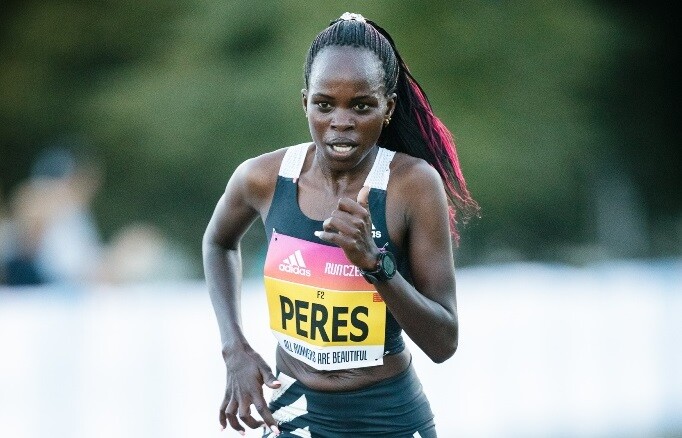
The race marks the 50th anniversary of the first official women’s field at the Boston Marathon. This year’s elite women entrants include Olympic and Paralympic medalists, World Major Marathon champions, and sub-2:20 marathoners.
The race will include four Ethiopians with sub-2:20 credentials: Degitu Azimeraw, Roza Dereje, Zeineba Yimer, and Tigist Girma.
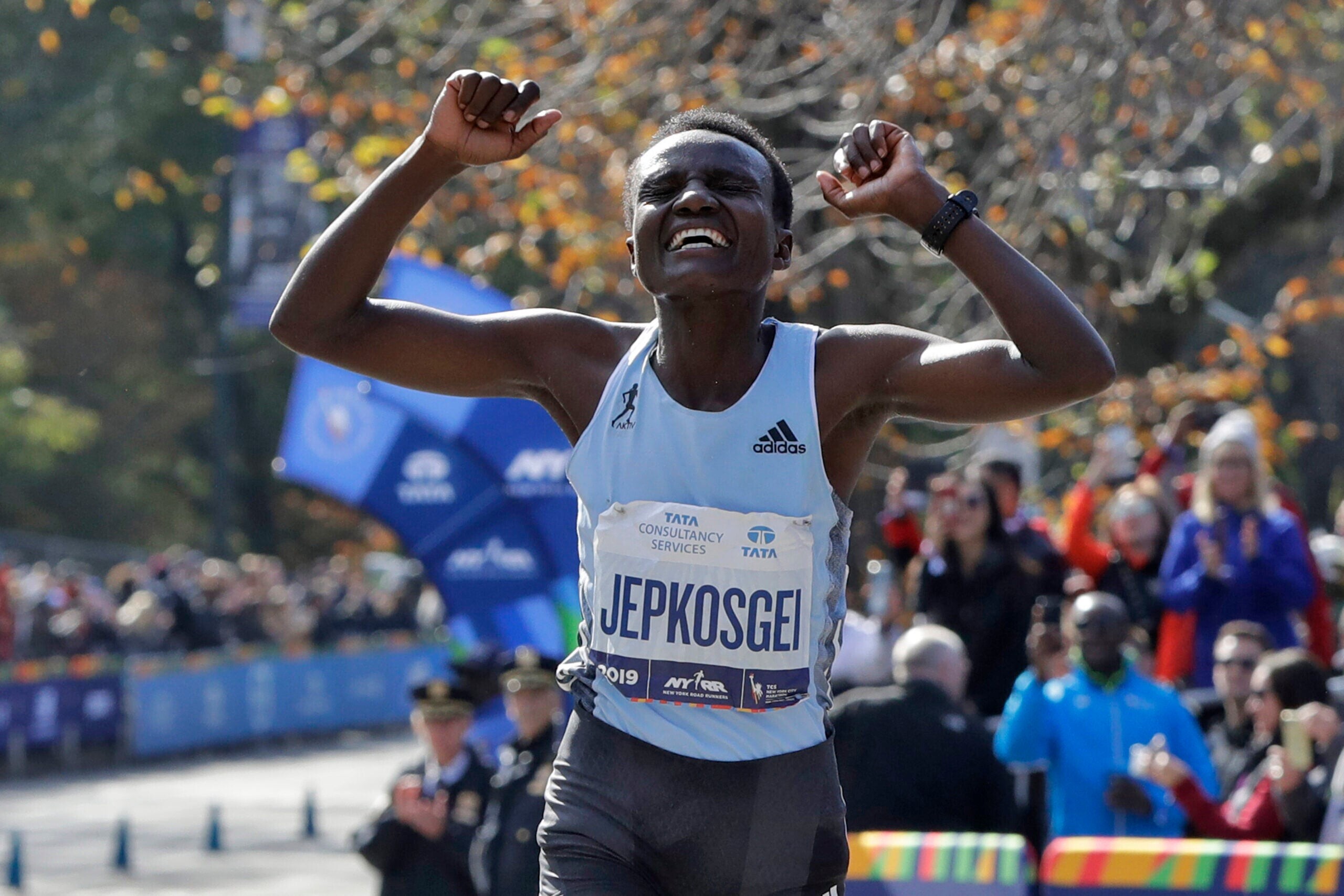
Former Boston Marathon champions Des Linden (2018) and Edna Kiplagat (2017) will race, as will Mary Ngugi of Kenya, who was third in Boston last October.
In addition to Linden, Sara Hall, who is the second-fastest woman in American marathoning history, is part of a strong crop of American talent. Nell Rojas, who was the top American finisher at Boston last year, and top-10 2020 Olympic Trials finishers Kellyn Taylor and Stephanie Bruce are also scheduled to run.
Other notable competitors include Canadian Olympian and national record-holder Malindi Elmore, two-time Canadian Olympian Natasha Wodak, and Charlotte Purdue, who is the third-fastest woman in British marathon history.
The Boston Marathon benefits from being the only World Marathon Major race on the calendar in the spring.
“As we look to celebrate the trailblazing women of 1972, we are delighted to welcome the fastest and most accomplished women’s field in the history of the Boston Marathon,” BAA President and CEO Tom Grilk said in a press release. “Though there have been many milestones in the five decades since the women’s division was established in Boston, this field of Olympic and Paralympic medalists, Boston champions, and global stars will make this a race to remember on Patriots’ Day.”
Elite field
Peres Jepchirchir (KEN) 2:17:16Joyciline Jepkosgei (KEN) 2:17:43Degitu Azimeraw (ETH) 2:17:58Roza Dereje (ETH) 2:18:30Zeineba Yimer (ETH) 2:19:28 Edna Kiplagat (KEN) 2:19:50Tigist Girma (ETH) 2:19:52Maurine Chepkemoi (KEN) 2:20:18Sara Hall (USA) 2:20:32Desiree Linden (USA) 2:22:38Viola Cheptoo (KEN) 2:22:44 Purity Changwony (KEN) 2:22:46Charlotte Purdue (GBR) 2:23:26Kellyn Taylor (USA) 2:24:28Molly Seidel (USA) 2:24:42Malindi Elmore (CAN) 2:24:50Mary Ngugi (KEN) 2:25:20 Monicah Ngige (KEN) 2:25:32Natasha Wodak (CAN) 2:26:19Nell Rojas (USA) 2:27:12 Stephanie Bruce (USA) 2:27:47Dakotah Lindwurm (USA) 2:29:04Roberta Groner (USA) 2:29:09Angie Orjuela (COL) 2:29:12Bria Wetsch (USA) 2:29:50Maegan Krifchin (USA) 2:30:17Elaina Tabb (USA) 2:30:33Lexie Thompson (USA) 2:30:37Kate Landau (USA) 2:31:56
by Chris Hatler
Login to leave a comment
Boston Marathon
Among the nation’s oldest athletic clubs, the B.A.A. was established in 1887, and, in 1896, more than half of the U.S. Olympic Team at the first modern games was composed of B.A.A. club members. The Olympic Games provided the inspiration for the first Boston Marathon, which culminated the B.A.A. Games on April 19, 1897. John J. McDermott emerged from a...
more...Negative Splits Might Be the Epitome of a Successful Run, But They Are Sometimes Overrated
It might be the epitome of a successful run, but negative splits are sometimes overrated. Enter: the controlled fade.
The idea of running negative splits has been so ingrained in us, it’s as rudimentary of a skill for runners as tying your shoes. At some point, every runner needs to learn how to run negative splits or figuratively die trying.
By definition, a negative split is when the second half of your run or race is faster than your first half. The ability to run negative splits teaches you how to manage your energy and pace yourself properly throughout a race or training run. This is ideal because you learn how hard you can push early so you won’t blow up during the second half.
But just as every coin has two sides, so does pacing. On the flip side of negative splits are positive splits. This is where you go out faster and slow down as the run or race goes on. Considered taboo, prevailing wisdom warns against intentionally running positive splits. Positive splits are thought to be associated with pain, embarrassment, and bad outcomes.
However, I think most gamblers would agree that sometimes a calculated move against the prevailing odds can pay out big time. And as certified run coach and runner myself, I think when executed properly, the positive split can be a powerful pacing strategy. One that might just get you that personal record or Boston qualifying time you’ve been working so hard to finally snag. But here's what to know before you start your next run or race on the faster side of your goal pace.
Should you ditch a negative split goal?
The elusive negative split is perhaps as much of a goal in running as setting a personal best. We see the elites do it all the time and it has been well documented that most world records are set with negative splits. But what about the rest of us who aren’t breaking world records? Are there scenarios where one should ditch a negative split? I would say yes.
Justin Ross, Psy.D., a clinical psychologist specializing in health and wellness psychology, human performance, and sports psychology agrees. A runner himself, Dr. Ross explains, “elites are really good at running 26 miles because they've been running 100 plus miles a week for a long time, versus amateurs who just can't maintain that pace for that long of a period because we don't have the training or maybe even the physiological capacity.”
This brings up the question: If we amateurs aren’t running 100 plus miles a week and may not have a superior physiological capacity, should we be mimicking the elites’ negative split pacing strategy? While I do believe the more experienced runners should seek to follow their faster counterparts, I want to offer an alternative for the non-elites. That is, something I call the “controlled fade.”
What is a controlled fade?The controlled fade is a deliberate, positive-split pacing strategy—one that is calculated and won’t lead to blowing up or hitting the wall. It’s a slow, gradual fade in pace. “I don't think we need to fear the positive split if it's done with intention and reason and that the slow fade is really close—like within relatively even splits,” explains Dr. Ross.
Note Dr. Ross’ words “done with intention and reason.” For a controlled fade to be successful, it needs to be a calculated strategy. Dr. Ross warns, “I don’t think we need to be afraid of the positive split, but I do think we need to be careful of it.” This is because the margin for a blowup is much greater than with a negative split strategy. If you’re too ambitious during the first half, a controlled fade will result in a disastrous second half, potentially one that leaves you dragging or walking or just straight up miserable for those latter miles. On the other hand, if executed properly, it can be highly successful.
What’s the benefit of skipping a negative split?
“I think a big part of this is a mindset shift that you don't have to negative split to run a PR,” says Dr. Ross, who set his marathon personal record of 2:57:36 at the 2019 California International Marathon by running 86 seconds faster in the first half of his race—coincidently a positive split.
Mentally, there is a very different mindset between having to pick up the pace at mile 20 to reach your goal when you're already tired versus having time in the bank to fade a little. With the latter, you've met your goal and it's yours to lose and with the former, you don't have the goal and need to chase it when you're already tired. People are more likely to fight to hold onto something they already have than something they never had in the first place.
So that benefit to a controlled fade? It comes down to a pretty positive mental approach to those latter miles—and of course, it could also pay off with a faster finish time.
How do you properly execute the controlled fade?Being honest about your current fitness is crucial for the successful execution of the controlled fade. The best way to get an honest assessment of your capabilities over all race distances is to plug a recent race result into a running pace calculator that projects what an equivalent performance would be across other distances. This will give you an idea of what you are capable of if all things go perfectly on race day.
In most cases, a more realistic goal is to add two to five minutes to what calculators tell you, especially if you’re using race times further away from the marathon such as a 5k time. If your goal falls within that two- to five-minute window, it’s likely to be attainable and suitable for the controlled fade strategy.
A controlled fade works best when you run the first half of your race between a total of 30 seconds and three minutes faster than the second half. This equates to five to ten seconds per mile for the marathon. When pacing the first half of a marathon, aim for five seconds per mile faster than the goal finishing time pace with an absolute speed limit of 10 seconds per mile faster. For example, if you’re trying to break 3:30 for the marathon or run an average 8:00/mile, aim to run the first half at a 7:55/mile pace, never to exceed a 7:50/mile.
The goal is to maintain this pace for as long as you can, expecting you’ll fade at some point. The deeper into the race you hold the pace, the more of a buffer you’ll build against your goal finishing time.
Keep in mind, it’s still important to ease into that faster pace. So starting 10 seconds slower than the goal pace for the first mile may be a good option for some who need a warmup mile. You’ll make up that time by mile four or five if you settle into your planned controlled fade pace by mile two.
When should you use a controlled fade?A controlled fade works best for longer races, such as the marathon, and when there’s a lot of internal pressure to beat a very specific time.
To determine when to use a controlled fade, it comes down to your goals. Dr. Ross points out the difference between outcome goals and performance standards. Outcome goals are a specific outcome you’re pursuing, such as breaking your personal record or qualifying for the Boston Marathon, whereas performance standards are “more about the approach you take to showing up.” For outcome goals, there is a clear delineation between success and failure. You either hit your goal, or you don’t.
“Often what will happen in the course of a race is we recognize that our outcome goals are out the window for whatever reason—the weather isn't cooperating or it's just not our day. At that moment in time, often runners get really defeated and they get frustrated,” Dr. Ross says. Without having a performance standard to fall back on, some runners might give up and completely abandon their goal.
That’s where the controlled fade comes in: Building a small cushion of time to fall back on late in the race allows runners who place a heavy emphasis on outcome goals some room for error, alleviating some of the pressure.
So think about what you want to achieve in your run or if you have that specific goal to chase in your race and whether the controlled fade would work for you.
What do other coaches say?Terry Howell, owner of Blue Collar Running, has coached seven runners to the 2020 Olympic Trials. He agrees the controlled fade is a viable plan for some runners and often builds in a cushion, even for his elite runners. “Depending on the caliber of the athlete, and the condition they’re in, I'm okay with a two-minute cushion on the backside, meaning going slower in the second half.” In an ideal situation, Howell likes to see his athletes somewhere between 30 seconds slower and 30 seconds faster than their goal marathon pace at the halfway point.
On the other hand, Karen Dunn, owner of Strengthen Your Stride and VDOT certified distance coach and RRCA level two run coach, says “it really comes down to knowing your athlete, knowing their history, goals, and mental strength and tenacity.” She believes that an even pace, or slightly negative is the best strategy, but does acknowledge if it’s the right person, a positive split may help some gain confidence.
Is a controlled fade the right approach for you?
At the end of the day, it’s important to steer clear of absolutes. When it comes to a negative-, positive-, or even-split pacing strategy one isn’t always better than the other. It all boils down to the individual runner, race course, and what feels comfortable in a given situation.
However, the only way to find out if one pacing strategy is better for your particular situation is to try it out. If you’re like most runners who have been wired to believe positive splits are synonymous with poor performances, give the controlled fade a try. It could pay off even more than you expect.
by Runner’s World
Login to leave a comment
Nell Rojas was so ready for Boston and ended up sixth setting a PR and finishing first American while Shalane Flanagan finishes her 4th major
The top US woman at the Boston Marathon was Nell Rojas from Boulder, Colo., placing sixth overall in a personal best 2 hours, 27 minutes, 12 seconds. It was her fourth Marathon.
She paced the pack for the first 10 kilometers, which was not part of her plan.
“I was expecting this one to go out fast and to just be able to hang on to the back of the pack,” said Rojas. “I never lead, so that was interesting for me.”
Despite being the top US finisher, Rojas believes she has plenty of room for improvement, citing downhills and staying relaxed in the pack as weaknesses.
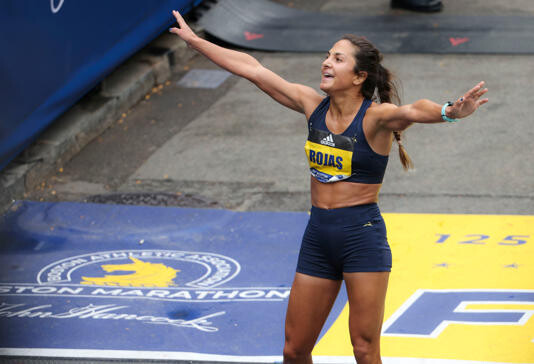
“I learned a lot,” said Rojas. “I think that now that I know the course I can alter my training accordingly and run faster next time.”
Rojas who finished ninth at the 2020 Olympic Trials in 2:30:29, ran for the University of Northern Arizona and spent much of her mid-20s focusing on triathlons before transitioning back to distance running in 2018. Before Monday, her personal best in the marathon was 2:28:06.
Rojas is a coach in Boulder, where she developed a running and strength training program for all ages alongside her father, Ric Rojas.
Nell credits her father with being a role model athletically.
“Just growing up with that inspiration, trying to follow in his footsteps has been super helpful,” she said. “He has been my biggest supporter and cheerleader.”
The second American finisher was Elaina Tabb of Allison Park, Pa., She finished 12th in 2:30:33 in her first major marathon. Much of Tabb’s prior experience came in the half-marathon, where she placed 64th in the 2018 World Championships. She finished 24th at the 2021 Olympic Trials in 10,000 meters.
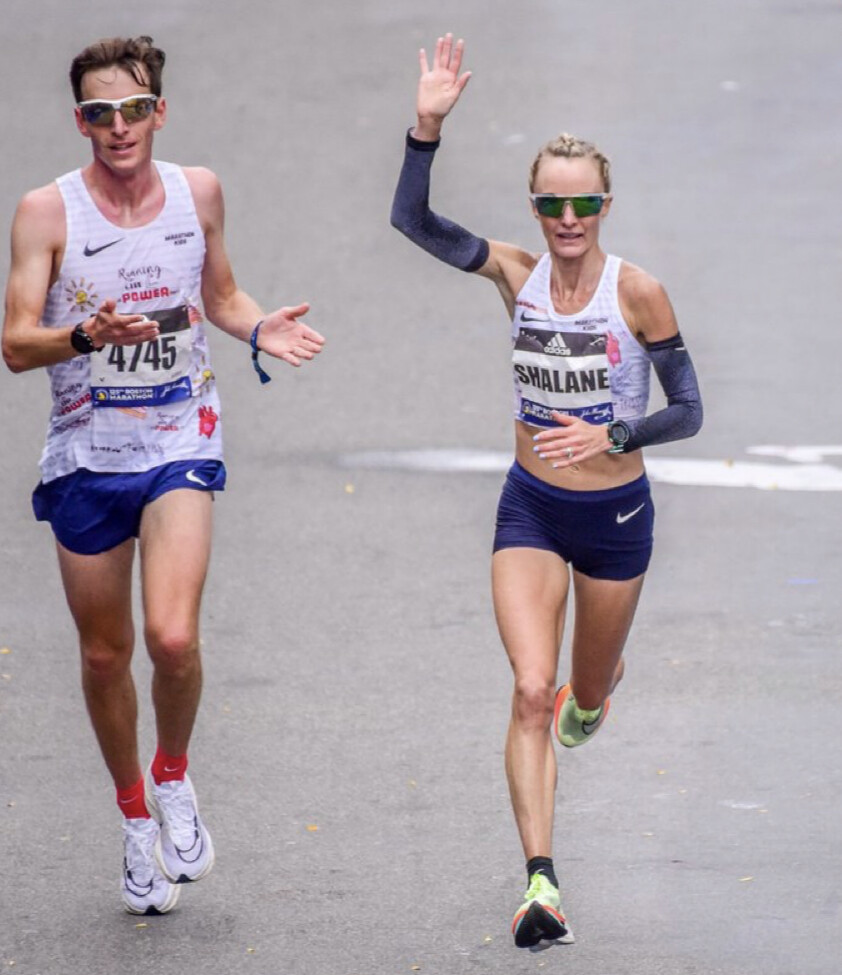
Marblehead native Shalane Flanagan, a former New York City Marathon winner and Olympic 10,000-meter silver medalist, also competed, just one day after running the Chicago Marathon. She placed 33rd on the women’s side in both races, finishing Boston in 2:40:36 and Chicago in 2:46:39. Flanagan retired in 2019 but returned this year in an attempt to run all six majors under three hours. Her average after running four marathons in 16 days is 2:40:13. Her time in Berlin (9/26) was 2:38:32 and London (10/3) 2:35:04.
2018 Boston Marathon champion Desiree Linden placed 16th race with a time of 2:35:25. It wasn’t the performance for Linden hoped for, but she enjoyed the experience on one of her favorite courses.
“I was just excited to get out there,” said Linden. “Yeah, I didn’t have the day that I wanted but it was a pleasure to be back on the course and see the crowds.”
Linden plans to run the New York City Marathon on November 7. Boston was her main focus but is glad to have another race to run.
“It’s nice to have the next one,” said Linden. “To be able to say ‘Hey maybe this one will build and help me get ready for that.’ ”
Login to leave a comment
Boston Marathon
Among the nation’s oldest athletic clubs, the B.A.A. was established in 1887, and, in 1896, more than half of the U.S. Olympic Team at the first modern games was composed of B.A.A. club members. The Olympic Games provided the inspiration for the first Boston Marathon, which culminated the B.A.A. Games on April 19, 1897. John J. McDermott emerged from a...
more...Sara Hall and Sam Chelanga Take USA 10K Titles At the 52nd AJC Peachtree Road Race
Just after the sun rose in Atlanta on an unusually cool July morning, Sara Hall (Asics) and Sam Chelanga (U.S. Army) claimed the USA Track & Field 10-K road running titles at the 51st AJC Peachtree Road race in 31:41 and 28:43, respectively. Both athletes prevailed in late-race battles and each claimed $7,500 in prize money. The race was the third stop of the 2021 USATF Running Circuit.
The women started ahead of the men, and Hall was part of a 15-strong lead pack which quickly formed in the first kilometer. With her were other pre-race favorites, like Steph Bruce and Aliphine Tuliamuk (both of Hoka Northern Arizona Elite) and Gwen Jorgensen of the Nike Bowerman Track Club. But, there were also two less established runners in the lead group, Annie Frisbie and Emily Durgin (adidas).
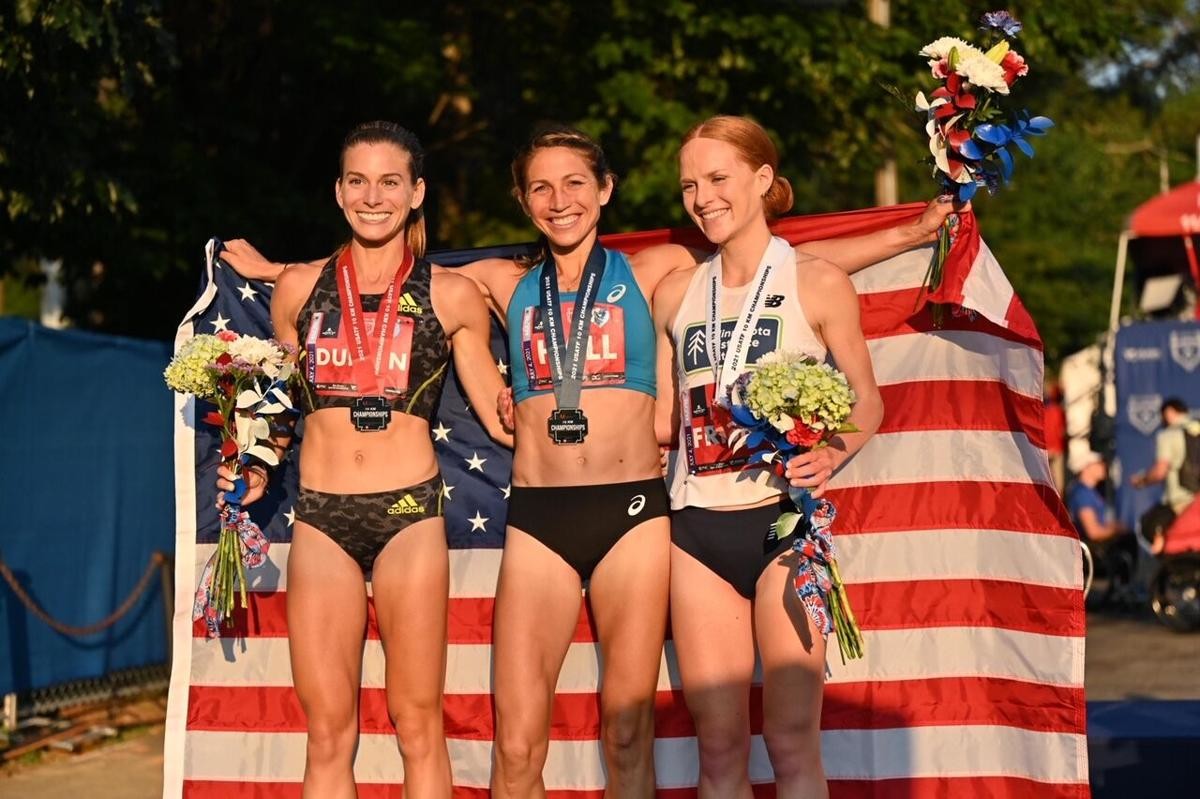
Durgin, 27, who finished ninth in the 10,000m at the USA Olympic Team Trials – Track & Field in Eugene, Ore., eight days ago, led the race through 5 kilometers in an honest 15:46. Hall remained with her as did Frisbie and Tuliamuk, but Bruce and Diane Nukuri (Asics) began to drift back. Durgin kept pressing, and 90 seconds later only Durgin, Hall and Frisbie remained in contention.
Hall, 38, who prior to today had won 10 national road running titles from the mile to the marathon, wasn’t surprised that it was Durgin who was pushing the pace. Both women live and train in Flagstaff, Ariz., and know each other well.
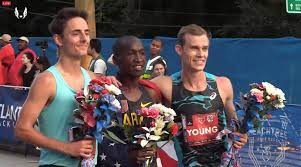
“She’s been running so strong this year,” Hall told Race Results Weekly by telephone. “At the Trials she had a great one. So, I didn’t really know who would be charging out there.”
At about the 7-kilometer mark Hall and Durgin increased the pace, and Frisbie (who is only 24) had to drop back. The two women spent most of the next three kilometers running side by side waiting for the right moment surge for the finish line. As she did at the Mastercard New York Mini 10-K on June 12, Hall finally showed her cards in the final 400 meters. She pulled away strongly from Durgin to win by eight seconds.
“That’s the first time I’ve kind of gone toe-to-toe with her in a race,” Hall said of Durgin. “She’s got a great future ahead of her. I’m excited to see what she does.” She added: “I’m really proud of her.”
Durgin set a personal best of 31:49, as did Frisbie in third (32:06). Nukuri rallied in the last two kilometers to finish fourth in 32:27, and Bruce (who won this race in 2018) got fifth in 32:35. Tuliamuk, the 2020 Olympic Trials Marathon winner, finished sixth in 32:43.
For Hall, today’s win lifted her spirits after she finished sixth at the Olympic Trials in the 10,000m, likely her final attempt at making an Olympic team on the track. She also felt like she got some payback for a bad race at the 2020 Olympic Trials Marathon, also held in Atlanta, where she was unable to finish.
“You know, I was wanting to kind of get through the hills,” Hall said of the middle portion of today’s race. “Obviously, these Atlanta hills crushed me in the Trials. So, I definitely wanted to have a strong run over those hills.” She continued: “Going into this race I just wanted to have fun out there… This was an opportunity for me to just to out there and enjoy racing.”
For Chelanga, today’s win was his first USA title since he won the 25-K crown in May, 2018, just before he said he was hanging up his racing flats.
“I had announced that I had retired after July 4th of 2018,” Chelanga said in his post-race television interview. “Then when I got back in the Army, people noticed in the physical test that I was really fast, and I ran the 10-miler for the Army team (October, 2019). So I did it. Long story, but now I’m back here.”
by LetsRun
Login to leave a comment
AJC Peachtree Road Race
The AJC Peachtree Road Race, organized by the Atlanta Track Club, is the largest 10K in the world. In its 48th running, the AJC Peachtree Road Race has become a Fourth of July tradition for thousands of people throughout the metro Atlanta area and beyond. Come kick off your Fourth of July festivities with us! If you did not get...
more...Sarah Lancaster was born to run but she also excelled in tennis and basketball too
If you’ve spent early mornings on the trails near downtown Austin, Texas you’ve probably crossed paths with Sarah Lancaster — 5 feet, 8 inches of mostly limbs and ponytail, casually eating up miles faster than you could drive on the Hike and Bike Trail, or sprinting so fast around the Austin High track off Lady Bird Lake that her male training partners have to tag each other in for pacing duty.
Lancaster is not just the fastest runner in Austin. She's one of the fastest women in the entire country, and she's competing at the U.S. Olympic Trials in Eugene, Ore., on Friday in both the 1,500- and 5,000-meter runs.
Her personal bests of 4 minutes, 5.55 seconds and 15:13.56 are only a few seconds off the Olympic standards of 4:04.20 and 15:10, meaning she can make this summer's Tokyo Olympics team if she can shave a few seconds off her best times and place in the top three.
Texas legend Trey Hardee, a 2012 Olympic silver medalist in the decathlon, recently declared Lancaster the best athlete in Longhorns history on Twitter, although that actually has as much to do with her pedigree as a dual-sport athlete at UT in tennis and basketball as it does her running resume.
At 33 years old, Lancaster is nearly 15 years behind most of her competitors in terms of specific training for distance running. She works full-time as an attorney in Austin, but nearly everyone who has run with her or coached her agrees: the former tennis ace possesses an unbeatable work ethic and killer instinct that makes her a natural on the track, no matter how late she found the sport.
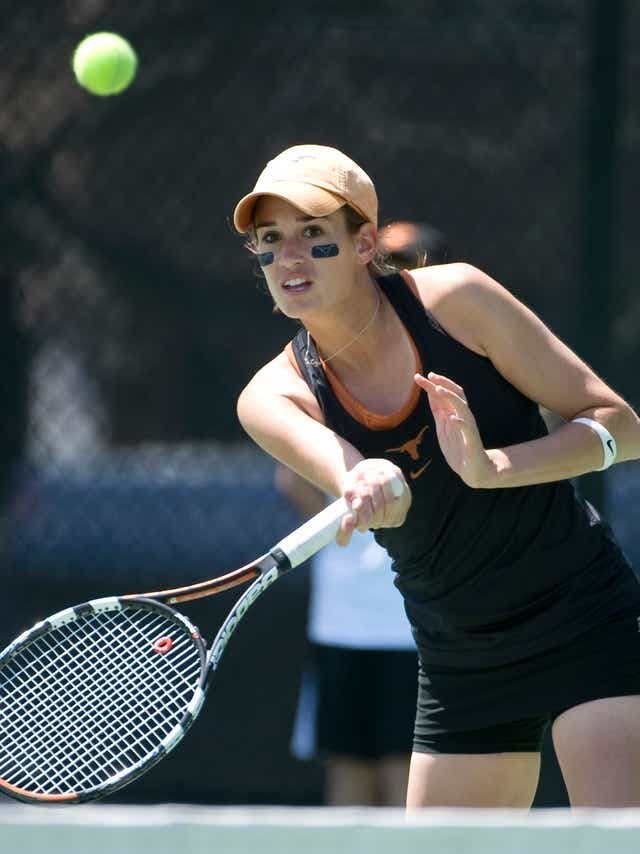
Tennis beginnings
Lancaster grew up in San Antonio playing every sport offered, but quickly found herself drawn to tennis and basketball. She started taking tennis lessons when she was six years old and was competing in statewide tournaments by the time she was 11.
Lancaster's mother, Kelly, says Sarah was competitive "in everything. It wasn't necessarily sports," and that she inadvertently stoked the fire a few times when Sarah drew a tough opponent during a travel tournament.
“I would say, ‘Oh gosh, you play so-and-so today, I just hope you get a point,’” Kelly Lancaster said. “Because maybe it was one of the top girls in Texas. She’s commented that I’d pack up our bags to check out of the hotel because I knew she was playing somebody (who was a top seed). And you can always go check back in, but if you don’t check out by 10 or 11, then you have to pay for a whole ‘nother day.
“She said, ‘I’d see mom packing up the bags and think, ‘Obviously, she doesn’t think I’m gonna win today, so I’m gonna show her!' I really didn’t do it for that reason. I was thinking, ‘We’re done, I’m tired, we’re going home.’ Little things like that, I guess, motivated her a little bit to prove me wrong.”
Lancaster played tennis, basketball and ran track during her freshman year at Alamo Heights High School before deciding to enroll in a tennis academy that her coach established more than 200 miles away in Conroe. The academy is no longer in existence, but at the time was affiliated with John Roddick, the older brother of tennis star Andy Roddick.
“I was 15 at the time and, looking back at it, I can’t believe my parents let me do that,” Lancaster said.
A typical day at the tennis academy included two hours of practice in the morning, home school sessions for five to six hours, and another afternoon practice session that could last anywhere from two to three hours. There were about five other female boarders, more young men, and a number of local kids from the area who drove in for practice every day.
“We had a good time,” Lancaster said. “It was definitely not your normal high school experience. ... We were at tournaments a lot, we would go to the movies or just normal things like that ... (but) you’re there to play tennis and you’re there to get good, you’re not there to be partying and having fun.”
Lancaster thrived in the environment, improving her national and state rankings to become one of the best players in Texas.
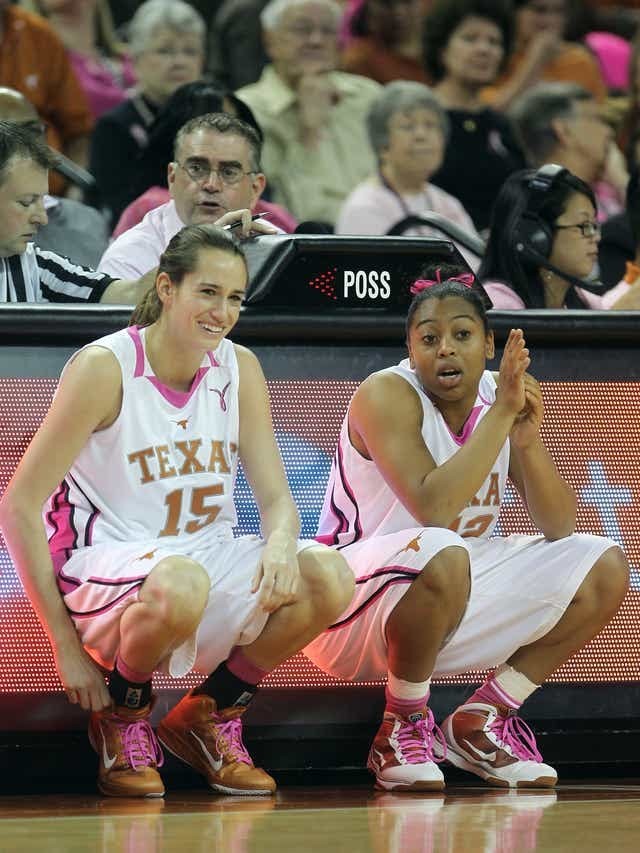
“For me, it was — I want to go and I want to get as good as I can and see what I can do,” she said of her motivation to attend the tennis academy. “Maybe a little part of me thought I was going to play professionally one day, but I think the focus for me was more on college ... making sure I was going to be recruited.”
Lancaster committed to Texas — "hands down my first choice" — but then suffered a stress fracture in her back and had to take a few months off from tennis. She moved back home and re-enrolled at Alamo Heights, where her old friends convinced her to play basketball again.
It was an easy sell. After all, she was already the best player when she was only a freshman.
"I talked to the UT tennis coach," Lancaster said. "'Hey, you know, I'd kind of like to play basketball. I think it would be fun for me and it might be good for me, coming back from this injury, to do a different sport.'" And she was agreeable to it as long as I taped my ankles for every practice or game."
The move was eerily prescient for her career at Texas. Also prescient — she ran a few track races (she said her best time was a 58-second 400 meters as a freshman).
Texas fight
Given her experience living away from home at the tennis academy, Lancaster’s transition to college and NCAA athletics was pretty seamless. The Texas women’s tennis team, which recently captured its third national championship, was solidly ranked within the top 10 to 20 programs in the nation during her years there, and as a senior in 2010, she helped the Longhorns to the Sweet 16 round of the NCAA Tournament while totaling a 25-8 singles record, including an 11-0 mark in the Big 12.
“She is one of the best competitors I ever coached,” former UT women’s tennis coach Patty Fendick-McCain said in a text message. “She was the most solid player I ever coached at her position and when the chips were down, I always knew she would come through. She didn’t care what line she played, but that she would get a ‘W’ and contribute to the team.”
Of her own heroics on the court, Lancaster says simply that her personal highlight of her college tennis career was “probably the fact that we beat A&M every time we played them.”
Bored over the summer after her senior year and with one extra semester of school to complete, Lancaster and one of her tennis teammates filmed a video of her doing a trick layup shot. They sent it to their coach, who forwarded the video to the women’s basketball coach at the time, Gail Goestenkors.
To Lancaster’s surprise, Goestenkors told her to go play some pick-up games that summer with the team.
"I went and played with them over the summer, and it was really just pick-up games, coaches couldn't come," Lancaster said. "I didn't really feel like I was completely in over my head, you know — I wasn't like, 'Oh, I'm better than any of these people that have been playing their whole lives and have been recruited to play at the University of Texas,' (but) I felt like I could hold my own."
Sight unseen, based on positive feedback from the players on the team, Lancaster was invited to officially join the roster in the fall.
"None of the coaches had ever seen me play and they basically told me that they would let me play on the team, which was a little bit terrifying,” she said. “The first practice, I was like, please do not miss a layup, please do not miss a layup.
"I think part of it was, the team was really young, there were six or seven freshmen. There was really only one other senior at the time on the team and I think they were just kind of like, 'Sarah knows how to be a student-athlete, she can help these freshmen.' And I guess they confirmed with some other people that I wasn't a terrible basketball player."
Lancaster stepped into the leadership role naturally, had fun at practice and was fine with getting less minutes as the season went on. Her personal highlight from her basketball career didn’t even take place in the Big 12.
"My only basketball highlight is in seventh grade, when I scored 46 points in a game," she said with a straight face.
'That’s just not something you see every day'
Paras Shah remembers the first time Lancaster showed up to a casual evening workout with RAW Running a few years ago. She made it up Wilke Road — a notoriously brutal 300-meter, 10.8% grade hill in the Barton Hills neighborhood — for all eight repeats, just a few strides behind Shah and the other former NCAA Division I male runners in the group.
"I asked her where she ran in college and she said she didn’t," said Shah, who ran at LSU. "(I thought) that’s obviously not possible. I just didn’t believe her.”
Lancaster was always naturally fast.
In mile time trials throughout her athletic career, she’d routinely clock in just under 5:30.
"Every running drill we did, Sarah was fastest and had the best endurance," Fendick-McCain said. "Her attitude was to leave blood on the court if necessary. She had better endurance than any other player I ever coached or that she played against. If it was a test of wills and endurance, she would always find a way to win."
When Lancaster started law school, she played in various recreational leagues and just had fun ("law school was the most free time I've ever had in my life," she said) while casually completing her first half-marathon. But a few years into the workforce, she happened to meet UT club running coach Kyle Higdon, a UT graduate student, and she asked him to train her to break five minutes in the mile.
"I just felt like that would be a cool thing to say I could do," she said. "And I had actually talked to multiple guys who told me that they tried to do it and couldn't do it. So I was, you know, even more motivated to try."
With light mileage (20-25 miles per week) and a few basic workouts under her belt, she clocked 4:46 in her first 1,500 meter race — the equivalent of a 5:07 mile. By the end of the spring, she had improved to about 4:30 for the 1,500, an incredible time for a brand new runner, albeit one who was 28.
As she watched the Rio Olympics that summer, she wondered: Could she qualify for the 2020 Olympic Trials?
“I had no concept of what a good time was,” she said.
The idea of the Trials wasn’t quite a solidified goal at that point — just a little bug in her head that popped up every now and then. With Higdon finishing his studies and moving on with his career, Lancaster evaluated her group running options, which, in Austin, are mostly marathon training groups that meet in the wee hours of the morning, or more casual after-work clubs.
She chose the latter, and started showing up to RAW. That’s where she met Shah, who helps organize the annual Schrader 1600 every May for high school runners and members of the community.
At the 2018 event, with about two years of casual training under her belt, Lancaster ran 4:37.55 for 1,600 meters. The girl who kicked the boys’ butts at RAW workouts every Tuesday was legit.
Mike Kurvath remembers the race very vividly. Then 28, the Rochester Institute of Technology (RIT) track alum ran 4:17 in his section. At the time, he was thinking of moving on from running competitively.
"I remember that very specifically, because in the final 200 meters, she elbowed her way through a couple of high schoolers and it was a really strong move," Kurvath said. "That’s just not something you see every day.
"I was thinking that I was going to be done with running. After I saw that race ... it was actually quite inspiring. After a couple weeks of training with Sarah, you knew the potential was there. It gave me a second chance at my own running."
Kevin Kimball, a UT track alum, offered to help train her.
"Kevin was like, 'you could definitely run the Olympic Trials qualifying time,'" Lancaster said. “In the back of my mind, I had always thought I could … I haven't really been doing that much training and I can already run this fast, like, why can't I run, you know, sub-4:10 in the 1,500? I mean, looking back, that is kind of crazy to think about, but it probably benefited me that I had no real knowledge of running because I didn't see any limitations for myself.”
To make the 2021 Olympic Trials, the qualifying time in the 1,500 meters was 4:06, the equivalent of a 4:25 mile and 4:24 1,600 — a full 13 seconds faster than she had just run.
"Kevin was like, 'I think you can do it,' and I was like, 'all right, well, I'll give it a go.'"
2021 Olympic Trials
Lancaster definitely falls into the camp of athletes who benefited from having an extra pandemic year to train in preparation for the Olympic Trials.
She struggled with injuries in 2019 but regained form in early 2020, running an impressive 15:56 in a 5K time trial at the beginning of the pandemic. That made her consider switching events. She improved her time to 15:34 in December, then ran her Olympic Trials qualifying marks in a two-week period in May.
The major change she made in that six-month period was working with 1996 Olympian Juli Benson. The longtime coach has mentored some of the world’s best distance runners, including Jenny Simpson, whom she guided to a gold medal in the 1,500 at the 2011 World Championships.
"I was very taken aback," Benson said when Lancaster reached out to her. "That’s how unusual it is. I’ve been in the sport for a very long time and her story is really unique.
"I was certainly curious, but it was fairly late into the Olympic year to take on a new athlete who was trying to qualify for the Trials, but her story was so unique and her approach and perspective so intriguing that I definitely wanted to take up the challenge and she’s proven to be remarkable at every turn.
"She can handle everything I throw at her and it’s been really fun. It’s so rare and unique and surprising and refreshing and all of those adjectives, but she is an incredible athlete, I’ll say that."
For the Trials, Lancaster decided to focus on the 1,500, where she's the 14th seed, but also declared in the 5,000, where she's the 17th seed, as a backup plan in case she were to fall or otherwise not advance from her preliminary race. The first round of both races are Friday; the finals are on Monday.
Kurvath, who recently clocked his own personal best of 14:34 in the 5,000, said he knows Lancaster is capable of breaking the 15-minute barrier because they do all of their workouts together.
"I’ve seen it. I’ve seen the workouts, I’ve done the workouts," he said. "She’s been there with me and I just ran 14:34."
Benson thinks Lancaster is just tapping the surface of what she can do in the sport.
"The other thing that's really, really fascinating about Sarah — she has got the most incredible race instincts," Benson said. "She races as if she's been on a world-class stage for seven or eight years. Her instincts are brilliant. ... I think she really loves to compete and it’s really no more complicated than that. Yes, she has interesting genetics, yes, she has really interesting talent, but I think she keeps it really simple and just wants to go out and see how many people she can beat.”
Lancaster isn’t sure if she’ll keep racing after this year. The World Athletics Championships are hosted by the United States next year, which presents a unique opportunity. She’s engaged to be married this fall. She’ll be 34 next year. For right now, it’s all about soaking in the realization of a long-awaited dream.
And no, she’s not totally sure where her affinity for middle-distance running comes from, either.
"Tennis is an individual sport," she said. "It’s a high-pressure situation, you know you’re out there playing someone and you can only look at yourself (for) the outcome. You can’t blame anyone else. I think that translates to running. It’s you out there.
"I think I’ve always just wanted to win, I’ve always wanted to compete well and that’s just kind of ingrained in me. So I don’t know if I have a better answer for you than that.”
by Johanna Gretschel
Login to leave a comment
Canadian Malindi Elmore recovered from injury is getting ready to race in Houston
The 2020 Houston Chevron Marathon is less than two weeks away, and while it’s technically an American race, it also serves as the winter running event of choice for the many Canadian runners. For the 2020 edition lots of Canadian elites are heading south of the border to try and run fast times, but a race we’re particularly excited to see is Malindi Elmore’s.
Elmore shocked Canadian runners a year ago when she ran a 2:32 marathon debut in Houston, which she would later describe as “a fun family project.” Since her debut, Elmore’s cranked out several impressive times, including a 1:11:08 half-marathon and a 32:44 10K. The original plan was to run the Scotiabank Toronto Waterfront Marathon, which doubled as the 2020 Olympic Trials. Elmore pulled out one week from the race due to a hamstring injury.
Elmore was targeting the Olympic standard of 2:29:30 and the automatic qualification spot that came from winning STWM. If she was successful, she would have qualified for her second Olympic team, 16 years and two babies after qualifying for her first (she competed in the 2004 Olympics for the 1,500m). The runner still has until May to run standard and put herself in the conversation for the Olympic team, but making the 2020 marathon squad will be harder than ever.
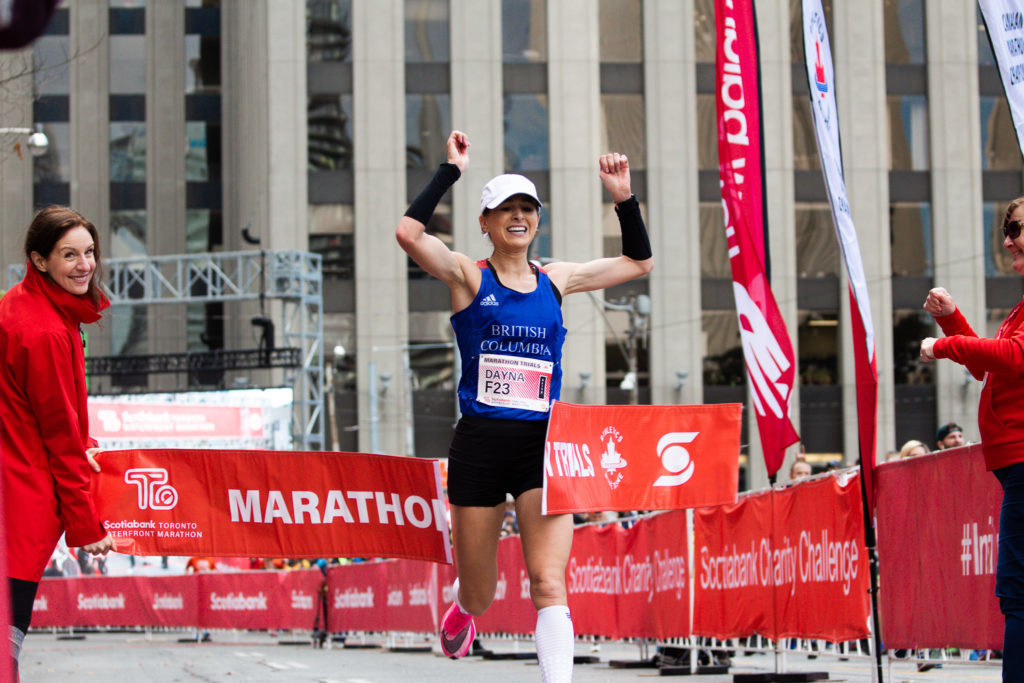
Canada can send up to three runners, but with Dayna Pidhoresky’s spot already guaranteed, Lyndsay Tessier’s top-10 finish at the World Championships acting as the equivalent to standard and Rachel Cliff knocking off the year with a new Canadian half-marathon record, the Canadian women’s road scene is deeper than it has been in years.
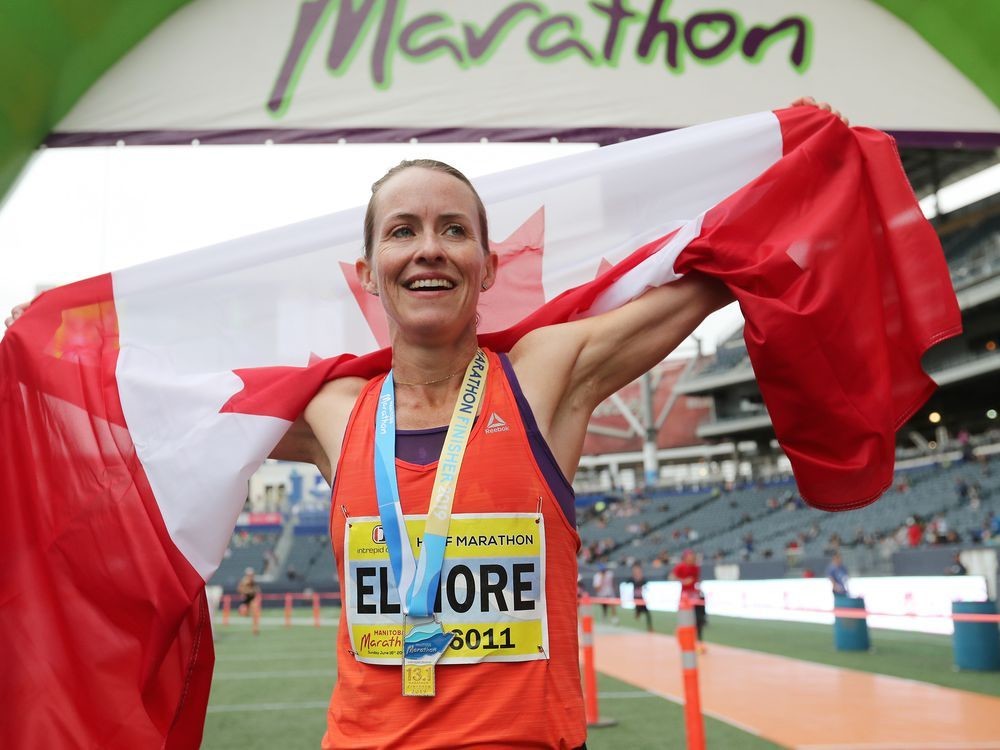
If Elmore is able to run under standard (2:29:30), there will be four Canadian women who’ve achieved it. And that’s not including Emily Setlack, who was only 18 seconds off at STWM. It’s far from cut-and-dried when it comes to who will be making this Olympic marathon team. There were years when Canada was excited to send one runner, and now there will likely be a marathoner, with standard, who won’t make the team.
But personally, Elmore isn’t overly concerned about the standard. “My goal is to run as fast as I can run, and if I perform how I think I’m capable of, it’ll land me within standard.”
The runner says that this build has been a little different than her first, due to her past injury. “Returning from injury wasn’t too bad, it took me about four weeks. That’s a pretty quick turn-around, all things considered. It was certainly a shorter build than I anticipated because I wasn’t starting from scratch.” Elmore was still working with the fitness she’d gained leading up to Scotia. She says she was very happy to see Pidhoresky and Hofbauer’s performances at STWM. “It was a really exciting race to watch. I was really happy for them and really happy to see how well they’d done.”
When asked about how Canadian running has changed over the past 20 years, Elmore says that connectedness is the biggest difference. “There’s a connection between runners and the public now. I felt much more alone doing my training and racing in 2004. Running was my personal story that I shared with people closest to me but it wasn’t available publicly the way things are now with social media.”
Elmore jokes that when she ran her lifetime personal best in the 1,500m she didn’t know for about an hour, because the results weren’t available. Then, she couldn’t tell her loved ones until she got back to the hotel and made the collect call home. “Now I put a workout up on Strava and get immediate kudos. I think there’s a greater awareness of what people are trying to achieve and what they’re doing to get there. It’s easier to build and maintain a community through technology where we can cheer people on from a distance.”
by Madeleine Kelly
Login to leave a comment
Chevron Houston Marathon
The Chevron Houston Marathon offers participants a unique running experience in America's fourth largest city. The fast, flat, scenic single-loop course has been ranked as the "fastest winter marathon" and "second fastest marathon overall" by Ultimate Guide To Marathons. Additionally, with more than 200,000 spectators annually, the Chevron Houston Marathon enjoys tremendous crowd support. Established in 1972, the Houston Marathon...
more...Eric Finan is dealing with a broken toe, heading for the 2020 Olympic trials
The injury is the result of a mountain bike incident, but it sounds like only a minor setback for his training to run the marathon in the 2020 Olympic trials in Atlanta, Georgia, on Feb. 29. He’s optimistic that he’ll soon be running 100 miles a week again.
Finan has made many major life decisions based on running, and when he runs at the trials on Leap Day, he’s accomplishing a goal that he once thought had disappeared years ago.
Before moving to Eugene in 2015, Finan attended University of Cincinnati because he wanted to pursue engineering while also running in a competitive collegiate conference. After graduating in 2012, he wanted to run in a post-collegiate group, but because he was injured during the last part of his fifth season, he says those running groups didn’t want him.
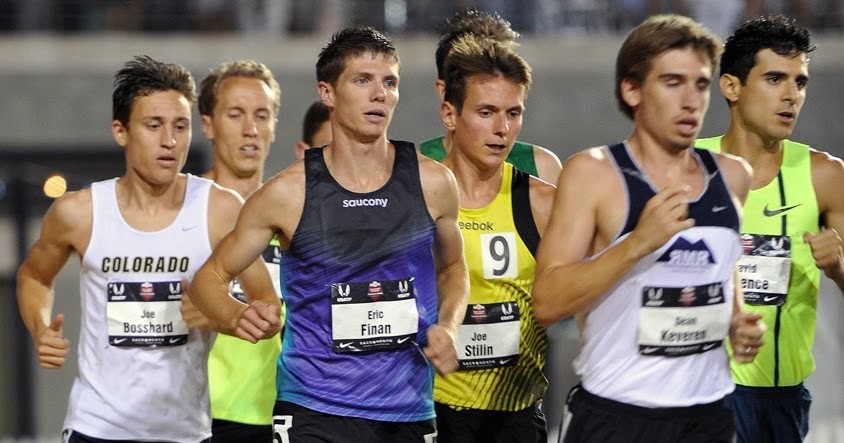
He worked in Cincinnati for a year and got healthy. In 2013, he ran the U.S. Half Marathon Championships in Minnesota, finishing in 1:04:42. He attracted the attention of Team USA Minnesota, so he moved to Minneapolis to run with the group.
But after again suffering some injuries from the higher-intensity philosophy of the coach there, Finan says he decided to run with Team Run Eugene, so he looked for work in the area.
Today, Finan is coached by Tim Sykes, who was a volunteer assistant coach at the University of Oregon before moving to Western Kentucky University for a full-time coaching job.
A self-described realist, Finan says he’s not expecting to make it in the top three on the U.S. team that would compete in Tokyo. Judging by the results from the 2012 Olympic trials in Houston, to make the team he’d need to finish under 2:10 — meaning he’d have to run a 5-minute pace.

He’s setting the bar at a top-25 finish, but he’s not necessarily running the trials to make the team. It’s about completing promises he made to himself while in high school.
He set two life goals then: to run a 4-minute mile and run in the Olympic trials. He completed the first goal, but missed the second goal in 2016 by seven seconds and didn’t make the trials for the 5k event.
Finan says he was devastated that he didn’t make the trials. He didn’t run for a few months and drank and ate to excess.
“I had my mind set on the trials. I had my heart set, my body, my soul to compete in the Olympic trials,” he says. “I believed it in my entire being that this thing was going to be true.”
He adds that he took it as a given that he would be running in the trials and was already thinking about preparing himself for the actual race. “I was crushed, and I was definitely depressed,” he says about missing the cutoff time. “I felt like I had worked so hard — for what?”
After taking a few months off from running — the longest non-injury break he’d ever taken — he talked with some friends and hit the pavement running again. It was a rough first month back because he hadn’t treated his body well during that break, he says.
About 12 weeks of training later, thanks to a dedication to weight training and years of high-volume running, he made his marathon debut at California International Marathon in Sacramento, finishing at 2:17:51.
The result meant that he could — after missing trials in the 5k — satisfy that other running goal he established for himself. He returned to Sacramento in 2017, finishing the race at 2:16:42, qualifying to compete in the U.S. Olympic Trials.
by Henry Houston
Login to leave a comment
2028 US Olympic Trials Marathon
Most countries around the world use a selection committee to choose their Olympic Team Members, but not the USA. Prior to 1968, a series of races were used to select the USA Olympic Marathon team, but beginning in 1968 the format was changed to a single race on a single day with the top three finishers selected to be part...
more...Anthropology Professor Gabrielle Russo is training for the 2020 US Olympic Marathon Trial
Gabrielle Russo, Stony Brook University Assistant Professor of Anthropology is not just training any marathon, she’s training for the 2020 US Olympic Marathon Trials.
To compete at the trials, runners must meet a qualifying time standard of 2:45. Russo earned her way with a qualifying time of 2:44:51 at the Philadelphia marathon in November 2018 – keeping her dream alive by a scant nine seconds. Only a few hundred women in the entire nation will compete for these three spots; earning the golden Olympic Trials Qualifying ticket is considered an honor in itself.
So far her Olympic Trials quest has been a two-year affair with marathons that began when she completed the Long Island Marathon in May of 2017. Under the coaching of Tommy Nettuno, it’s a quest that will continue until at least February, when the qualifying race takes place in Atlanta on Leap Year Day, February 29, 2020.
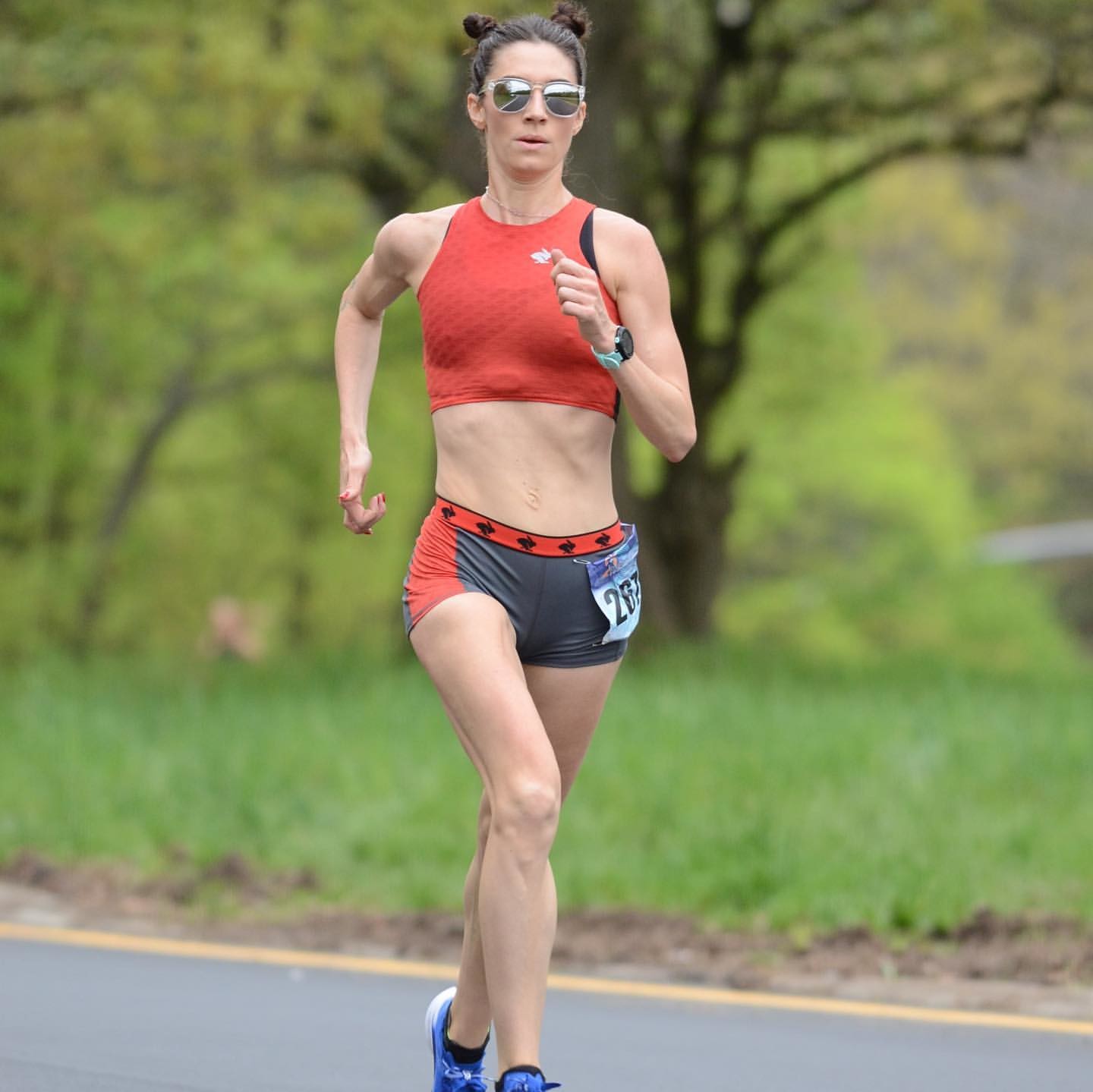
Although somewhat new to marathon racing, Russo’s running story actually began as a high schooler in East Stroudsburg, PA, where she was a sprinter and hurdler – and good enough to still hold some local records and a spot in her high school’s Athletic Hall of Fame. She continued her passion at Dickinson College where she ran both track and cross country, and where she would take the class that would open the door to her future career.
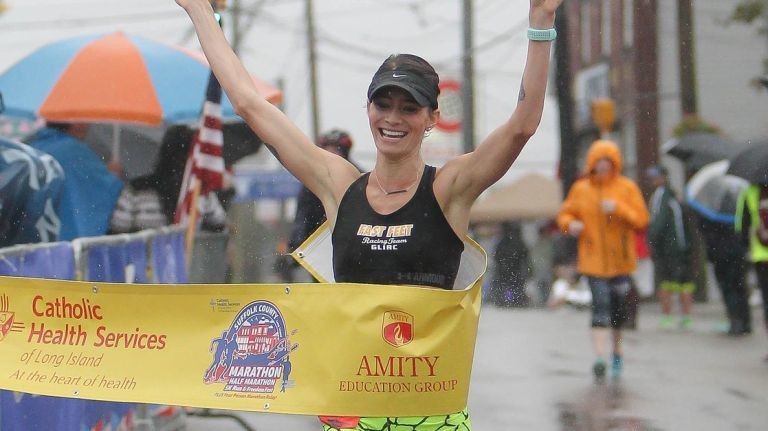
“I always had an interest in anatomy,” said Russo. “Sophomore year I found my way into an Introduction to Biological Anthropology class and that was it — from that point on there was no plan B.”
Though it set her on the path to what would become her career, the epiphany would also take her off the road. Russo would take nearly a decade off from running as she pursued graduate school, earning her PhD at the University of Texas at Austin in 2013, completing two post-doctoral positions, and then joining the Stony Brook faculty in the Fall 2014 semester. She initially lived in bustling Manhattan and then Queens, but eventually moved to the more open spaces of Long Island. Once there, she quickly joined the nearby Sayville Running Club and dusted off her running shoes.
“Running is almost spiritual to me, it gives my life something that nothing else can,” she said. “It can also be a form of relaxation and meditation, which certainly served me well through my first year in a tenure-track position.”
Seeking to push herself even further, Russo began competing in ultramarathons – which are any races longer than a typical 26.2-mile marathon. She would eventually complete a 50-mile ultramarathon (the JFK 50), finishing sixth overall in the women’s division. It was after that remarkable achievement that she set her sights on the 2020 Olympic Trials and earned a spot on her running team, Rabbit. Her training as a scientist would come to play an important role.
Login to leave a comment
2028 US Olympic Trials Marathon
Most countries around the world use a selection committee to choose their Olympic Team Members, but not the USA. Prior to 1968, a series of races were used to select the USA Olympic Marathon team, but beginning in 1968 the format was changed to a single race on a single day with the top three finishers selected to be part...
more...Your guide to this year's Prefontaine Classic
The Prefontaine Classic relocated, temporarily, and it brought the best fields of the Diamond League season with it to Stanford, California on Sunday June 30.
That includes the world’s fastest man and woman this year (Christian Coleman and Elaine Thompson), the athlete who has made the most worldwide headlines this season (Caster Semenya) and a bevy of other reigning Olympic and world champions.
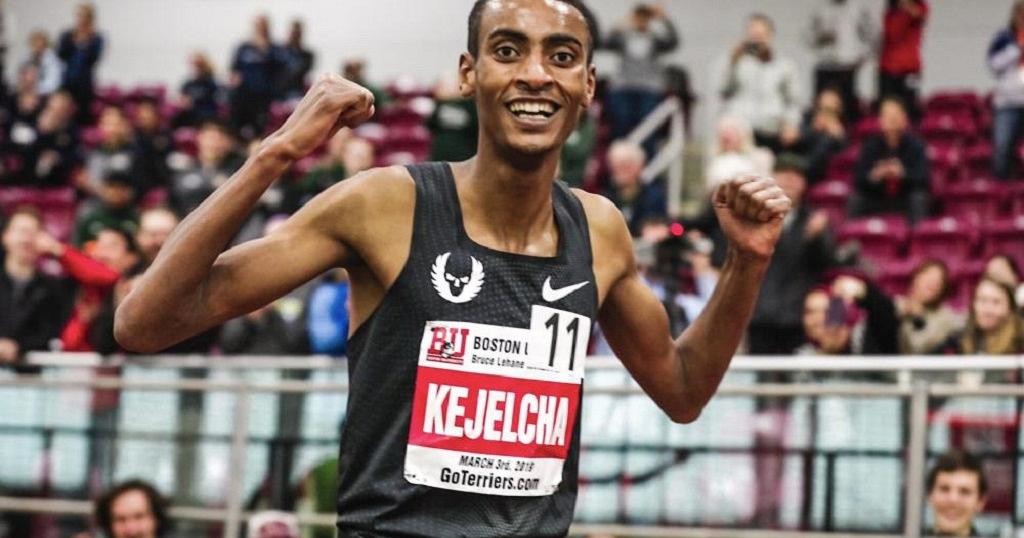
Notably, Olympic 10,000m champion Almaz Ayana of Ethiopia and Olympic 1500m champion Faith Kipyegon will compete for the first time since 2017. World 100m champions Justin Gatlin and Tori Bowie are in their first Diamond League meets in more than one year. It’s the first Diamond League in two years for 2008 Olympic 400m champ LaShawn Merritt. It’s also the first race of 2019 for Olympic 1500m champion Matthew Centrowitz.
NBC and NBC Sports Gold air live coverage Sunday from 1-3 p.m. Pacific.
The Pre Classic has been held annually since 1975 in Eugene, Ore. But Hayward Field’s reconstruction ahead of the 2020 Olympic Trials forced a move to Cobb Track and Angell Field at Stanford.
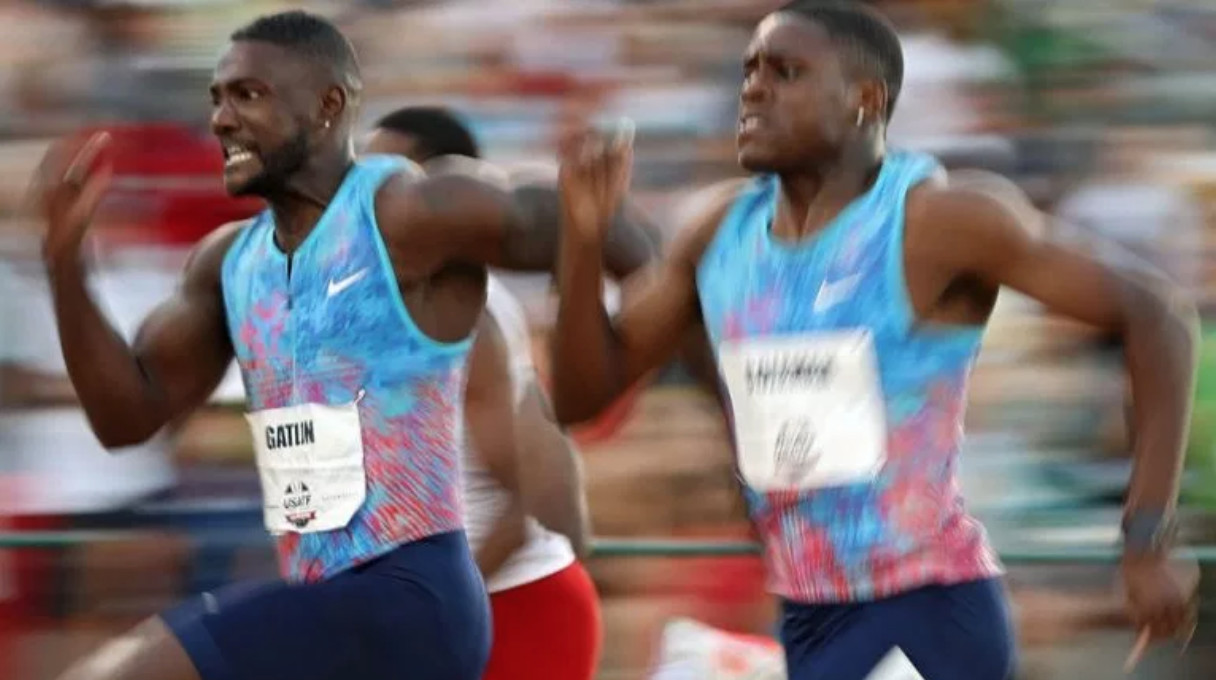
Here are the Pre Classic entry lists. Here’s the schedule of events (all times Pacific):
Here are 10 events to watch:
Men’s Pole Vault — 12:43 p.m.The Big Three of the event meet for the first time this season: 2012 Olympic champion and world-record holder Renaud Lavillenie of France, 2017 World champion Sam Kendricksand 2018 and 2019 world leader Mondo Duplantis of Sweden, who just turned pro after his freshman year at LSU. Lavillenie has competed just once this season due to injury. Duplantis was beaten at NCAAs by Chris Nilsen (also in the Pre field). But Kendricks has been hot, winning the first three Diamond League pole vaults this season (though Lavillenie and Nilsen weren’t in any of those fields and Duplantis just one).
Women’s High Jump — 1:08 p.m.U.S. champion Vashti Cunningham takes another crack at Russian Mariya Lasitskene, who has just two losses in the last three years. Cunningham is 0-7 versus Lasitskene but has this spring already bettered her top clearance of 2018. Lasitskene, though, appears in top form after taking three attempts at a world record 2.10 meters in Ostrava last week.
Women’s 3000m Steeplechase — 1:11 p.m.Six of the eight fastest in history, headlined by world gold and silver medalists Emma Coburn and Courtney Frerichs. The only time either Coburn or Frerichs won a steeple that included any of the four fastest Kenyans in history was at those 2017 Worlds. Another chance Sunday.
Women’s 100m — 1:27 p.m.NCAA champion Sha’Carri Richardson would have been the favorite here in her pro debut if not for what happened Friday. Shelly-Ann Fraser-Pryce, a two-time Olympic 100m champion, clocked her fastest time in six years (10.73 seconds) to become the fastest mom in history and No. 2 in the world this year behind Rio gold medalist Elaine Thompson. Also watch reigning world champ Tori Bowie, who is coming back from a quad tear and coaching change.
Women’s 800m — 1:47 p.m.Caster Semenya races her trademark event for the first time since a Swiss Supreme Court ruled her eligible while it deliberates on her appeal against a Court of Arbitration for Sport decision to uphold an IAAF rule capping testosterone in women’s events from the 400m through the mile. The Swiss court ruling applies only to Semenya and not the other Rio Olympic medalists, Francine Niyonsaba and Margaret Wambui, who are also affected by the new rule. So Semenya’s closest threat at Pre is American record holder Ajeé Wilson, but Semenya has won 30 straight 800m races dating to 2015.
Men’s Shot Put — 2:01 p.m.Olympic champion Ryan Crouser had a sterling record at Hayward Field, taking NCAA, Pre Classic and Olympic Trials titles. He’s pretty strong in California, too, recording his personal best (22.74 meters) in Long Beach in April. Nobody has been within a foot and a half of that this season, but the last two world champions (New Zealand’s Tom Walsh and American Joe Kovacs) will try to snap his undefeated 2019 on Sunday.
Men’s 400m — 2:19 p.m.Lost some sizzle with the withdrawal of 2012 Olympic champion Kirani James, who has missed time with Graves’ disease and, more recently, his mother’s death. Instead, the three fastest Americans of the last decade line up — 2018 and 2019 world leader Michael Norman (43.45 from April 20), 2017 world No. 2 Fred Kerley and 2008 Olympic championLaShawn Merritt.
Women’s 200m — 2:25 p.m.Strongest sprint field of the meet: 2016 Olympic champion Elaine Thompson, 2015 and 2017 World champion Dafne Schippers and 2018 world leader Dina Asher-Smith. Should produce the fastest time in the world this year, which is currently 22.16, and the favorite for world champs.
Men’s 100m — 2:39 p.m.Justin Gatlin and Christian Coleman go head-to-head for the first time since the 2017 Worlds, where Gatlin took gold, Usain Bolt silver and Coleman bronze. Coleman is the world’s fastest man this Olympic cycle (9.79) and this year (9.85). Gatlin, 37, hasn’t broken 10 seconds since beating Bolt but has a bye to defend his title in Doha in September.
Men’s Mile — 2:51 p.m.Olympic 1500m champ Matthew Centrowitz races on the track for the first time since July 22, eyeing his first win in the Pre mile in his sixth try. The foes are formidable, including the top two milers since Rio — Kenyans Timothy Cheruiyot and Elijah Manangoi — Norwegian brothers Filip and Jakob Ingebrigtsen and Ethiopian Yomif Kejelcha, who on March 3 broke the 22-year-old indoor mile world record. Nobody has been within four seconds of the outdoor mile word record (Hicham El Guerrouj‘s 3:43.13 in 1999) since 2007.
Login to leave a comment
Prefontaine Classic
The Pre Classic, part of the Diamond League series of international meets featuring Olympic-level athletes, is scheduled to be held at the new Hayward Field in Eugene. The Prefontaine Classicis the longest-running outdoor invitational track & field meet in America and is part of the elite Wanda Diamond League of meets held worldwide annually. The Pre Classic’s results score has...
more...Ex-All-American Joseph Whelan goal is to qualify for the Olympic marathon trials
Joseph Whelan, 38, a high school All-American in 2008, is training for the Grandma’s Marathon on June 22 in Duluth, Minn., and aims to run his goal marathon pace of 5:05 per mile up to 18 miles in Buffalo first.
“I’m going to try to do a workout inside of the Buffalo marathon,” said Whelan, who lives in Spring Branch, Texas, where he is a construction site supervisor. “I’m going to try to win, but it makes sense for me to come home, get out of the heat and get a nice, long effort in, before I have another big marathon.”
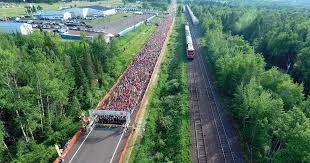
Joseph began running marathons a little more than two years ago. Whelan ran cross country and track at Syracuse, but after he graduated in 2014, he focused on relocating and starting his career. When he told people he was a runner, other hardcore runners asked two questions of him: What’s your mile time? What’s your marathon time?
“I took a couple years off after college, not competing, but I’d run all through middle school, high school and college, and it felt like I was obligated to run,” Whelan said. “In 2017, that was the first year that I really thought, ‘I need to put something on the table and do something other than work.’ I needed to run a marathon to say that I’m a runner, and that became my New Year’s resolution in 2017.”

Whelan, who was third in the Buffalo YMCA Turkey Trot in November, is now preparing to qualify for the 2020 Olympic Trials next year in Atlanta. The qualifying time for the 2020 marathon trials is 2:19; Whelan aims to complete the 26.2-mile course in less than 2:13.48.
“I enjoyed the training and the buildup for a marathon, and I thought, hey, if I can focus on this, I can do really well in a marathon. Eventually, I want to do the marathons in Chicago, Boston and New York. They’re the big ones.”
Login to leave a comment
Grandmas Marathon
Grandma's Marathon began in 1977 when a group of local runners planned a scenic road race from Two Harbors to Duluth, Minnesota. There were just 150 participants that year, but organizers knew they had discovered something special. The marathon received its name from the Duluth-based group of famous Grandma's restaurants, its first major sponsor. The level of sponsorship with the...
more...America’s Amy Cragg is set to race the Prague Half on Saturday
Success for reigning USA Olympic Trials Marathon champion Amy Cragg did not come easily or quickly. Indeed, the 35 year-old Nike Bowerman Track Club athlete nearly quit the sport before her true talent really showed through, eventually carrying her to Olympic Trials wins in both 2012 (at 10,000m) and 2016 (marathon), four USA titles, and a 2:21:42 marathon personal best. It’s been a long, and sometimes bumpy, road.
“Definitely, I’ve made some mistakes along the way,” Cragg told Race Results Weekly in a telephone interview from Prague where she’ll be running the Sportisimo Prague International Half-Marathon on Saturday. “I’ve learned from them and that’s kind of led me to here. So, every once in a while I’ve looked back and I’m, like, I should have done this differently or this differently. But, the reality is that I might not have ended up here. I think I’m in a really good place.”
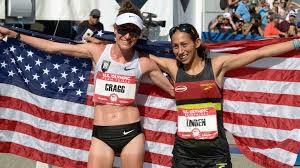
Working with coaches Jerry Schumacher and Pascal Dobert and Bowerman teammate Shalane Flanagan since the end of 2015, Cragg has blossomed into one of America’s best at 26.2 miles. After winning the February, 2016, Marathon Trials on a brutally hot day in Los Angeles, she went on to finish ninth in the Olympic Games Marathon in Rio.
She backed up that performance a year later with a thrilling, late-race charge at the 2017 IAAF World Championships marathon in London, taking the bronze medal (the first medal for a USA woman at those championships in the marathon since 1983), and only missing the silver by a fraction of a second.
She recovered from her London race well, then ran the Tokyo Marathon in February, 2018, finishing third in an excellent 2:21:42. That performance made her the fifth-fastest American of all time behind only Deena Kastor, Jordan Hasay, Flanagan and Joan Samuelson.
"I love where I’m at,” Cragg continued. “I love my team and my coach. Just living in Oregon, that’s been incredible. I think overall, those rough moments, those times when I considered stopping have made me a stronger athlete. I’m glad I went through that. It’s hard to say that. Those times, I think I really learned a lot from them.”
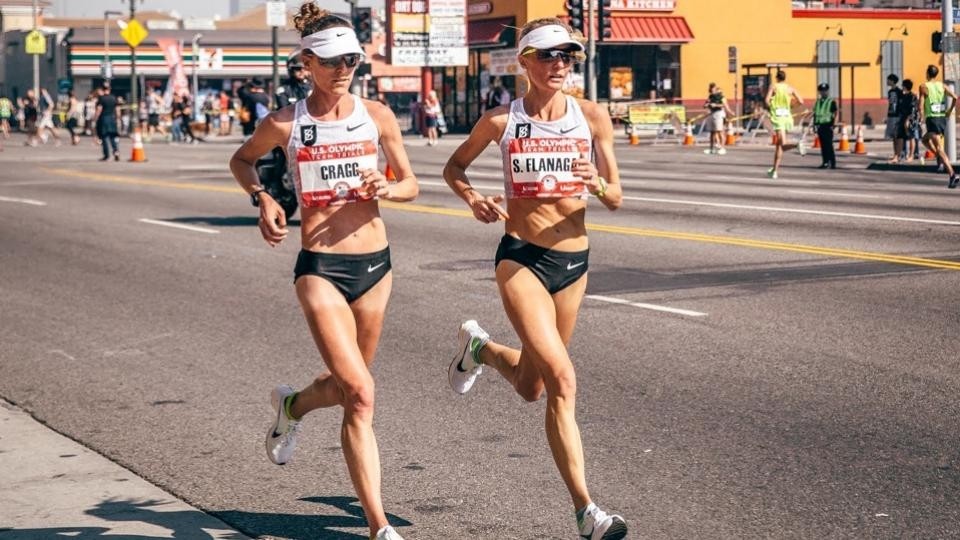
Cragg is at an unusual juncture in her career. She hasn’t run a marathon in over a year. She built-up for Chicago last October, but ended up withdrawing from the race after she and her coaches felt that her training hadn’t brought her to the fitness she would need to run her best. They had intense discussions, she said, about what to do next.
“When I pulled out of Chicago last year the big talk was, OK, what do we really want to get out of the next two years?” Cragg said. “I’ll probably be in the sport two years and reassess. The big thing is making another Olympic team and trying to perform well in Tokyo. Everything we do from here on out, that’s the goal to make that team and we’ve been working back from there.”
Cragg decided not to do a spring marathon this year. Instead, she worked with her Bowerman teammates Shelby Houlihan, Marielle Hall, Courtney Frerichs, and Karissa Schweizer to get ready for the USATF Cross Country Championships last February where she finished fifth in her first national cross country championships in nine years.
A month later she ran the special Road to Gold test event in Atlanta where she was able to run on the 2020 Olympic Trials course. Uncontested, she covered the 8-mile route in 43:23 and won by a minute. She told Race Results Weekly that the Atlanta race was essentially the kick-off of her Trials training.
“I felt pretty good,” Cragg said. “I think I’m in a good position and I’m pretty excited to get into the bigger miles. For me, that makes a huge difference. I feel ready to start that, which is exciting for me.”
Saturday’s race in Prague is the next logical step on Cragg’s long journey to Atlanta next February for the marathon trials and Tokyo for the Olympics next August. On Prague’s flat, record-eligible course Cragg wants to race hard with the goal of improving herself as a marathoner.
by David Monti
Login to leave a comment
Prague Half Marathon
Start the RunCzech season with one of the biggest running events in the Central Europe! Every year the Sportisimo Prague Half Marathon excites spectators with performances of elite athletes breaking records. Enjoy a course with incomparable scenery in the heart of historic Prague that follows along the Vltava river and crisscrosses five beautiful bridges. Take in majestic views of the...
more...Strong field is expected at the 68th Beppu-Oita Mainichi Marathon
After an exciting head-to-head battle last year that saw runners sub-2:10 PBs, Desmond Mokgobu from South Africa and Hayato Sonoda return to the Feb. 3 Beppu-Oita Mainichi Marathon.
The pair face not only each other but recent sub-2:10 men Hicham Laqouahi from Morocco, Ethiopian Abdela Godana, Hiroyuki Yamamoto, Daisuke Uekado, Kenyan Justus Kiprotich, Takuya Fukatsu, Kohei Ogino and Yihunilign Adane, and sub-62 half marathoners Keijiro Mogi, Charles Ndirangu and Shuho Dairokuno, setting up a better-than-average pack by Beppu-Oita standards.
For the Japanese men Beppu-Oita counts toward qualification for the MGC Race, Japan's 2020 Olympic Trials. Sonoda and Uekado have already made it along with fellow entrants Naoki Okamoto and Tomohiro Tanigawa, but for Ogino and others it will be just about their last chance. The basic rule is that anyone under 2:08:30 will qualify.
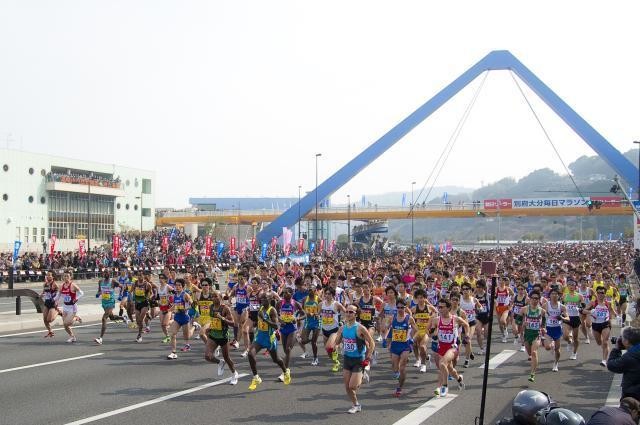
The top Japanese finisher not already qualified will join the list of qualifiers if under 2:11:00, with up to five more joining the list if under 2:10:00.
There's also the option of qualifying via a two-race average under 2:11:00 within the qualifying window. In Ogino's case that means a 2:12:24 will be enough, and Ryo Hashimoto also has the chance it make it that way by clearing 2:10:20. Japan's current #1 man in the 10000 m, sub-62 half marathoner Dairokuno will be making his debut alongside sub-61 teammate Mogi, and if either has a successful one he will be the first from three-time New Year Ekiden national champion Asahi Kasei's current roster to earn MGC qualification assuming Fukatsu or another teammate in Beppu-Oita doesn't get there first.
If they or others miss out there's the consolation prize of consideration for the 2019 Doha World Championships team, pretty much an either-or situation relative to the MGC Race.Beppu-Oita also has a small women's field. The heavy favorite is Haruka Yamaguchi, runner-up at last fall's Osaka Marathon and looking to break her 2:34:12 PB and hopefully the 2:33:00 CR set last year by Hiroko Yoshitomi.
Next-strongest is American Cate Barrett with a 2:43:40 on the aided California International Marathon course in December, but with Yamaguchi having tuned up for Beppu-Oita with a 2:42:39 training run effort at the Xiamen Marathon earlier this month it's clearly her race to lose.
Login to leave a comment
Beppu-Oita Mainichi Marathon
The Beppu-Oita Marathon is an annual men's marathon race that takes place every February between the cities of Beppu and Oita on the island of Kyushu in Japan. First held in 1952 as a 35km race, the looped marathon course begins at the bottom of Takasaki Mountain and reaches Beppu's Kankoko International Port before turning back towards the finishing point...
more...No Japanese Women Runners qualify for Olympic trials at the Saitama Marathon
Marie Imada finished fourth for Japan's best performance in the Saitama International Marathon on Sunday, failing to meet the qualifying standards for the Marathon Grand Championship, 2020 Olympic trials.
In the race won by 20-year-old Dalila Gosa of Bahrain in 2 hours, 25 minutes, 35 seconds, Imada clocked 2:29:35, neither making the top three and running under 2:29:00, nor finishing in the top six under 2:28:00 to earn a place in next fall's MGC Race.
Only eight women have met the qualifying standards so far for the MGC Race to be held Sept. 15 next year in Tokyo. The MGC is a race that will determine two of the three members for both the men's and women's marathon teams for the Tokyo Olympics.
On Sunday, Imada and Saki Tokoro fell behind the leading pack around the 23-kilometer mark, while the IAAF Race turned into a duel between Gosa and fellow Bahraini Shitaye Habtegebrel down the final stretch.
"I was able to win because I trained hard. I'm very happy," Gosa said. "I'd like to work more on speed and endurance, and be able to maximize my performance." Habtegebrel crossed the finish line at the Saitama Super Arena four seconds after Gosa, and Kenya's Sylvia Jebiwot Kibet took third in 2:28:38.
Mao Kiyota, who competed in the world athletics championships in London last summer, finished fifth in 2:31:07, and Tokoro came home sixth.
Login to leave a comment
Sarah Mulcahy fractured a hip in January 2017 and was told she´d never run again qualified for US olympic trials at CIM
Login to leave a comment
Olympic Trails qualifier, Karen Bertasso hopes to run well in Sunday's MVP Healthcare Stockade-athon 15k
Login to leave a comment
National record holder Yuta Shitara and Yuki Kawauchi are running the Fukuoka Marathon
Login to leave a comment
Here is why the USATF reopened the bids for the U.S. 2020 Olympic Trials
by Ken Stone
Login to leave a comment
Tracktown USA hopes to be selected to host the USATF 2020 Olympic Trails
Login to leave a comment
The USATF finally realized they need to find a new host for the U.S. 2020 Olympic Trials
Login to leave a comment
Kate Landau win's Eugene Marathon after being forced to drop out of Boston
Login to leave a comment
Don’t make plans just yet to attend the USATF 2020 Olympic Trials at Mt Sac
Login to leave a comment
Olympic Trials Trouble: Let's make Eugene the permanent Trials host site
by Mike Fanelli
Login to leave a comment
Knoxville marathon mom qualifies for 2020 Olympic trials while juggling family obligations
Login to leave a comment
Is Atlanta going to be the site of the 2020 US Olympic Team Marathon Trials?
Login to leave a comment


